Thirdeyemom
Traveling the world and doing good, self-guided walking tour of prague: a complete 2-3 day itinerary.
While Paris has always been my first love, little did I know that I’d also fall madly in love with the old world charm and beauty of Prague. In my opinion, few cities in the world compare to the magical architecture of these two cities, both equally adored in my eyes. I first saw Prague while I was living and studying abroad in Paris back in 1993, just four years after the Velvet Revolution. With over 40 years of communism, much of Prague’s beauty had been shroud in mystery and wasn’t unveiled for the world to see until 1989 with the fall of communism.
Prague’s history is long and deep which makes this charming city even more fascinating. Founded around the end of the 9th century at the crossroads of Europe, Prague became the seat of the Kings of Bohemia with a thriving marketplace alongside the River Vltava. Feuding kings, bloody wars, and the building of the Old Town Square surrounding the immense Prague Castle defined this prospering city that reached its glory in the 14th century during the reign of Charles IV. Charles IV commissioned the building of New Town, the spectacular Charles Bridge, the Gothic masterpiece Saint Vitus Cathedral and the Charles University, the oldest in Central Europe. Thanks to Charles IV, the “golden age” inspired much of the beauty you see in Prague today.
Table of Contents
Today, Prague relishes as one of the top major tourist destinations in all of Europe where people from all over the world come to take a step back in time and marvel at this masterpiece of architectural delight. Prague’s multi-layered history of architecture takes us back to her founding 1,100 years ago in the Romanesque era to her flourishing by the Gothic, Renaissance and Baroque eras, all within 3.34 square miles.
With only 1.3 million inhabitants, Prague sometimes can feel overrun with tourists blocking its tiny, winding cobblestone streets and filling up its squares. But despite the hordes of tourists, the magic of this city is spellbinding and is bound to take your breath away.
The best time to go to Prague if you want to avoid tourists yet take a little bit of a chance on weather is during the shoulder season meaning either Spring or Fall. We went in early May and had fairly good weather with a little spring rain. It wasn’t too unbearably crowded or hot like it gets during the busy summer months. I imagine September would be lovely in Prague.

Neighborhoods to See
Prague is made up of five independent municipalities: Hradčany (Prague Castle), Lesser Town (Malá Strana), Old Town (Staré Město) and New Town (Nové Město) and Josefov (the Jewish district) was added in 1850. Although Prague was one of the few European cities untouched by WWII, the Nazi occupation lead to the demise of the Jewish population who either fled or were killed in the Holocaust. The Germans who had formed the largest ethnic group in the city were expelled after the war. Then came 40 years of communism followed by freedom and an opening to the world.
In this guide, I will focus on the top touristic neighborhoods to see first for old world charm and architectural bliss: Malá Strana (Lesser Town), Old Town (Staré Město), Malá Strana (Lesser Town), and Hradčany (Prague Castle). We stayed in Nové Město (New Town) which despite its name, is not new as it was founded in 1348 by Emperor Charles IV to link Old Town with other parts of Prague. There is plenty to see in Nové Město as well in terms of stunning architecture, the Wenceslas Square, department stores, shops, restaurants and more. Another district you must visit is Josefov, Prague’s old Jewish ghetto filled with beautiful synagogues, an old Jewish cemetery and the Jewish Town Hall. We only had time to briefly visit the Old New Synagogue ( Staronová synagoga ), one of the oldest and most valuable European and world Jewish monuments, and the oldest synagogue in Central Europe. We simply ran out of time. I would highly recommend spending at least half a day in Josefov if not more. If you like to shop, then you could also easily spend a half to full day in New Town as well. The itinerary below is meant for at least 2-3 full days to explore at a leisurely pace.

Prague at sunset on the Charles Bridge.
Staré Město (Old Town)
Old Town Square
Prague is a delightful city to explore on foot with its extraordinary architecture, charming cobblestone lanes and enchanting churches, squares and buildings. Prague’s rich history can be seen upon every building, decorative windowsill, doorway and even through a layer of chipped paint. Founded near the end of the 9th century at the crossroads of Europe, “Praha” or the “doorstep” became the seat of the Kings of Bohemia with a thriving marketplace alongside the River Vltava in what today is known as Old Town Square. Merchants and craftsman from all over the world would meet here to trade and by 1234 Prague’s Staré Město “Old Town” was founded.
Old Town revolves around Old Town Square which is laced in history and architectural genius and remains the historic heart and the soul of the city. Many believe it is the grandest, most magnificent square in all of Eastern Europe with its intricate pathways of cobblestone streets reminiscent of medieval times and its brightly-hued pastel buildings each with a history of its own right.
Every way you turn, there is an architectural treasure as one building seems to outshine the next. The styles of architecture range from Romanesque (characterized by semi-circular arches that was prevalent in medieval Europe) to Gothic (with its characteristic pointed arches, ribbed vaults and the flying buttress that occurred after the Romanesque period in the 12th century) and Baroque (began in the late 16th century and includes dramatic use of light, oval shapes, grandeur and large ceiling frescoes).

What makes Old Town and much of Prague itself so utterly spectacular is that much of its treasured architecture from medieval times remains untouched by war or natural causes. There were floods that inundated the city in Medieval times that caused immense destruction but architects simply built over and restored the buildings in a new style of architecture. Many buildings of Gothic style were restored with Baroque facades.
As you enter Old Town, the first thing you see and pass through it the Powder Gate. Built in the 11th century, the Powder Gate was one of 13 entrances into Prague’s Old Town and still stands tall today. It was reconstructed in 1475 during the reign of King Vladislav II in 1475.

The Powder Gate

Walking through the gates, feels like stepping back in time. Despite the masses of people and tourists, if you look up and peer at the stunning, elaborate buildings you are bound to be awestruck by their pure magnificence. Several walking tours and guide books will give you detailed history on each building because of course every single one has a story. Also pay close attention to the detail of the doors, windows and the unique signs decorating each building. You could literally spend hours just walking around Old Town Square.

It is best to get up and going early in order to beat the crowds of tourists. These photos above were taken in early May before noon. By lunch time, the square is typically filled with people enjoying the sights and dining at one of many outdoor restaurants and cafes.

A must-see in Old Town Square is the Astronomical Clock. It is the oldest and most elaborate functioning astronomical clock in the world and a main attraction in the square especially on the hour when you can watch “The Walk of the Apostles”, a moving procession of the 12 Apostles. The first clock was built on the town hall building at the beginning of the 15th century and was completely operational by 1572.

Another experience that cannot be missed is to climb the Bell Tower at the Town hall for an amazing bird’s-eye 360 degree view of Prague. It is definitely worth the effort! On a clear day, you can see for miles on end and get some spectacular photos. The views on a cloudy day are still impressive.

There are two magnificent churches that dominate Old Town Square. St. Nicholas’ Church is at one end and the Church of Our Lady before Týn at the other side of the square. Both are equally impressive and quite different in architectural style and design. The Church of Our Lady before Týn is what you would envision of medieval Prague with its spectacular Gothic style. The church was built from the mid-14th to the early 16th centuries and the Baroque interior replaced its Gothic roots at the end of the 17th century.

View of the soaring Gothic Church of Our Lady before Týn
Nearly every building in the square is absolutely exquisite. The colors and decoration are extraordinary and it is hard to stop taking pictures of them. You could literally go building by building and admire each one while looking for its unique decorative sign.

On the other side of the Town Hall and Astronomical click lies the lovely Baroque Saint Nicolas’ Church. Completed in 1735 replacing an original church dating back to 1273, the interior of St. Nicholas’ Church is a masterpiece with stunning ceiling frescoes, pearl white stucco walls and a 2,500-pipe organ that fills the room with sound. If you have time, buy a ticket to attend an evening concert at the church and it will not disappoint. Gaze up at the beautiful ceiling while the melodic music bounces off the walls and arches of the church, and you will be in awe.

St. Nicholas Church

Entrance to St. Nicholas Church
The south side of Old Town Square displays an array of gorgeous Romanesque and Gothic buildings that are filled with mystery. Some host restaurants at the bottom that date back hundreds of years. There are even hidden wine cellars in the basements.
The Storch House is perhaps the most elaborate in the row which has a 19th century painting of St. Wenceslas an horseback. St. Wenceslas was a duke of Bohemia from 921 until his assassination in 935 and continues to play an important role in Prague’s history.

Storch House
As I walked around the square and continued my exploration to other parts of Old Town, I was mesmerized by how much beauty surrounded me. I loved every single building and could never consider a favorite. It amazed me that such a place continues to exist in today’s modern world. ( Want to read more? Check out my post “A Walking Tour of Prague: Old Town Square” ).
Charles Bridge to Malá Strana (Lesser Town)
There is no bridge in Prague that is more symbolic than the sensational Charles Bridge ( Karlův most) . Completed in 1402 by court architect, Peter Parler, the iconic Charles Bridge is a feat of medieval engineering that was the only link connecting Old Town and the Prague Castle across the River Vltava, for over 400 years. Lined with a never-ending collection of magnificent baroque statues against the awe-inspiring backdrop of the Prague Castle and terra-cotta rooftops of Malá Strana (Czech for “Little Quarter” or “Lesser Town”, the Charles Bridge is a must-see for any visitor to the city.
The Charles Bridge was built to replace the earlier “Judith Bridge” that was destroyed by one of Prague’s notorious floods and was commissioned by the Holy Roman Emperor, Charles IV, in 1357. The bridge was originally named the “Stone” or “Prague” bridge but was renamed the Charles Bridge in 1870 as a tribute to the leader who transformed Prague into imperial glory and greatness. Charles IV selected German-Czech architect Peter Parler to design and build the Charles Bridge. Parler had also designed the stunning Saint Vitus Cathedral at the Prague castle, another famous landmark. The Charles Bridge played a critical, strategic role in linking the castle to the rest of the town and until 1841 the Charles Bridge was the only link between the two halves of the city.

View from Charles Bridge of the Prague Castle and the St. Vitus Cathedral
At each side of the bridge stands two enormous gothic gateways – “Old Town Bridge Tower” and “Little Quarter Bridge Tower”- that instantly sweep you into medieval times. The entire length of the bridge is adorned with 30 statues erected between 1683 and 1714, mostly of Baroque architectural style and featuring various saints and patron saints who were important at the time. Charles IV commissioned the most prominent Bohemian sculptors of the time to create the works of art.
As you leave Old Town meandering through the winding cobblestone streets, you know you have arrived at the Charles Bridge when you see the massive Old Town Bridge Tower standing proudly before you. Built at the end of the 14th century, the tower was an integral part of Old Towns fortifications. You can enter the tower and apparently get a magnificent view of the Prague Castle but we didn’t have time. I am sure it would have been stunning and worth the visit.

The Old Town Bridge Tower also contains some beautiful sculptures by Peter Parler

A spectacular view of the Charles Bridge as seen by boat cruise.
The Charles Bridge is 1692 feet (516 m) long and contains 16 pillars, 30 beautiful sculptures, and three bridge towers. Every single statue of the 30 that line the bridge are awash with history and significance. It is pretty amazing! ( To see more of the statues, check out my post “Prague: A Walk across the Charles Bridge to Lesser Town” ).
This slideshow requires JavaScript.
You can’t cross the Charles Bridge without stopping at the most beloved tourist spot (see photo below) . Legend says that if you touch the brass figurine of St. John of Nepomuk whatever you wish will come true. Of course the brassy figurine was well-worn with hands. Apparently this is the place where he was thrown into the water in was in 1393. I couldn’t resist rubbing his belly and wishing for the lofty goal of world peace.

Malá Strana (Lesser Town)
As you cross the iconic Charles Bridge, you arrive in Malá Strana or “Lesser Town , a charming, picturesque part of Prague that peacefully lies beneath the Prague Castle and is known for its delightful winding cobblestone streets, its array of lovely restaurants, shops and cafes, its beautiful buildings and homes, and best of all, its lack of crowds giving this part of town a quieter, peaceful feeling.
Despite it’s name “Lesser Town” (Malá Strana is also referred to as the Little Quarter), Lesser Town is by no means a less beautiful or fascinating place to explore. In fact, it got its name because it was originally the smaller part of town where the king lived which in those days was away from the hustle and bustle of the Old Town markets and square.

View from Bell Tower looking towards Lesser Town.
Slowly the crowds dissipate and you can wander the charming eighteenth century cobblestone streets – many of them tucked behind gorgeous buildings and jetting uphill – in lovely solitude. In many ways, you will find Lesser Town to be Prague’s most enchanting part of town. Despite its intimate size of only 600 square meters, it is easy to get lost within its narrow streets and loose the hordes of people in Old Town. Home to such gems as the Church of St. Nicholas, the Little Quarter Square, the Kafka Museum, Petrin Park, and the Wallenstein Palace and Garden (which sadly was closed when we were there for a private event), you could easily spend a late afternoon or evening enjoying this intimate neighborhood.
We only had a short amount of time as we strolled up to visit the Prague Castle and St. Vitus Cathedral before the crowds arrived. Yet I was still able to capture a feel for Lesser Town’s eternal beauty of rich Baroque architecture, red tiled rooftops and exquisite grand homes and of course I easily fell in love with it.

Like other parts of Prague that often suffered from terrible floods, Lesser Town had its own set of issues and a huge part of the area was destroyed by a massive fire in 1541. After the Protestants were pushed out of the area in the early 1600s, a powerful group of Catholic nobility took over and began building the exquisite grand palaces and homes you can still see today. In fact, hardly any new building has occurred in Lesser Town since the late 18th century making this part a highly, sought-after place to live. Many of the old mansions have turned into embassies and flats.
The lovely Nerudova Street is a place that cannot be missed in Lesser Town for viewing its elaborate array of house signs. Named after the famous Czech poet Jan Neruda who lived at the house called “At the Two Suns” (number 47), Nerudova Street has perhaps the most fascinating decorative house signs in all of Prague. House signs were used until 1770 when a new way of house numbering was introduced in the city. However, many house signs remain as part of the beautiful decor today like this one below named “ The Three Fiddles”.

The Three Fiddles acquired its house sign and name in 1700 as it belonged to a family of violin makers.

View of the cupola and bell tower of the church of St. Nicholas in Lesser Town.
We didn’t have time to go inside the church of St. Nicholas but apparently it is definitely worth the visit with its extraordinary frescoes, paintings and sacred statues. It took 100 years and three architects to complete the masterpiece.
If you continue on towards the hill up to the Prague Castle, you pass one beautiful set of buildings after another. You could spend hours just admiring the architecture and lively colors of the homes. I was constantly looking up to catch it all on film. By the end of the trip, my neck was incredibly stiff but it was worth the effort.
A set of enchanting stairs lead you up to the Prague Castle affording stunning views of the city along the way. At the top of the stairs, is an entirely new world with the glorious French Gothic St. Vitus Cathedral and the Prague castle to explore.

The stairs leading up to the Prague Castle.
Hradčany (The Prague Castle)
Soaring majestically atop the hillside overlooking the glorious city of Prague, lies the Prague Castle ( Pražský hrad ) in the district of Hradčany. It’s stunning mass of spires, towers and palaces dominate Prague like a magical, fairy-tale fortress. Known as the largest ancient castle complex in the world, covering an area close to the size of seven football fields (70,000 square meters in length and 130 meters wide) this network of towers, churches, museums, halls, gardens and palaces is like a city in itself and is a must-see for anyone visiting Prague.
Scholars estimate that the Prague Castle was founded around 880 by Prince Bořivoj of the Premyslid Dynasty. It was also around this time that merchants from surrounding lands began trading in the area and formed a marketplace that would eventually become Old Town Square in the heart of Prague. The first building to be constructed in the Prague Castle was the church of the Virgin Mary which only has a few stones remaining today. Over the next couple of centuries, the immense complex of palaces and ecclesiastical buildings were constructed and modified in various kinds of architectural style, beginning with the 10th century St. George’s Basilica, the St. George Convent, the impressive St. Vitus Cathedral, and the glorious palaces and gardens.
Since its founding, the Prague Castle has held an important role in history as the seat of power for the kings of Bohemia, Holy Roman emperors, and presidents of Czechoslovakia. Today, it is the official residence of the President of the Czech Republic and has been opened up to the public since 1989.
You can reach the castle a number of different ways however we preferred to take the long hike up from Lesser Town on foot. Leaving Nerudova Street, we walked up the picturesque Malostranské náměstí to the top of the hill and the main entrance to the Castle. The views along the way were stunning and definitely worth the steep walk up.

Leaving Lesser Town and heading up to the Prague Castle.

The panoramic views of the brilliant, terra cotta rooftops of Lesser Town were stunning despite the threat of rain. You can get a real feel for how large Prague is and how much of it has remained relatively unchanged for centuries.

After a ten minute walk up the hill, you reach the Hradčany Square, the main square that surrounds the entrance to the castle. It is filled with musicians, street artists and traditional and not so traditional food for sale. There of course are also lots and lots of tourists.

The highlight of any visit to the Prague Castle is watching the Changing of the Guards. The Changing the Guards ceremony takes place in the first courtyard of the Prague Castle at 12 o’clock daily and is the formal handover carried out with marching, music and military precision. It is best to arrive early as the crowds and lines start forming around the Changing of the Guards making your visit to the cathedral and castle quite challenging.

Changing of the guards
To enter the Castle, you must pass through a gate adorned with sculptures of Titans, which were made by I. F. Platzer in 1770. Then you will have a series of three courtyards that take you through the inside of the Castle complex.

The masterpiece inside the Prague Castle is by far the glorious French Gothic St. Vitus Cathedral. The St. Vitus Cathedral is the largest and most important church in the Czech Republic and its chapels, frescos and spectacular stained glass make it one of the most incredible churches I have ever seen. (It is so magnificent that I dedicated an entire post to the cathedral) . Its construction took over a thousand years and its origins date back to the end of the 9th century.

Side view of St. Vitus Cathedral
You can easily spend an entire day visiting the castle, St. Vitus Cathedral and all the beautiful buildings around Hradčany. There is so much to see and so much history it is almost overwhelming. Since our time was limited, we did not do the castle tour but did tour the St. Vitus Cathedral and walked around Hradčany. I enjoyed taking photos of all the majestic buildings and palaces.
The weather in May can be unpredictable and it was clouding up again looking like it was going to rain. We cut out visit short and headed back to town feeling a little bit disappointed as I can only imagine how Hradčany would look with the sun shining down upon it. I’m sure the colors of the buildings would be brilliant.

Unfortunately we didn’t have time to walk through the Palace Gardens which are supposedly quite lovely and are a wonderful option for getting back down to the center of town. Instead, we returned the way we came and arrived just in time to have lunch at one of the many outdoor restaurants in Old Town Square (many which have umbrellas and even offer blankets to keep you warm in case of cool Spring weather or rain). I realized there are both good and bad things to going in the Spring. You chance the weather however beat the unbearable crowds (which were already getting to be annoyingly large by early May) and the scorching heat of summer. Maybe a Fall visit to Prague is in order.
Tips to Plan your Visit
The historical center and sites that every tourist must see in Prague is rather compact and is best suited for walking. But be forewarned, there are many cobblestone streets that are uneven and difficult on the bottoms of your feet so wear very sturdy and solid walking shoes. Your feet will hurt by the end of the day but thankfully there is an endless supply of outdoors cafes, restaurants and bars to rest your feet and watch the world go by.
To see all five neighborhoods of Prague, it will take at least three full days, and I highly recommend beginning right after breakfast before it gets too crowded. We began our walk in Old Town around nine o’clock and had the place relatively to ourselves until 11:30 when the tours began and the buses arrived. From noon on, expect massive crowds throughout the city until very late in the evening when the last of the partygoers crawls into bed.
There are many options for accommodations but I recommend staying in a central location as you will be doing a ton of walking. We stayed at the Hotel Salvator in Nové město (New Town) which is excellent, affordable, nice and only a ten minute walk to Old Town Square. I highly recommend this hotel.
Here are some great resources I found on planning your visit.
Prague Castle for Visitors (website gives you opening hours, map of the castle, information on each palace, ticket information and more).
My Czech Republic (website gives extensive history on the founding of the Prague Castle).
Rough Guides to Prague , 2015 edition, written by Marc Di Duca
DK Eyewitness Travel 2016 Prague, Vladimir Soukup
Discover Prague Guide – provided by most hotels in Prague
Radomira Sedlakova, author of Prague an architectural guide
Like this? Why not PIN for later?

I would love it if you shared!
20 comments.
So glad I visited in 1992 before all of the tourists discovered it! It wasn’t even on our list when my friend and I backpacked through Europe that summer, until other travelers told us Prague and Budapest were a must see! Both cities (particularly Budapest- I think because the weather was better) were the highlights of our trip on the continental part of the trip. Everything seems so crowded nowadays, so we try to visit places in the offseason- which means hitting the southern hemisphere or Caribbean for summer break- ha!
Yes the first time I went was 1993. I was backpacking through Europe then. It was really cool but I think I actually enjoyed it more this time with my older eyes. I also went to Budapest but that was way back in 1989 when I was with my parents. I’d love to go back there. Hope you are well! 🙂
Very nice photos–thank you for sharing!
Thanks so much for reading! 🙂
Wonderful photos. Yes, Prague is surprisingly charming. Haven’t been there after 1988, so I see a great deal of repairs and general fixing up.
Thanks for reading! The first time I was in Prague was 1993 and when I went back recently I was amazed by how good it looked. The paint on the buildings is bright and fresh, and it looks like they’ve done a lot of work to keep the city restored and gorgeous.
Great post and amazing photos. Takes me right back to our Prague trip a couple of years ago. Fascinating history too, glad to see a post that’s not all about the bridge.
Thank you so much! Yes we sure walked a ton on the trip. Next time I visit I want to explore the areas I missed. Thanks for reading!
Fabulous stuff, Nicole! 🙂 🙂 I’ve pinched it for my next Monday walk, though I’m not sure yet when that will be. Possibly New Year’s Eve. Have a fab time with the family, and all the best for next year!
Thank you Jo! Happy Holidays!
I think I will have to try Prague again. It certainly has beautiful buildings but I didn’t love the city on my visit 10 years ago. Your guide to Prague is comprehensive and makes it look inviting.
Thanks Debra! I first visited Prague in 1993 and thought it was pretty special yet it did not feel anywhere near as beautiful as this time around. It is crowded but I just really fell in love with the architecture and all the surprise details like the fascinating signs, the doorways and the mysterious insides of some of the places. It was even better to be there with my uncle who is a history professor so he was a fascinating guide for us as we walked the city.
Wow What A lovely place…..i love this place.
Yes it is pretty beautiful and so historic!
Thanks to Jo i really e joy this visual trip!!! Wonderful town!!! Wishing you a happy new year!!!!
Thanks for stopping by and checking it out! I am so glad Jo shared it! 🙂
One of the cities with historic significance in my bucket list. Thanks for providing such a wonderful article !! . Have been very curious to visit architectural marvel of our past. Had an opportunity to visit a UNESCO World Heritage Site HAMPI – The forgotten empire of 14th century. Sharing my thoughts about it below- https://acuriouseeker.wordpress.com/2019/01/06/historic-hampi-hippie-hampi/
Thanks so much! What a cool place you’ve visited. Thanks for sharing.
This walking tour of Prague looks awesome. How have I not been there yet????
Thanks so much! Yes, it is such a fabulous city! I just love all the incredible architecture. You have to go!
Leave a Reply Cancel reply
This site uses Akismet to reduce spam. Learn how your comment data is processed .
Discover more from Thirdeyemom
Subscribe now to keep reading and get access to the full archive.
Type your email…
Continue reading

Self-Guided Prague Walking Tour: One Day in Prague
Prague, the capital city of Czechia, or the Czech Republic, is a popular destination for travelers worldwide. Known for its stunning architecture, rich history, and vibrant culture, it is a city with something for everyone. Walk through its millennial history with this self-guided free Prague walking tour I perfected myself.
I studied in Prague for four years and would occasionally get family and friends visiting me. Therefore, I would always play a tour guide, showing them the best the city offers. Over time, I perfected the route to enable you to see the most iconic Prague landmarks within a day, leaving more time to enjoy other things such as shopping, nightlife, visiting its fascinating museums , or going on day trips , to name just a few. However, if you have more time, here’s your two-day itinerary for Prague to take it slower.
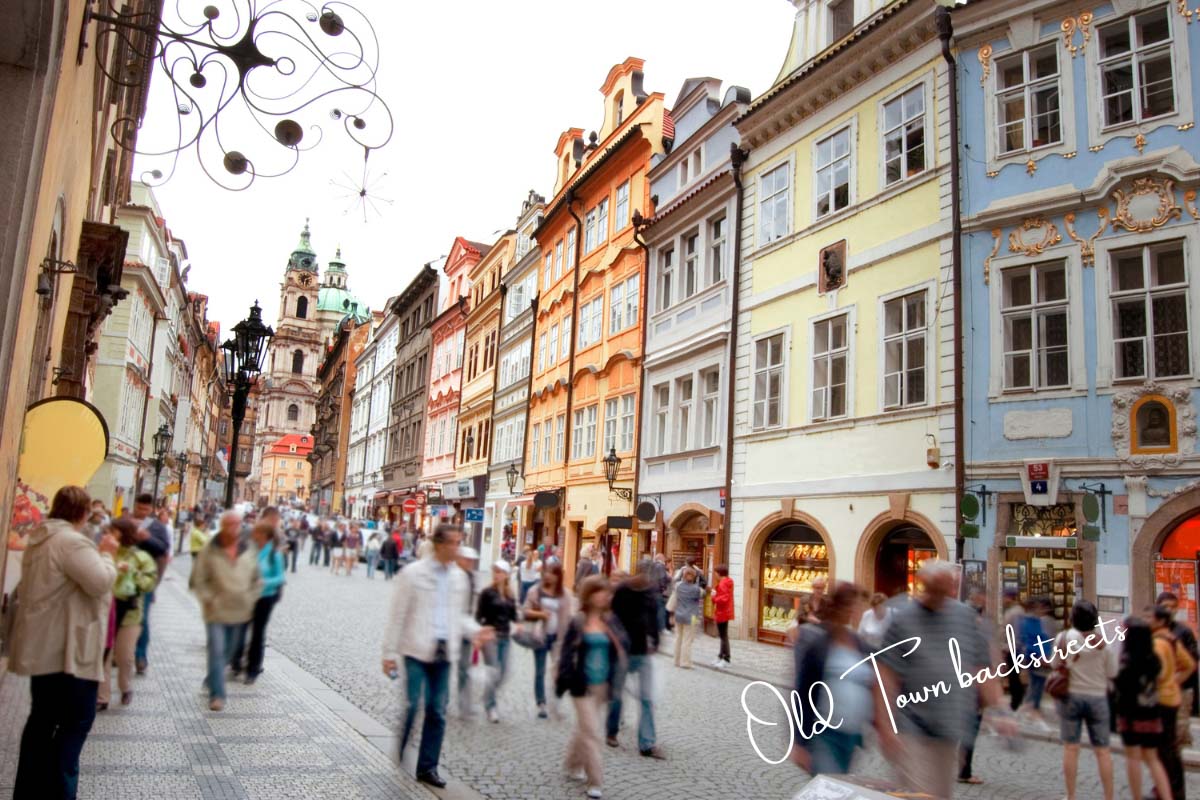
This Prague self-guided and free walking tour starts from Wenceslas Square, goes to Prague Castle by crossing the Charles Bridge, and returns to Old Town Square through the other side of the Lesser Town. The free tour takes you through the city’s major landmarks, public buildings, cultural venues, and places of worship.
This walking tour covers approximately 8-9 km of distance. You can easily make it your one-day Prague itinerary depending on when you start, your pace, and how long you stay in each location. The tour is flexible, so feel free to take a break or omit things that are of no interest to you.
Besides providing the route of the best Prague walking tour, this post also covers accommodation, the best time to visit Prague, and what to pack when planning your trip here. And if you prefer guided walking tours instead of this self-guided Prague tour, I list a few of my recommendations below, too.
My Travel Essentials
Get an eVisa: Check if you need one at iVisa and fill out the form to get your eVisa easily. Book a flight: Use Skyscanner or WayAway . The latter offers cashback with a Plus membership. More here . Airport transfers: Avoid the hassles of public transport; book a private transfer with Welcome Pickups . Reserve a hotel: Reserve your hotel or apartment at Booking.com . Find best-suited tours: For all sorts of tours, entrance tickets, and activities, check Viator or Get Your Guide . Rent a car: One of the best car rental aggregators with a wide choice of vehicles – DiscoverCars . Debit card: Wise for withdrawing money in local currency without hidden fees or high exchange rates. eSIM: To avoid heavy roaming fees, use Airalo or Saily . Compare prices and GB packages. Use BAIA2592 on Airalo and BAIAIR6152 on Saily to get 3 USD on both . Travel insurance: SafetyWing covers health insurance and has add-ons for adventure sports and electronics theft coverage.
This post includes affiliate links to products, which earn me a small commission at no extra cost to you. This helps to fund my blog and bring more authentic articles to you 🙂 Learn more
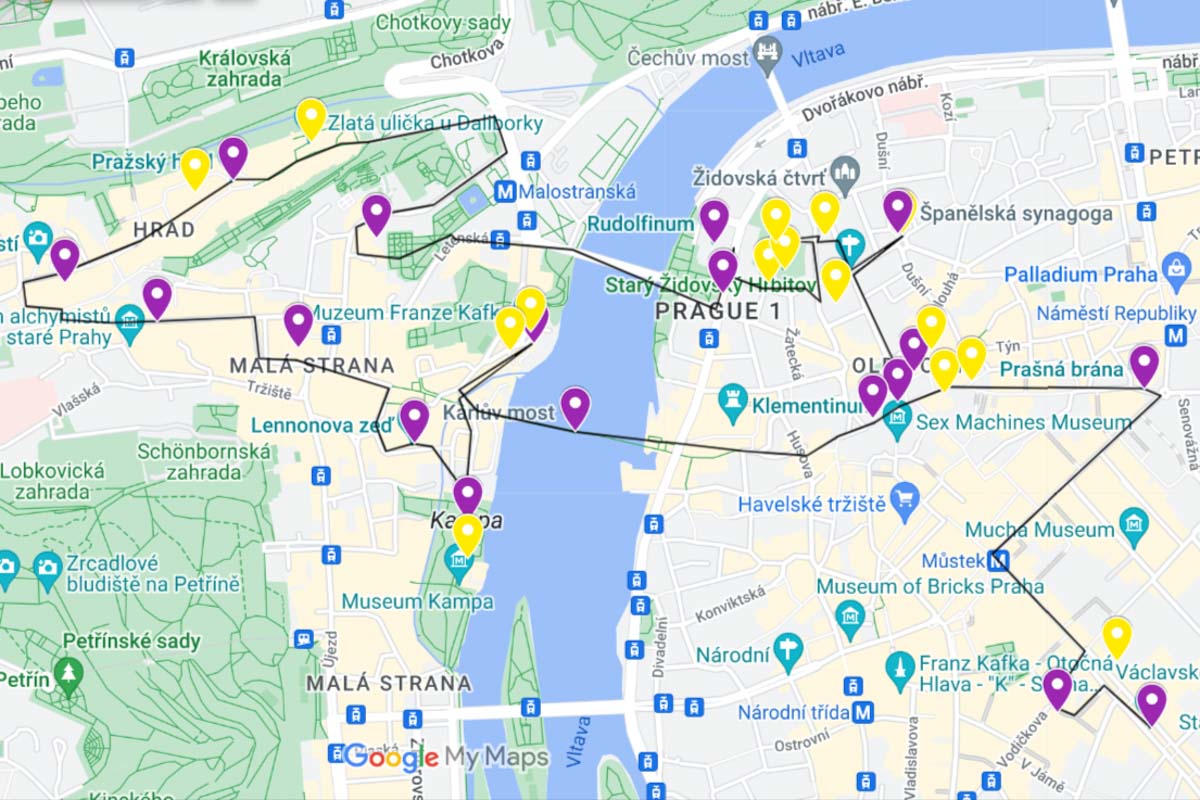
Prague walking tour map
For a more comfortable way of exploring the city and following directions, I have created a Prague walking tour map on Google Maps to save and use whenever you need it. The purple pins on the map mark the main stops on the walking tour, while the yellow pins are the significant locations that I explain within a territory.
Self-guided Prague walking tour
Wenceslas square.
Václavské náměstí, or Wenceslas Square, is one of the main areas of Prague and a place for many locals to meet. It has also been a landmark of many historical events, such as demonstrations, celebrations, and other public gatherings. Named after Saint Wenceslas, Bohemia’s patron saint, the area is more of a 750-meter boulevard than a square.

Charles IV first created it in the mid-14th century as a horse market in the New Town. Today, the St. Wenceslas Monument sits on top of the boulevard with the National Muzeum on its background.
Even though the square is old, the buildings lining up its street are not. The oldest dates back to the 18th century, and the others are much younger. Here, you’ll find gorgeous buildings of Art-Nouveau, Neo-Renaissance, Socialist Realism, and ultra-modernism buildings.
The square is also home to various hops, arcades, clubs, and theaters built during the early 20th-century commercial boom. While walking down towards Old Town Square, pay attention to Wiehl House and the Grand Hotel Europa for their impressive facades.
Upside-Down Statue of St. Wenceslas
The Art Deco-style Lucerna Palace hides a rather interesting sculpture of St. Wenceslas. Called King Wenceslas Riding on a Dead Horse, the monument is the work of the famous Czech sculptor David Černý. Some consider it a parody of a statue in front of the National Museum, but for some, it is an attack on Vaclav Klaus, President of the Czech Republic.
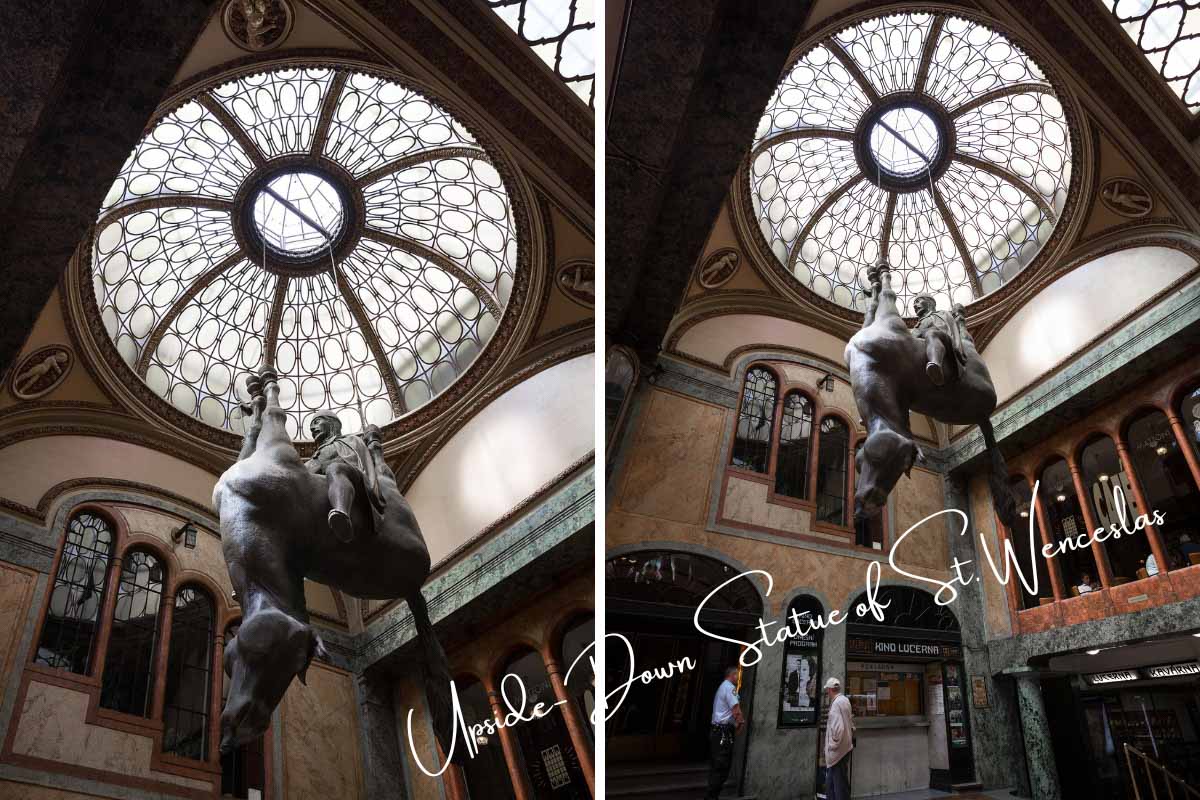
However, Černý never comments on this work; he does not need to honestly. If you see something extraordinary on your trip to Prague, like an old Soviet tank painted in pink floating on the Vltava, then you are a witness of Černys, another creation. Some of his other permanent art is also included in this walking tour of Prague.
Recommended tours in Prague:
The Powder Tower
Once you finish walking down Wenceslas Square, turn to Na Prikope Street to walk to the Powder Tower or Prašná Brána. This imposing Gothic tower is one of the original city gates out of 13. It was intended to be a nice-looking city entrance as an alternative to a defensive tower. The name comes from when the city initials used it to store gunpowder.
It was also used for the coronation ceremonies, during which the Kings of Prague would walk through it and follow the streets leading to Prague Castle. It was rebuilt in the 19th century after being destroyed during the Prussian siege 1757.
If you are up for a walk on a few dozen narrow stairs, you can go up on its viewing deck for some spectacular city views.
Right behind the tower is a breathtaking Municipal Hall to check out. And if you fancy a classical music concert, you can attend one here.
Astronomical Clock
From the Powder Tower, continue your walk on Celetná Street, one of the oldest streets in Prague, leading to the Old Town Square, or Staroměstské námesti. We’ll come back to the area at the end of this Prague walking tour, so instead, continue walking until you reach the Astronomical Clock.

Orloj, in Czech, is a medieval clock installed in 1410. It is considered the third oldest clock in the world and the oldest one that still works. The clock, built by Mikuláš Kadaň, a clockmaker, and Jan Šindel, an astronomer, attracts hundreds of tourists each hour (from 9 am to 11 pm) to watch a marvelous mechanical performance of 12 apostles greeting the city, a skeleton ringing a bell, a miser with a purse full of money, a Turk shaking his head, and Vanity looking in a mirror.
While looking at the clock, you can see the movement of the sun and moon through the signs of the Zodiac. It also tracks Sidereal time, Central European, and Babylonian times.
If you want to go inside the oldest town hall and see the Gothic chapel and staterooms, go down to the underground, and inner mechanism of the astronomical clock, you should book this tour .
House of the Minute
The House at the Minute is next to the Astronomical Clock as you walk on the Karlova Steet.

One of the undoubtedly impressive houses, it was initially a late Gothic building of the 15th century that was renovated into a Renaissance style in the mid-16th century.
White sgraffito (imprints scored on a flat plaster wall to make a three-dimensional effect of depth and shade) decorations on the black background are pretty impressive and tell the story of the Habsburg rulers and scenes from Greek mythology. It also references Renaissance and biblical legends.
Charles Bridge
This self-guided free Prague walking tour continues through Karlova Street again to reach the most famous and spectacular bridges I’ve seen – Karlov Most or Charles Bridge.

After floods washed away a few wooden and the first stone bridges, Charles IV decided to commission a new one in 1357. A 621-meter-long pedestrian Gothic bridge was the only means to cross the Vltava River until 1841; therefore, it was significant in connecting Prague Castle with the Old Town.
Guarded by three towers, the bridge boasts 30 statues and statuaries, primarily made in Baroque and Gothic styles. For spectacular views of each side of the bridge, you can walk up the stairs of the towers.
The bridge is a top-rated Prague attraction that brings many tourists, local musicians, and souvenir sellers throughout the day. It is equally beautiful both in the morning at sunrise and in the evening at sunset.
Urinating sculpture
If you love the artwork, I have included a few stops along this free walking tour in Prague, and the next stop is another impressive sculpture by David Cerny. He is known for creating eye-catching, highly controversial, and humorous artwork.

The Piss sculpture, close to the Franz Kafka museum , features two mechanical naked men taking a poss into a pool that resembles the shape of the Czech Republic. It indeed is one of the quirkiest yet thought-provoking attractions in Prague.
Once you are here, remember to walk Prague’s narrowest alley between two buildings. It has a traffic light indicating when you can walk through.
Kampa Island with crawling babies
Kampa Island was one of my favorite places to walk around when I was in the neighborhood. It is the largest of the Vltava’s islands, featuring cafés, a serene riverside park, old mills, and a playground. I would bring a blanket and enjoy a peaceful time reading a book, studying, or simply relaxing and watching people walk by.

The iconic sight of Kampa Park is another masterpiece of David Cerny – three giant and faceless crawling babies you can climb on and take photos of. They are part of Cerny’s “Babies” project, another excellent example of them as they crawl up the Zizkov TV Tower. So, if you have time on your Prague itinerary, I recommend seeing it, too.
Lennon Wall
Any guided or free walking tour in Prague is incomplete without visiting John Lennon’s Wall, a manifestation of freedom, peace, and love. The wall has different lyrics of Beatles songs or other forms of graffiti, making it an attractive spot for visitors.

The whole concept started in 1988 by youngsters to demonstrate their thoughts about the communist regime. The authorities repainted the wall; however, the activists did not back down and redrew poems the next day.
The wall always experiences change, and the original portrait of Lennon is long lost. However, it contains various tags, writings, or drawings. And if you bring a marker, you can also put something on the wall.
St. Nicholas Church
A Baroque church built between 1704 and 1755, St. Nicholas Church is a stunning place of worship and one of the must-visit attractions in Prague.

Inspired by the chapel of St. Louis-des-Invalides in Paris, the church’s interior is breathtaking, while its characteristic giant green dome and tower dominating the skyline are visible from afar. You’ll see beautiful frescos on its ceiling showing biblical scenes.
Nerudova Street
After a visit to the church, continue your way via narrow Nerudova Street, which is lined with many colorful houses and eventually leads to Prague Castle.
Named after Czech author Jan Neruda, his birthplace and a scene of many of his stories, the street was the final stretch of the Royal Route when the kings walked on their procession to being coronated at the castle.

What distinguishes Nerudova is that the buildings here have emblems to differentiate them from each other before the street numbers were introduced to the city.
As you walk up, make sure you look at the following houses: the Red Eagle at No. 6, the House of the Red Lamb at No. 11, the Three Fiddles at No. 12, the Golden Horseshoe at No. 34, the Green Lobster at No. 43, and the White Swan at No. 49.
Have your eyes pierced for a few stunning Baroque buildings at No.5 and 20, while further up at No.33 is a Rococo house.
Schwarzenberg Palace
The next stop on this Prague free walking tour is the most distinctive Schwarzenberg Palace on Hradčany Square. The sgraffito on the surface makes this Renaissance palace easy to notice.
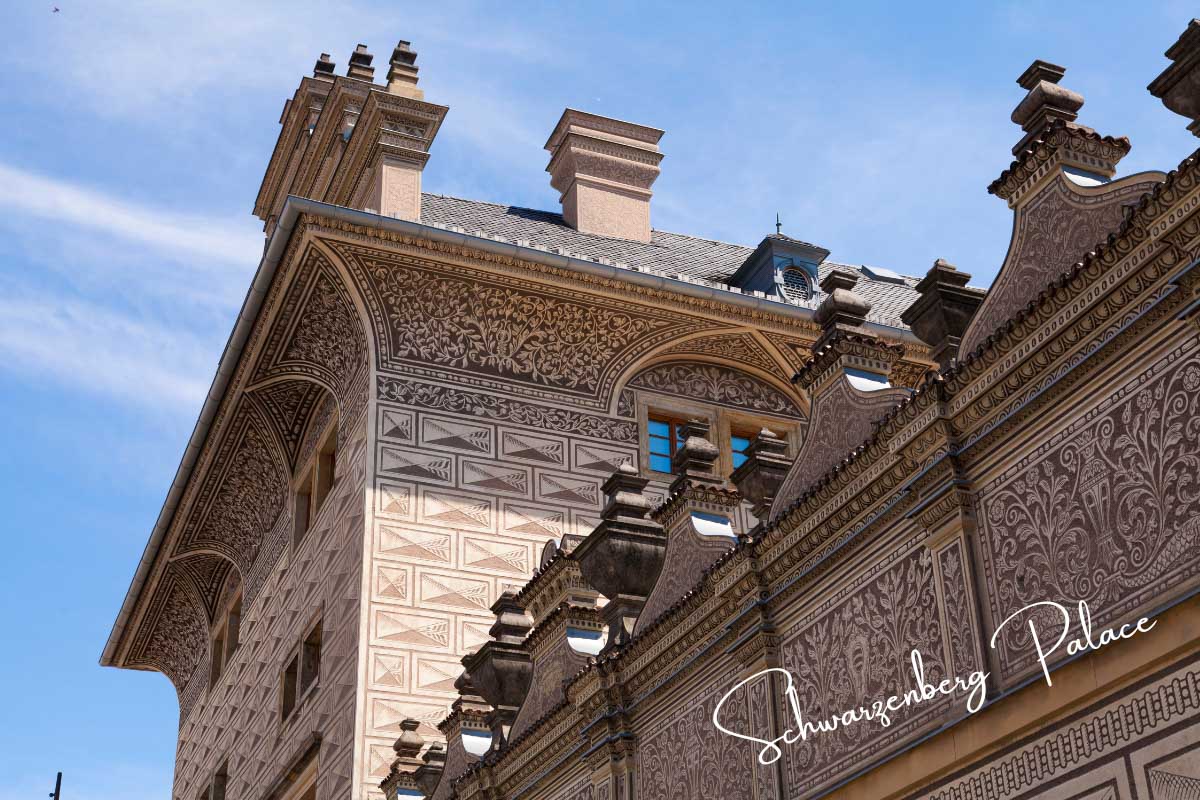
An Italian architect built it for the Lobkowicz Family in the mid-1500s in Florentine style. The Schwarzenbergs, the leading family in the Habsburg Empire, acquired the palace by marriage in 1719. Today, it houses the National Gallery’s exhibition of Baroque art.
Prague Castle Complex
Perched on top of Castle Hill, the stunning Pražský hrad, or Prague Castle, dominates the skyline like no other building. It is the largest coherent castle complex in the world, covering an area of almost 70,000 sq. meters.
The complex, enlisted as a UNESCO World Heritage Site, features large-scale palaces and ecclesiastical buildings, including four palaces, four churches, marvelous gardens, and a defensive tower, all done in different architectural styles.

By the beginning of the 14th century, the complex was home to the royal palace, churches, and a monastery. Reconstructed during the rule of Charles IV, it was destroyed by fire in 1541, and later, most of the buildings were renovated in Renaissance style. Since 1918, the castle has been the residence of the President of Czechia.
You can wander the castle grounds free from 6 am to 10 pm, but many landmarks have different opening hours, and some require an entrance ticket.
Please note that I deliberately haven’t included the most important buildings of the Prague Castle complex as separate listings in this post. Instead, I briefly explain their significance here and have included them as different spots for easy navigation in the Prague walking tour map provided above.
The Gothic St. Vitus Cathedral is the prominent landmark of the castle that used to be a place for kings’ coronations and is also home to the Bohemian Crown Jewels hidden in a dedicated room. Another noteworthy spot here is the St. George’s Basilica , founded in the early 10th century and believed to be the oldest surviving church in Prague. Its red Baroque facade makes it easy to recognize.
Besides, the complex boasts a unique small street called Golden Lane , a collection of colorfully painted historical buildings. Despite its name, don’t expect to find gold-plated pavements or golden decorations here. It got its name after a goldsmith moved into one of the houses in the 17th century.
The lane was also home to Franz Kafka’s sister, who rented house No.22 in 1916, which Kafka himself used for one year to write one of his books. Nobel prize-winning poet Jaroslav Seifert also lived on Golden Lane in 1984.
Today, these houses are turned into shops and a museum displaying medieval armory, clothing, and torture devices.
I suggest spending a reasonable amount of time exploring the complex grounds and enjoying panoramic city views from several viewpoints. Alternatively, you can join the Castle Tour with a Local Guide and Entry Ticket or the Prague Castle 2.5-Hour Tour, Including an Admission Ticket , to see everything and learn more about the castle grounds.
Wallenstein Palace & Gardens
The Wallenstein Palace, one of Prague’s first and largest Baroque palaces, is an ambitious project of the military commander Albrecht von Wallenstein, who decided to build the palace in 1642 to overshadow other landmarks, including the Prague Castle to show his status as a commander of the Imperial Catholic armies during the Thirty Years’ War.

To fulfill the project, he had to buy, destroy, and confiscate a brick kiln factory, three gardens, and many residential houses in the densely populated Lesser Town to give space for his palace.
Nevertheless, it is absolutely stunning once you walk through the palace garden featuring monumental statues and fountains. It is wonderful during spring and summer when flowers bloom.
- Opening hours: the palace garden is open from April to October. Mon-Fri from 7 am to 7 pm and Sat-Sun from 9 am to 7 pm. The palace is open on Saturdays only from April to October from 9 am to 4 pm.
- Entrance fee: FREE for both the garden and the palace.
When done exploring the palace gardens, walk towards the Manes Bridge to cross it and slowly go back to the Old Town. One of the first buildings you’ll notice after the bridge is Rudolfinum – one of the most important buildings with several concert halls and home to the Czech Philharmonic Orchestra. This late 19th-century building hosts various concerts, including the Prague Spring International Music Festival.
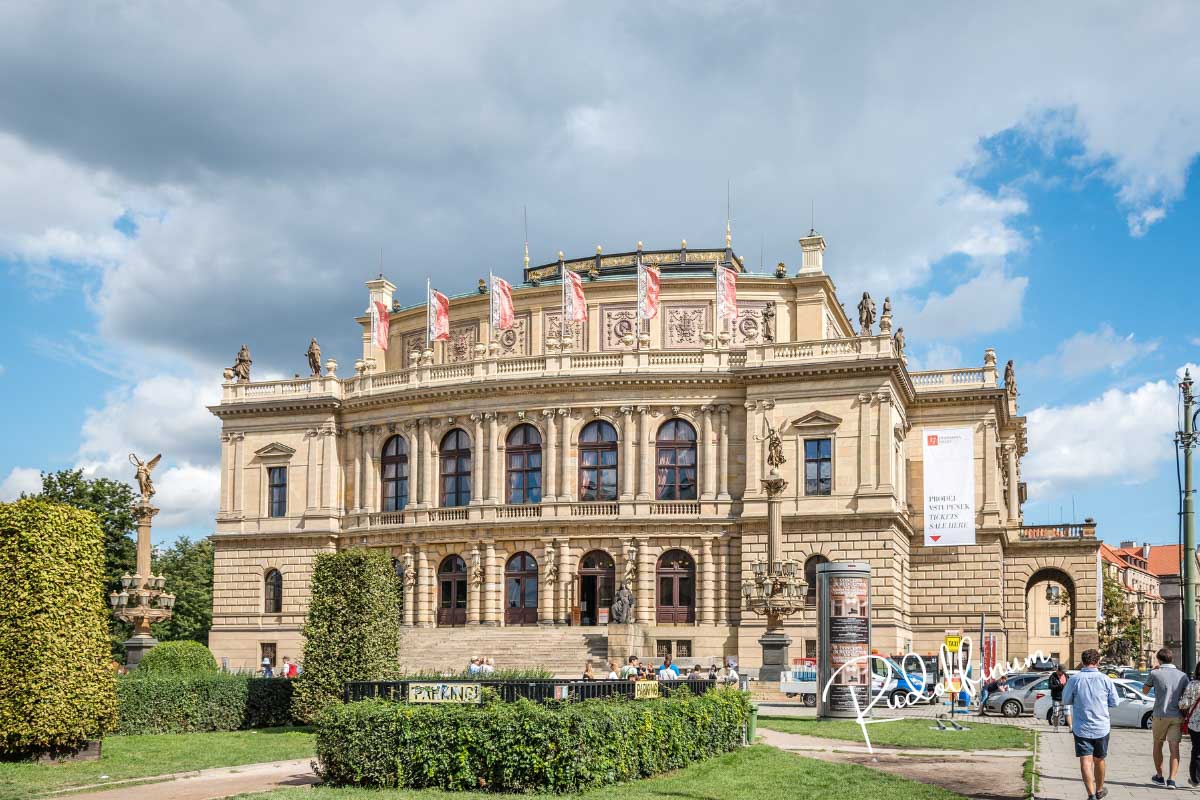
One interesting fact about Rudolfinum is that from 1918 to 1939, and a short period after WWII, it housed the parliament of Czechoslovakia.
Josefov – Jewish Quarter
The former Jewish ghetto of Prague, Josefov, lies in Old Town. Besides being a reminder of the sad past, it actually is one of the upscale areas of the city, with Parizska Street having the most fashionable designer stores.
The Quarter has six synagogues, a ceremonial hall, and an old cemetery. All of the landmarks of the area are within a few minutes walk from each other, enabling you to easily walk around to visit the museums or admire the beautiful architecture of these synagogues. Surprisingly, the area even survived the Nazi occupation as Hitler himself decided to save it as a “Museum of an Extinct Race.”
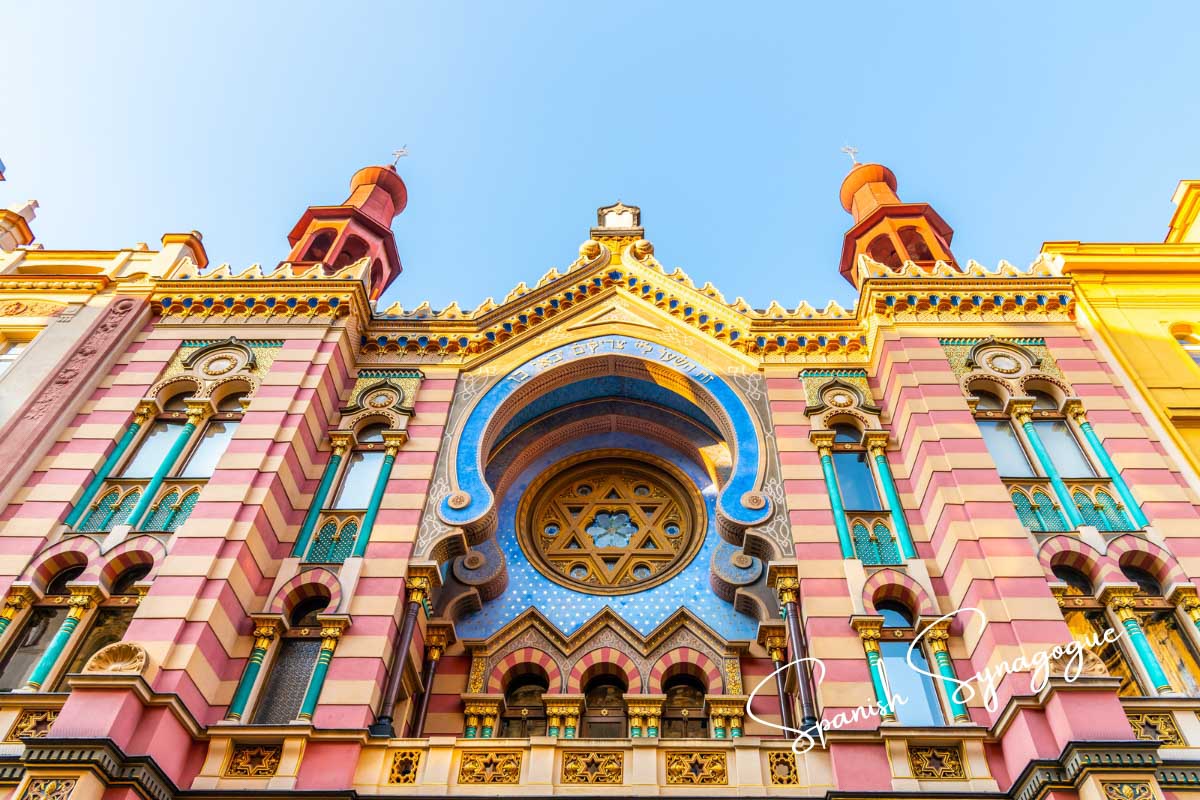
Similarly to the Prague Castle section, I haven’t included these synagogues and museums as separate listings in this post. Instead, I summarize the importance of each building and have placed the pins in the Prague walking tour map listed above.
Pinkas Synagogue is the second oldest synagogue in Prague from the 1500s and has been restored countless times over the centuries.
Old Jewish Cemetery is another must-visit Prague attraction because it is the oldest surviving Jewish burial ground in the city that dates back to the mid-15th century. Back then, the laws prohibited local Jews from burying the dead outside of the ghetto, which obviously resulted in cramped and overcrowded gravestones that are eerie, surreal, and mindblowing to see. Around 12,000 tombstones are visible, but about 100,000 bodies are estimated to be buried below them, stacked up to 12 ground layers.
Klausen Synagogue was established by Mordechai Maisel, a that-time Mayor of the Jewish Quarter, at the turn of the 17th century. It was constructed on the sight of the former Jewish school and a small prayer house.
The Old-New Synagogue is another noteworthy spot on this Prague walking tour, standing as the oldest surviving synagogue in Europe. The synagogue, built in approximately 1270, managed to endure many fires, Jewish massacres, destruction of the ghetto, and even the Nazi occupation.

Spanish Synagogue is the city’s newest Jewish religious building, constructed in 1868. The ornate facade, with its horseshoe arches, pseudo-minarets, and columns, is gorgeous to look at. Inside, the pseudo-Moorish design deliberately mirrors the Spanish Alhambra and contrasts with the other, simpler synagogues of the Quarter.
Maisel Synagogue , built in Neo-Gothic style, was constructed at the end of the 16th century as a private prayer house for the Mordechai Maisel family, who got wealthy by lending money to Emperor Rudolph II to aid the wars against the Turks. He used the profits to develop and invest in the Jewish Quarter.
Apparently, the original synagogue was the most ornate of them all and sadly, was destroyed by fire in 1689. It was then rebuilt to its current state at the beginning of the 20th century. Today, it houses an exhibition about the history of the Jewish community in the Czech Republic, documenting their lives here from the 10th to the 18th century.
The Quarter is now part of the Jewish Museum in Prague and requires entrance tickets to the synagogues, museums, and the cemetery.
- Opening hours: every day, except Saturdays and Jewish Holidays. More info .
- Entrance fee: adults – 500 CZK gives you access to all the Prague Jewish Town attractions and is valid for three days.
Recommended tours in Prague Jewish Quarter:
Kafka Monument
Franz Kafka, the famous novelist and short-story writer, was born in Prague, primarily in the Old Town and its Jewish Quarter, to a German-Jewish mother and a Czech-Jewish father.
Because of his German and Czech parents, he was rarely accepted in any of these nationality groups and often lived in isolation and fear, and most of his works were not published in his lifetime.
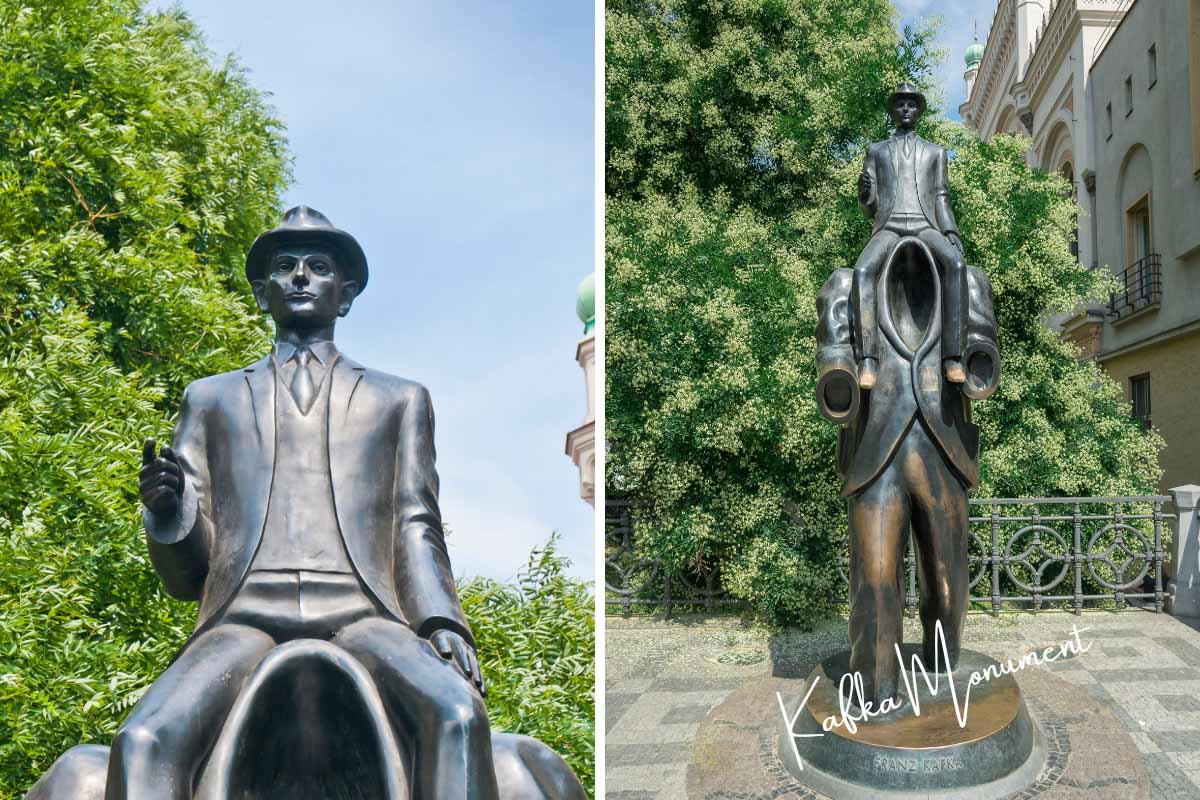
Ironically, as Kafka became world famous, now Prague has his face placed on mugs, magnets, postcards, T-shirts, and other souvenirs.
The monument honoring him, located a few minutes from the synagogues, is one of the most bizarre sculptures you might see in Prague. It shows Kafka sitting on the shoulders of a headless figure, probably Kafka himself, and references his story Description of a Struggle written in 1912.
Old Town Square
Following the fancy Parizska Street lined with luxury designer stores, you’ll return to Prague’s historic square.
Take some time now to wander around admiring beautiful pastel-colored buildings of different architectural styles, such as Art-Nouveau, Baroque, Gothic, Rococo, and Renaissance.
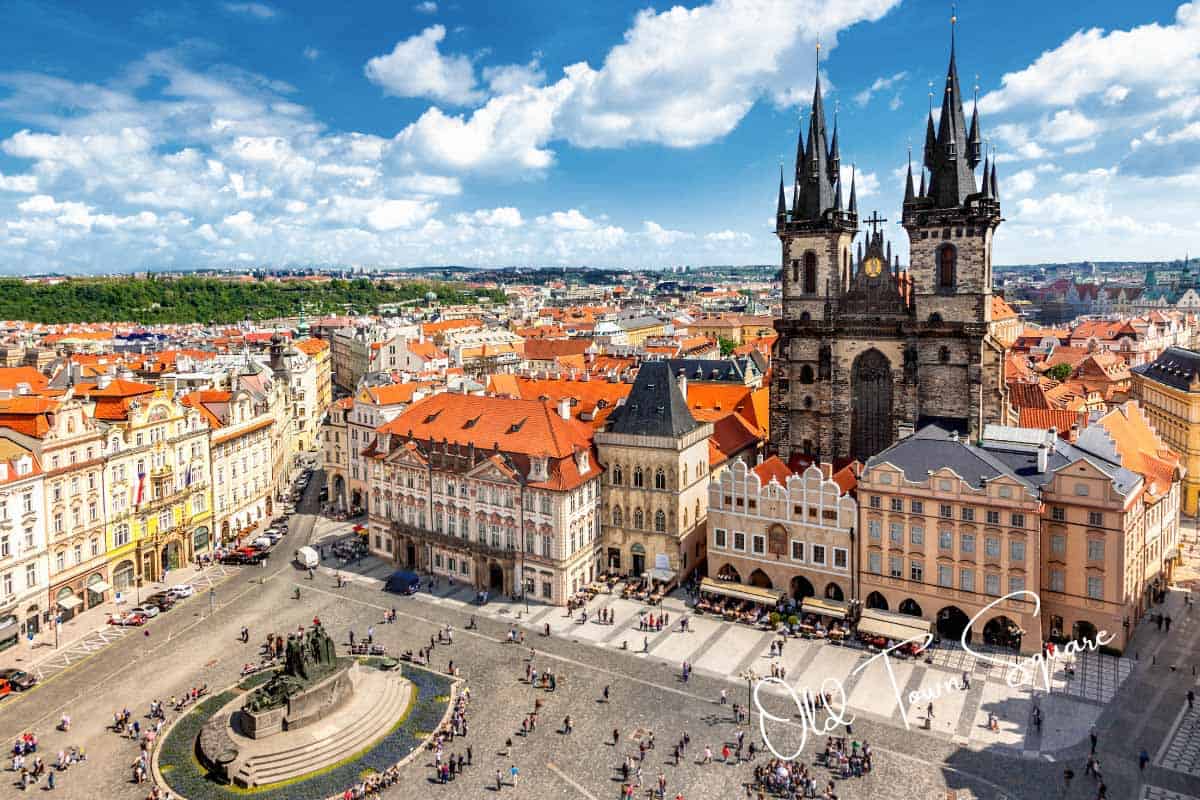
Storch House , at number 16 south of the square, also called House of the Stone Madonna, has one of the most stunning painted exteriors. The Kinský Palace on the east is another noteworthy building with a white and pink stuccoed Rococo facade that today houses the National Gallery’s exhibition.
Make sure to visit the Gothic Church of Our Lady before Týn that dominates the skyline of the Old Town Square. This 15th-century church has towers that shoot up 80 meters; if you look closely, you’ll see that these towers are not identical.
Besides historical buildings, the square is lined up with various museums, restaurants, and souvenir shops for you to pop in.
You must be hungry after that walk, right? Take a look at the must-visit restaurants for food lovers in Prague
Guided Prague walking tours
If you want to avoid the hassle of this tour and prefer to join guided walking tours in Prague to learn more about the history and culture of the city, here are a few recommended Prague walking tours:
A 3-Hour Walking Tour of Old Town & Prague Castle takes you from the historic Old Town to Prague Castle with professional local guides who tell interesting stories and legends.
Alternative Prague Walking Tour is great for those who prefer to see a different side of the city that passes through cool Prague neighborhoods, street art, and underground subcultures.

Prague Ghosts and Legends Walking Tour is an evening tour that lasts from 1:30 to 2 hours, where you walk through haunted streets and listen to mysterious stories of medieval Prague.
Old Town and Jewish Quarter Guided Walking Tour walks through the Jewish Quarter, where you can listen to the history of Prague’s Jewish community and see its synagogues and the cemetery.
Old Town, Medieval Underground & Dungeon Tour is ideal for those who’d love to see what is hidden below the Old Town with its rooms, cellars, and corridors.
Where to stay in Prague
Prague offers a variety of neighborhoods and areas to stay in, depending on your preferences and budget. Old Town and New Town offer plenty of accommodation options for a central location, ranging from budget hostels to luxury hotels. These areas provide easy access to many of the city’s top attractions, including the Charles Bridge and Old Town Square.
For a quieter stay, the Mala Strana and Vinohrady neighborhoods offer a more residential feel, with plenty of charming streets and local restaurants to explore. I have a dedicated post on where to stay in Prague that explains the neighborhoods and provides a list of some of the best hotels in Prague.
Best time to visit Prague
Prague is a beautiful city that offers visitors a rich history, stunning architecture, and a vibrant culture. However, the city’s weather can vary greatly depending on the season, making it essential to plan your trip accordingly.

The best time to visit Prague is during the spring and fall when the weather is mild and the crowds are smaller. The peak tourist season is summer, from June to August. The season is warm and sunny, bringing crowds of tourists, and hotel prices tend to go high.
Winter is magical and another best time to visit Prague, especially around the holidays when the city is decorated with Christmas markets and lights. However, the weather can be pretty cold, with temperatures ranging from -5 °C to 5°C, and there is a chance of snow. However, snow-covered Prague is absolutely stunning.
What to wear in Prague
Prague is a walkable city with cobblestone streets lining most of its central districts. Therefore, it is essential to know what to wear in Prague based on weather temperatures and the activities you plan to do.
The weather in Prague can vary greatly depending on the season, so it’s important to pack clothing appropriate for the time of year you plan to visit. If you plan to visit during summer, pack lightweight and breathable clothing, such as t-shirts, shorts, flowy skirts , and long dress e s . However, bring a light foldable raincoat or umbrella for occasional rain showers.

Planning a trip for spring or autumn and want to know what to wear in Prague for those seasons? In that case, pack layers that will keep you warm during cooler mornings and evenings. A light coat or jacket , cardigan , or scarf can help you adjust to temperature changes throughout the day.
Winter in Prague is quite cold, and temperatures drop below freezing, so wear warm clothes like sweaters or hoodies and winter jacket . Remember a winter hat , scarf , and gloves . I typically opt for thermal leggings and t-shirts for winter travels that I wear underneath jeans and a hoodie.
Since the best way to explore Prague is by aimlessly wandering its streets, comfortable footwear is essential, regardless of season. Bring comfortable walking shoes or sneakers that can withstand long days of walking on cobblestone streets. I always pack my Teva walking shoes and/or The North Face sandals for warmer climates. Bring waterproof winter shoes to navigate through snow and ice if you plan to visit during winter.
Remember to throw in these useful accessories in your bag:
Camera or phone: Prague is extremely photogenic city, so be sure to bring a camera (I have Sony a6300 ) or smartphone (I recently purchased Google Pixel 7 Lemongrass color) to capture all the sights.
Power bank: I am sure you’ll be taking lots of photos and using maps to navigate around. Therefore, having an external charger to keep you on the go, is very important. I have this Anker power charger .
Universal adapter: If you are coming from outside Europe, you’ll need a universal adapter to be able to charge your devices.
More Prague Content
21 comments.
What a great walking (and virtual for now) tour! I love how much you are able to take in in just 6km!!! I will definitely refer back to this if I even make it to Prague.
i would love to visit prague! very high on my bucket list and love this itinerary
Ahh! I can’t stand not knowing the story behind something, now I really want to know about Černý’s Upsidedown statue of St Wenceslas! In any case it’s very interesting and I guess we can all make our own decision about what Černý’s trying to say with it.
Thank you for including a map! This helps a ton when trying to find out where to start! Old Town looks amazing…
I have only heard amazing things about Prague, and I love how you fit in so many things in this day trip! I cannot believe how big Prague Castle is. I can’t imagine exploring a place so large! Seems like there is just so much to do here!
I visited Prague a very long time ago and I would love to go there again! This self walking tour is such a great idea! Super useful, I am saving it for later! Thank you Baia!
Same here, would love to go back sometime soon!
Prague is so lovely!! This is such a great walking guide. I would love to come back and be able to explore more.
Happy you found it useful! 🙂
Simply in love with the photography here- I am a sucker for architecture and Prague has a veritable dose of that.
Hey Shalzmojo, yes the city has gorgeous buildings to admire 🙂
Great post!! Its pretty elaborate and so helpful in anyone willing to take a self-guide walk. Love the pictures also 🙂
Thank you so much! I am glad you found it useful 🙂
I love this idea. There is a lot to see in Prague and it’s easy to miss things so this is so useful and very comprehensive
Definitely! Prague has plenty of things to see and it’s very easy to miss some of them
This is great! I actually recognise some of it from when I wandered around the city myself. It’s an amazing place to be.
What a great walking tour of Prague! I would especially enjoy wandering old town, taking tons of photos of the clock and Charles Bridge! It definitely seems that Prague has a ton of charm and sights to see. 😁
This will be such a handy guide next time I’m in Prague! You really mapped out for us, thanks!
Happy to provide all the details 🙂
I love Prague so much. Easily one of my favorite cities. This is great itinerary, and it gave me a nice walk down memory lane!
Love this! Prague is one of my favourite cities and I can’t wait to visit again one day 🙂 I was lucky to have my friend that lives there show me around when I stayed with her but would like to go back to a few of the spots that I missed!
Leave a Reply Cancel reply
Your email address will not be published. Required fields are marked *
This site uses Akismet to reduce spam. Learn how your comment data is processed .

Europe > Prague > Free Prague Walking Tour
Prague Top Tourist Tips | Suggested Itineraries For Prague
- Old Town Walking Tour
- Castle & Little Quarter Walking Tour
- Charles Bridge Walking Tour
- Jewish Quarter Walking Tour
- New Town Walking Tour
- Best Day Trips
- Helpful Visitor Tips
- Suggested Itineraries
- Reading An Astronomical Clock
- Getting From/To The Airport

Free Prague Walking Tour:
Location : Old Town Prague ( Stare Mesto ) Cost : Free ( optional costs below ) Style : Do-It-Yourself Walking Tour ( Self Guided ) Start : Charles Bridge ( Karlov Most ) End : Old Town Square ( Stare Namesti ) Walking Distance : 2.2 miles Time Required : 60 minutes for walk ( with all sights 5 hours ) Fun Scale : 10 out of 10
Old Town Prague Overview:
Officially established in 1091, Old Town Prague is bound to make you feel like you’ve stepped back into time. Early Prague was a crossroads where traders met, kingdoms were formed, and even a place where religions were started. Over the centuries Old Town has overgrown its former walls, but has masterfully retained its Medieval charm thanks to being largely untouched in WW2 compared to other European capitols. Hitting up all of the stops on our free Prague walking tour map will make it easy to fall in love with Old Town. Enjoy our free Old Town Prague walking tour!
Old Town Prague Walking Tour:
1. national library ( clementinum ):.
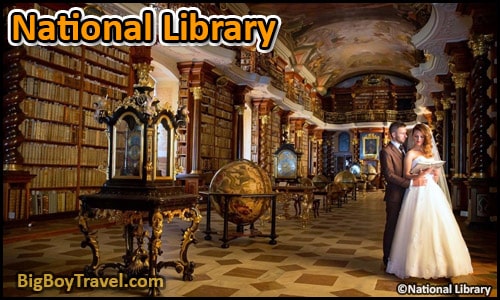
About The Clementinum : Sitting between Charles Bridge and the core of Old Town, the stunning National Library is the perfect place to start our free Prague walking tour. Back in the 11th Century, the Dominican Order of Monks began to build a small monastery here beginning with the Chapel of Saint Clement . In 1556, Jesuits monks moved into the monastery and founded a school. The growing school was promoted to a University in 1622 which led to considerable expansions in the 1650s. Charles University merged with the Jesuit College and quickly became the 2nd largest building complex in town behind Prague Castle.
The Jesuit College grew so fast in the 1600s that it quickly grew from just 1 book to over 20,000 books and attracted many great thinkers. The most famous of these thinkers arrived in 1619 when German mathematician Johannes Kepler used the Clementinum’s observatory come up with his Laws of Planetary Motion . Empress Maria Theresa even fell in love with the Jesuit complex and helped to further expand it in 1722 to include a 170-foot-tall Astronomical Tower and the gorgeous Baroque-style National Library Hall . The Library and its amazing ceilings are still one of the most beautiful libraries in the world. If you are willing to manage its 172 stairs, the Astronomical Tower offers unique views of Old Town Prague, and it also holds the world record for the longest continuous recording of daily temperature. Just 50 years after the last expansion of the Clementinum the Jesuits were forced out of Prague in 1773, but the Clementinum still survives as Prague University and National Library.
Even if you are pressed for time, the Clementinum is worth every minute to see the amazing National Library Hall. If you happen to be coming from Charles Bridge make sure to look up and find the statue of the nude girl sitting on a ledge holding a bird. It is called The Girl with Paper Swallow and was added as part of an exhibition in 2006.
Clementinum Hours : January-March 10am-4:30pm; April-October 10am-7pm; November-December 10am-6pm. Guided Tours : Tours last 50 minutes and leave every 30 minutes with a maximum of 22 guests at a time. Cost : Adults 300 CZK; Student & Senior 200 CZK; Kids 6 and under Free; Skip The Line Pass 380 CZK. Library Website : ( HERE ).
2. New City Hall ( Nová Radnice ):
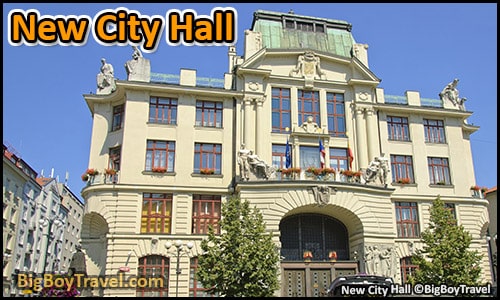
About New City Hall : The large New City Hall, with its beautiful facade, sits in the middle of Virgin Mary Square which has deep roots back to Medieval times. In the 1100s a sizeable Romanesque-style church dedicated to the Virgin Mary was built here surrounded by a cemetery. It’s said that locals nicknamed the church Mary on the Puddle because of flood waters that frequented the square. After Joseph II’s reforms in the 1780s closed one-third of all the monasteries in the Holy Roman Empire, Mary’s Church was abandoned and later demolished in 1791.
Today’s New City Hall was built from 1908-11 in a classic Art Nouveau-style decorated by dozens of statues. The building may be the main seat of city government in Prague and Mayor’s office, but it’s a couple of the exterior sculpture that matter to us. Our favorite statue is the dark, larger than life one of the Northwest corner of the building called the Iron Knight . Legend has it that the Knight stabbed a young lady who did not want him and as she died, she cursed him to turn to iron. To us, the Iron Knight statue looks a lot like Darth Vader from the Star Wars series. On the Southwest corner of City Hall is another large dark statue depicting Rabbi Loew who infamous in folklore for creating the Golem to protect Prague’s Jewish community.
Before continuing around Town Hall, make sure to visit the small fountain on the back side of the neighboring Clam-Gallas Palace as it is considered the most beautiful sculpture in Prague. The fountain is called Vltava, after the Prague’s River, and shows a lovely topless maid pouring our two jugs of water. The two pitchers represent the two sources of water for the Vltava River. Notice that one of the jars has 5 stars on it which are the symbol of the Czech Catholic Saint John of Nepomuk who drowned in the Vltava River as a martyr centuries ago. The fountain was added to the square in 1812-18, but was replaced with a replica in 1957 after the original fell into disrepair.
3. Little Square ( Malé Náměstí ):
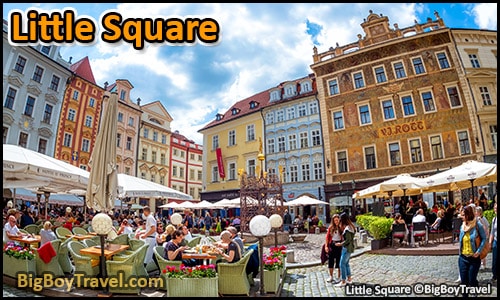
About Little Square : Rounding the corner from New City Hall into the Little Square, you will catch your first glimpse of Prague’s tightly packed colorful buildings. The picture-perfect scene in Little Square is a great preview what you will see later on this Old Town Prague walking tour. Little Square is said to be the oldest inhabited part of Prague with homes going back to the 700s. The square gained its final layout in the 1100-1200s ringed with narrow Gothic houses which grew into larger Renaissance buildings over 500 years later. To this day, many of the building still have Romanesque cellars dating back to the early Middle Ages.
Our favorite building on Little Square is the stunning V.J. Rott House which boasts a beautiful full building mural facade depicting various Medieval tradespeople. The 4-story home was built in 1896 by Ladislav Rott who ( along with his brother Julius ) started a successful iron working and construction company. Previous to the Rott House, the lot was the site of an older home from the 1200s called At the Three White Roses, which was named after the 3 wealthy sisters that once lived there. Today the Rott House is home to the Hard Rock Cafe ( website ) and the Rott Hotel ( website ). The blue White Lion building next to the Rott House is also from the 1800s, but has an excellent Gothic doorway dating back to the 1300s .
In the middle of Little Square is the Iron Fountain which is the oldest well in Prague. There has been a formal fountain above the well since the 1100s and the well preserved gilded iron gate wrapping around it was handmade in 1560. The Iron Fountain has held up well to the test of time and is the perfect companion to the Little Square’s outdoor restaurants which sit on raised wooden planks.
For another look into the past, make sure to look at some of the icons above the doorways which were used to identify the building of Little Square in Medieval times. The figures were significant at the time because not many people could read. Surviving in Little Square today are the figures of a Golden Fish, a Blue Horse, Golden Sun, and more. These Medieval icons will be a reoccurring theme on this free Prague walking tour.
4. House At The Minute ( UÂ Minuty ):
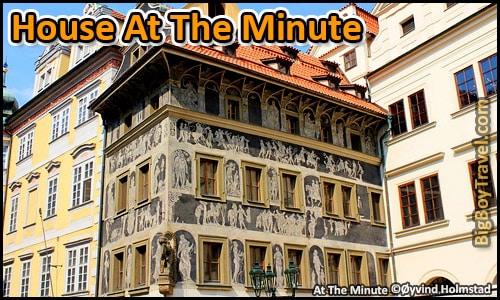
About The The House At The Minute : As you start to hit the entrance to Old Town Square, make sure to look left and inspect our favorite home on this free Prague walking tour called At The Minute ( my-nute, not minute ). It’s funny how many people walk right past what may be Prague’s most beautiful historic home which dates back to the early 1400s. In 1564 a third floor was added to the house, and it received a complete Renaissance makeover including the fantastic Sgraffito etchings . The beautiful white etchings on the black facade depict scenes from the Bible ( Adam & Eve ), Roman Mythology ( Hercules & Bacchus ), Habsburg rulers of the day ( Philip II of Spain, Maximilian II and his son Rudolf II ), and Ottoman Sultan Selim ( who the Habsburgs signed a peace treaty with ). Back then the building was known as the White Lion House and later served as a pharmacy until 1712.
By the late 1700s, the beautiful Lion statue holding a shield placed on the corner of the home which still survives today. The shield once displayed the Habsburg coats of arts, however, any painting on it has long since faded. Later the White Lion House was turned into a tobacco shop which is how it got its current name, At The Minute. Our first reaction was to think the title At The Minute came from the home’s location next to Old Town Prague’s central clock tower, but it is actually from the small packs of tobacco that were sold in the shop. Minute, in this case, means very small as in My-Nute not the measure of time Minute. At some point after the name change, the Sgraffito etchings were covered up with plaster and were not re-discovered until renovations in 1919.
While the facade is the main attraction today, the House At The Minute is most famous for being the childhood home to local author Franz Kafka and his family from ages of 6 to 13 ( 1889 to 1896) . Many of the characters in Kafka’s short stories lived life under overpowering bureaucracies with feelings of helplessness just like he had early in his life in Prague. These types of characters were easy for people to identify with changing the landscape of early 20th Century writing and leading to the term Kafkaesque for roles like this. Today the bottom floor of the former mansion holds the Ristorante Italiano Al Minuto ( website ). On the opposite side of the road from the House At the Minute is a row of other interesting homes with Medieval names we will touch on at the end of this free Prague walking tour.
5. Old Town Square Classic View :
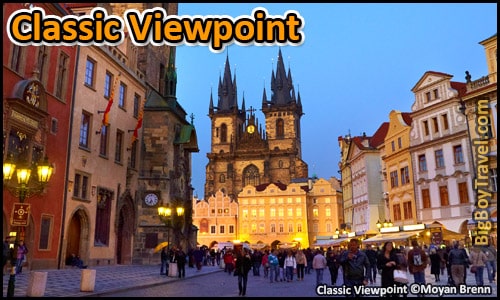
About The Viewpoint : After admiring the At Minute House, it is almost unreal the first time Old Town Square reveals itself from around the corner. While it can be tempting to trot right to the center of the square like a moth to a light, make sure to take the time to take in the classic view. Old Town Square has been the heart and soul of Prague long before the city was officially founded in 1091 AD. This perfect viewpoint gives you Old Town Hall with its Astronomical Clock to your left, the Gothic Church of Our Lady Before Týn in the center, and a row of Medieval houses on your right.
For maybe the most unique perspective of the the entrance to Old Town Square, consider visiting the street-level patio or rooftop terrace restaurant ( website ) of the fancy Hotel U Prince ( website ). During the evenings and weekends, you will want to make a reservation for the terrace as the views over the rooftops is amazing. The hotel also has a famous underground cave-like bar called the Black Angel ( website ) which is worth a visit. The historic bar is only open from 5pm-3am, must dress in smart casual attire ( no hats ), and reservations are highly suggested.
6. Astronomical Clock Tower ( Pražský Orloj ):
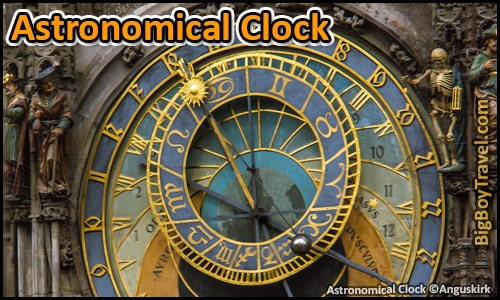
About Prague’s Astronomical Clock : After King John of Luxemburg allowed Prague to form a city council in 1338, work quickly started on the huge town hall complex. The main building and 228-foot-tall bell tower were finished relatively quickly, but the real gem is the Astronomical Clock which was added to the in 1410. Surprisingly the beautiful clock still works making it the oldest operational clock in the World and overall the 3rd oldest astronomical clock. Local folklore says that the city ordered the original clock maker blinded so the beauty of the clock could never be copied anywhere else. The clock was almost silenced forever in 1945 when it was severely damaged during a citizens’ uprising against the Nazis occupying Prague and wasn’t repaired for 3 full years.
The elements of the Astronomical Clock may look confusing, but each one has a particular function. The main part added in 1410 was the Astronomical Dial which shows the position of the Sun and Moon in the sky with a mechanical clock in the center of it. This dial will let you tell the current time ( modern 24-hour clock ), ancient Bohemian time, sunrise, sunset, and much more. The 2nd element added to the clock was The Walk of the Apostles in the 1600s which is filled with animated statues ( replaced in 1865 ) that come alive once an hour peeking through the window. This hourly show also features a few side statues including Vanity staring at himself in the mirror, a miser with gold representing greed, a Turkish man bringing entertainment, and Death is represented by a skeleton chiming his bell with the sounds from the tower. The last major element on the Astronomical Clock is the Calendar Dial added in 1870. The center of the dial has the crest of Old Town Prague surrounded by the 12 Zodiac symbols ( pre-2012 version ) lining up with the days they fall on laying on the outer ring with has marks for each day of the year. These 365 individual days are each marked as Name Days and on your day you are given gifts similar to celebrating a birthday. The Dial rotates keeping the current day on the top although there is a repeat on Leap Years which wasn’t adopted in Prague yet when the clock was made. Make sure to read our detailed guide on How To Read Prague’s Astronomical Clock .
One of the biggest treats is going to the top of the 228-foot-tall Bell Tower for an unbeatable view of Old Town Prague. Even if you take the stairs, make sure to check out the modern looking Space Elevator going right up the middle of the bell tower. You can also tour the surprisingly vast Underground of Old Town Hall for a totally different perspective on the building. Here you will find previous Town Hall foundations that have been built over and even a Romanesque Hall room from the 1100s. Bell Tower Hours : Monday 11am-10pm; Tuesday-Sunday 9am-10pm. Cost is 110 CZK. Underground Hours : Monday 11am-10pm; Tuesday-Sunday 9am-10pm. Cost is 50 CZK. Town Hall Website : ( HERE ).
Read More : How To Read Prague’s Astronomical Clock .
7. Memorial Cross Park :
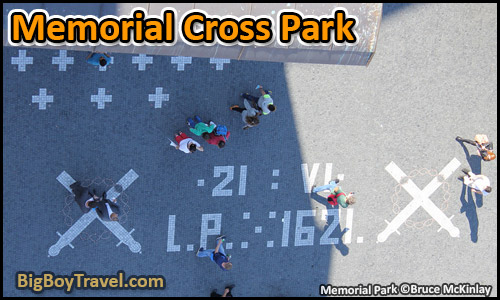
About Memorial Park : In the late 1300s most of greater Bohemia switched from being Catholic to Protestant from the influence of Prague’s preacher Jan Hus who started the Hussite Movement. The original split was largely due to Jan Hus protesting the church to preach in the local language instead of Latin. Major conflicts started to arise in the 1600s when the Catholic Church tried to conquer much of Europe during the 30 Years War . The famous religious war is said to have it roots in Bohemia when Emperor Ferdinand II started oppressing Czech’s Protestants in 1609 to strengthen the Habsburg rule over the region. Ferdinand even moved the capital of the Holy Roman Empire from Vienna to Prague and started to crack down on religious freedom. Empowered by a growing citizens revolt in 1618, forty-seven Czech Noblemen gathered their forces of over 30,000 men to fight off Emperor Ferdinand II. The Protestant army was ultimately defeated at the Battle of White Mountain on November 8, 1620 ending Bohemia’s resistance in the 30 Years War.
In the aftermath of the Battle of White Mountain the region was put under tighter Hapsburg rule, forced to return to Catholicism, and the 47 rebel noblemen we put on trial. It wasn’t much of a trial as they weren’t given a full defense and 27 of them were executed in Old Town Square on June 21, 1621. With the Protestant noblemen out of the way, the Habsburgs took greater control of Prague and most of the surrounding farmland. The Habsburg rule over Prague lasted almost 400 years ( 1526-1918 ), but with the influence waning, a Memorial Park was created in the Old Town Square honoring the 27 executed noblemen in 1911. The Memorial holds a plaque with the names of the noblemen, as well as white crosses in the pavement for each one of them. On the side of Old Town Hall, facing the Old Town Square, you will also see a plaque honoring Jan Zelivsky was one of the noblemen and a very popular priest carrying on Jan Hus’ work. The entirety of the more traditional tree-filled park next to the crosses was where the massive main hall of the Medieval Old Town Hall sat before it was bombed in WW2.
8. Church of Saint Nicholas :
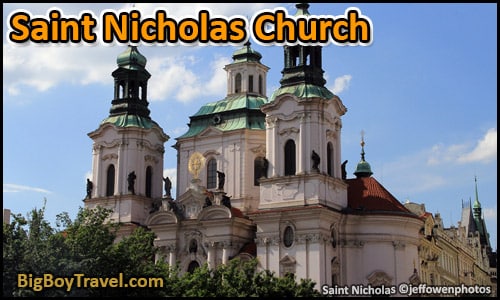
About The Church of Saint Nicholas : People often get confused that there are two Churches of Saint Nicholas in Prague that look almost the same on the outside. The older of the two churches is in the heart of Lesser Town below Prague Castle, and the slightly younger one was constructed here as part of the Benedictine Monastery in 1735.
Built to replace an older church from the Middle Ages, the view of the Old Town’s Church of Saint Nicholas was originally blocked from the main square by a 3-story tall Medieval mansion called the Krenn House ( photo ). The Krenn House ( built in 1409 ) was torn down in 1901 opening up views of the green dome and twin towers of the large Church of Saint Nicolas. While it is impressive on the outside, the once grand interior of the Old Town Saint Nicholas Church is now a little boring. The original Baroque interior elements were stripped when the Jesuits were forced out of Prague in the 1790s and today is full of a series of painted murals. In contrast, the Saint Nicholas Church in Lesser Town has retained much of its original glorious Baroque interior and is far more impressive inside.
If you are into the Jewish history of Prague, make sure the check of the Kafka Cafe next to the church which was once the home and birthplace of author Franz Kafka. Franz wrote a number of successful short stories while living in Prague about characters living under oppression and was considered one of the most influential authors of the 20th century. We also have a very helpful Jewish Quarter walking tour map which you can follow for a deeper look into the history of the nearby Jewish Neighborhood after you are done in Old Town.
Church Website : ( HERE ).
9. Jan Hus Memorial :
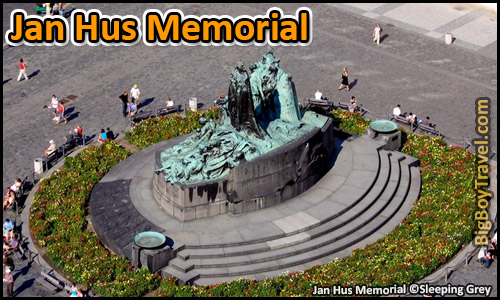
About The Jan Hus Memorial : Overpowering the center of Prague’s Old Town Square is the large green memorial statue dedicated to local preacher Jan Hus . Born in 1370, Jan Hus quickly became a local religious leader in Prague. He started butting heads with the Vatican in Rome when he began doing Catholic mass in the local language instead of in Latin which started the Protestant movement in Prague called the Hussite Movement in his honor. Finding him guilty of being a heretic by the Catholic church in 1415, Jan Hus was burned alive at the steak and the Protestants were sent on exile from Prague which lasted over 200 years. Roughly 100 years after his death, Jan Hus helped to inspire Martin Luther as he broke his group of followers off into the Lutheran sect of Protestantism.
The Jan Hus Memorial in Old Town Square was completed on July 6, 1915 which was the 500th anniversary of his death. The memorial has a statue of an anonymous young woman representing the rebirth of the Czech Nation. The other statue on the monument is of Jan Hus representing moral authority as he chose to give his life rather than give up his beliefs. Hus became a symbol of standing up to the powerful Vatican and by the early-1900s young people of Prague really began to embrace him again as they were standing up to their oppressive Habsburgs rulers. We find the Jan Hus Memorial to be the most beautiful statue on this free Prague walking tour of Old Town.
10. Goltz-Kinsky Palace :
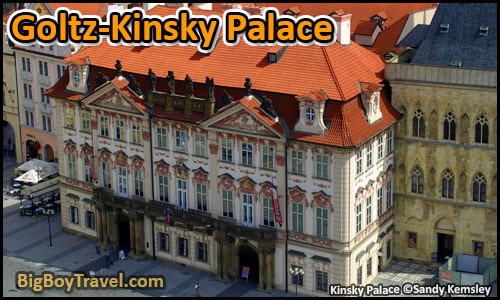
About Goltz-Kinsky Palace : Often called the most beautiful Rococo building in Prague, the Goltz-Kinsky Palace is now part of the National Gallery Art Museum. The fancy looking pink mansion was built by Count J.A. Goltz on the foundation of an older Medieval building in 1755. The original foundation can be seen in the Romanesque and Gothic cellars which have been restored and opened to the public. After he died in 1768, Count František Oldrich Kinský bought the mansion and made it his family home for generations. Baroness Bertha Suttner–Kinský ( born here in 1843 ) became the 2nd female Nobel laureate and 1st woman to win the Noble Peace Prize in 1905 for her writing Lay Down Your Arms and contributing to the creation of the Prize.
From 1893 to 1901 the Goltz-Kinsky Palace served as a German Grammar school where famed local author Franz Kafka attended. In 1948, the Communist leader Klement Gottwald gave a speech from the balcony declaring the start of his party’s oppressive policies on the people of Prague. We will see more from this era of Prague’s history at the Communist Museum later on this free Old Town Prague walking tour.
Gallery Hours : Tuesday-Sunday 10am-6pm; Closed Mondays. Gallery Cost : Adults 300 CZK and kids 150 CZK which also covers all other National Gallery locations in Prague for up to 7 days. Goltz-Kinsky Palace Address : Old Town Square #12. Palace Website : ( HERE ).
11. The Prague Meridian :
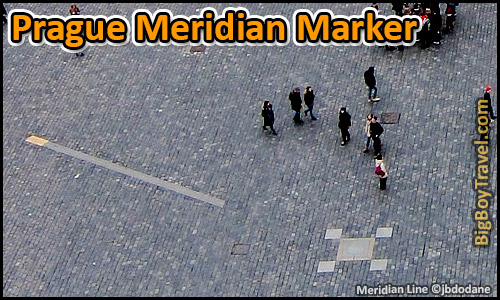
About The Prague Meridian : In 1650, Prague’s Habsburg ruler Ferdinand III added a large Marian Holy Trinity Column ( photo ) to Old Town Square honoring the Peace of Westphalia agreement which ended the 30 Years War. In exchange for the peace, locals had to accept Catholicism and give up some religious freedoms. Capped with a statue of the Virgin Mary, the column was so tall that it was quickly turned into a large sundial. As part of this dial, 60-foot-long line in the pavement called the Prague Meridian was added from the base of the Mary Column toward the North and was tipped with a golden marker. Whenever the shadow from the Marian Column passed the Meridian line it marked celestial noon which is when the day’s light is halfway over.
The concept of celestial noon may seem foreign now, but back in Medieval times, people kept track of time more by the daylight hours instead of a standardized clock. Both the night time and daylight hours were divided into 12 hours, but the length of those hours was adjusted based on the season. No matter the time for year, Noon always fell halfway through daylight and Midnight was actually at midnight. Local citizens became frustrated by almost 400 years of Habsburg rule ( 1526-1918 ) and viewed the column as a symbol of oppression . The situation boiled over in 1918 when demonstrators tore the Mary Column down, but an outline of the base and the Meridian line can still be seen in the pavement of Old Town Square.
12. White Horse Restaurant :
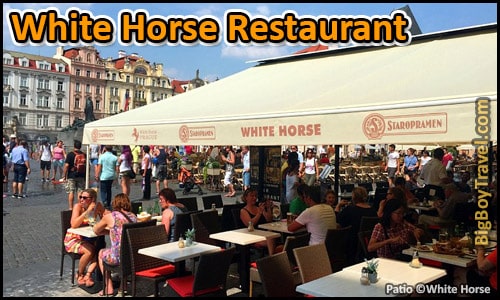
About The White Horse Restaurant : There are a few restaurants with great patio seating in front of the colorful homes right on Old Town Square, however, the best food is at the White Horse Restaurant ( Bílý Koníček ). Built in the well preserved 12th Century cellars of the former Golden Unicorn House, the atmosphere of the restaurant is awesome. The original home was built in the 1100s before being converted into a tower-like building in 1496 then getting its current Baroque facelift in the 1700s.
Another popular restaurant is the At the Stone Table House ( Kamenný Stůl ) in the pink build at #18. It is famous for being frequented by Franz Kafka and Albert Einstein, but we find the service to be below par and the atmosphere is way below the White Horse.
Hours : Daily 9am-Midnight; reservations suggested for inside dining. Restaurant Address : Old Town Square #20. Restaurant Website : ( HERE ).
13. The Storch House :
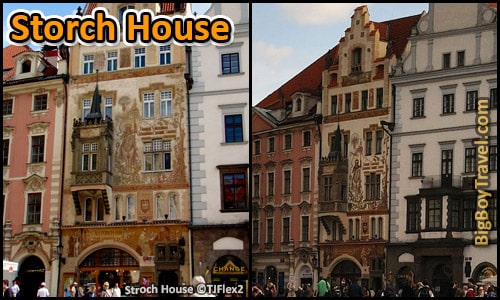
About The Storch House : The Storch House and its Juliet-like balcony may have the most beautifully painted facade out of any of Prague’s Medieval homes. When bookseller and publisher Alexander Storch took over the house as a store in 1896 he had it painted with a series of neo-Renaissance murals you see today. The murals are broken into 3 sections with the bottom showing scientific and astronomical study, the middle with Prague’s Coat of Arms squeezed between 4 windows, and the top mural showing the Saint Wenceslas, patron of Bohemia, riding a white steed while being given the grace of God. Some locals differ on the name calling it the At the Stone Virgin Mary House.
Next door to the Storch House at Old Town Square #15 is the At Capricorn House where Albert Einstein often held lectures and played his violin while serving as a professor at Prague University from 1911-1912. This was an important time in Einstein’s life as it was shortly before he came up with the Theory of Relativity. Storch House Address : Old Town Square #16.
14. Church of Our Lady Before Týn :
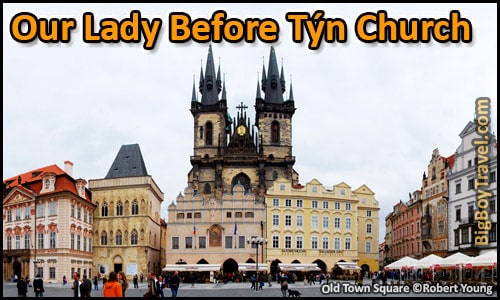
About Our Lady Before Týn : When you think of Prague in all of its Medieval glory and wonder, the image of the Church of Our Lady Before Týn is bound to come to your mind. The church is by far the most iconic building in Prague and easily the most photographed. This Gothic masterpiece, with two imposing 262-foot-tall towers topped with huge spires glares over Old Town Square. There have been churches here since the 11th Century and the current Lady Before Týn ( meaning enclosure ) dates back to the 1300s. It took over 300 years to complete the giant church so make sure to take extra time to relish in the beauty of its exterior. The inside of the church is a little bit of a let down compared to Europe’s other grand cathedrals, however, the bases of each column have amazing paintings set up in alter-like positions.
Before deciding to enter the Lady Before Týn, make sure to check out the former Týnská School sitting at Old Town Square #14 right in front of the church which now holds a number of shops. The school ran here for 500 years from the 1300-1800s and its entrance forms the oldest Gothic archway in town. While passing under the gallery archways look up among the different floral keystones to find the one depicting a man’s face blowing air while surrounded by leaves called the Green Man . The Green Man was a common symbol in Medieval times signaling Spring and rebirth. We love this unique and beautiful hidden detail which can be easy to overlook otherwise.
15. House at the Stone Bell :
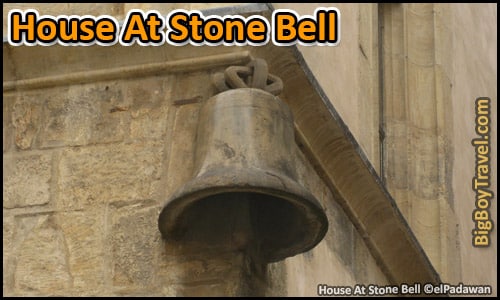
About House at the Stone Bell : The House at Stone Bell is always a photographer favorite and a very easy one for informed tourists to spot. This three-story home with excellent Gothic windows dates back to the early-1400s when it replaced an older home from 1260. The nickname House at Stone Bell was first mentioned in 1413 from a story that says a large bell from the neighboring Church of Our Lady Before Týn once broke free and crashed into the house . It is unclear if the story is true, but a replica of the famous bell was added protruding out of the corner of the house which makes the folklore even cooler.
Inside the home today is a neat art gallery shop and the backside has a relaxing cafe. If you check out the small art gallery, it also gives you access to the awesome music room on the 3rd floor behind the home’s Gothic windows. Our favorite part about visiting House at the Stone Bell is the amazing Romanesque cellar foundations from 13010 which you can visit below the home.
Stone Bell Address : Old Town Square #13. Gallery Hours : Tuesday-Sunday 10am-8pm; Closed Monday. Gallery Cost : 120 CKZ. House Website : Here .
16. House at Golden Ring :
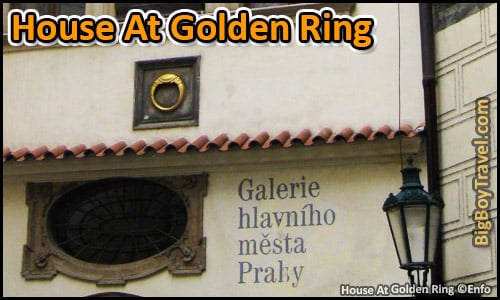
About House at Golden Ring : First built in the 1300s, the famous House At Golden Ring was a pub before being rebuilt in 1609. The Gothic doorway arch was preserved during the reconstruction and the home now holds exhibitions from the Prague City Gallery ( website ).
The name comes from the beginning of the 1700s when the owner of the House At Golden Ring believed a ghost was haunting his home and constantly bothering him. He claimed that on one of the nights of terror the ghost left behind a mysterious golden ring. Taking the ring as a sign, the owner decided to hang it above his door to block evil spirits from entering and it is said that the spirit never bothered him again. To find the house tucked into the corner of the Týnská Square, just look for the large gold ring still hung above the door.
Gallery Hours : Tuesday-Sunday 10am-6pm; Closed Mondays. Gallery Cost : 120 CZK. Gallery Website : Here .
17. Ungelt Courtyard :
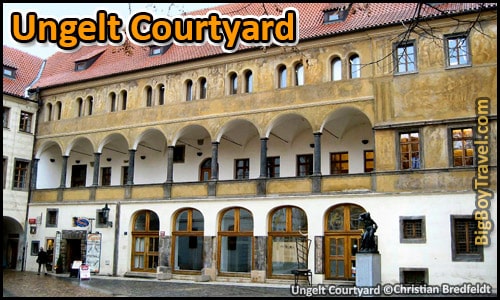
About Ungelt Courtyard : From the 1000’s through the Middle Ages the hidden Ungelt Courtyard ( or Merchant Yard ) was the main square for foreign merchants coming to sell goods in Prague. The entire market was fortified and foreign merchants would pay customs fees on their goods for protection from the Kings. This guaranteed safety made the market extremely popular. There were good from all of the major trade routes in the market including fabrics, spices, gold, silver, amber, and salt. While the square was often called Týn Courtyard ( meaning enclosure ) like the neighboring church, the name Ungelt comes from the old German word Um Geld meaning declared goods or customs payments.
Our favorite building in the Ungelt Courtyard is the huge Granovsky Palace which has Italianate loggia-style arcades and an etched Renaissance relief on its facade. The faded sgraffito etchings, originally from 1558, are very interesting as they depict the Judgement of Paris from Greek Mythology. In the tale, Zeus is asked to judge the beauty between the three goddesses Hera, Athena and Aphrodite during a wedding reception. Feeling uneasy about having to choose Zeus decided to leave it up to a mortal Trojan man named Paris. After being tempted by Aphrodite’s sexuality, Paris chooses her as the most beautiful instead of Hera who was normally considered the prettiest. Athena, who would have lost anyway, took it personally that the Trojan was tempted and took it out on his people by joining the Trojan War to help the Greeks win.
Make sure to check out guesthouse at #6 which is known as At the Black Bear and has a statue of a bear in chains. Notice the Black Double Eagle Coat of Arms on the green on the cafe and guesthouse at #8? It is the coat of arms for the Austria-Hungary Empire which ruled Bohemia from 1867 to 1918. While no longer a market, the courtyard is a favorite among locals with it popular bars and restaurants, many of which are just below street level. We really like the Dubliner Irish Pub ( website ) below Granovsky Palace and the Ungelt Jazz Club ( website ) at #2 which was once the home to one of King Rudolph II’s mistresses, Katerina Stradova. We find that Ungelt Courtyard usually has some of the best value guesthouses in Old Town including the Merchants’ Yard Hotel ( website ). Make sure to search the Courtyard for the neat hand pump drinking fountain well which is a really cool place to fill up your water bottle. The current cast iron pump is only from the 1900s, but the well has been used continuously since the 1100s.
18. Saint James Church :
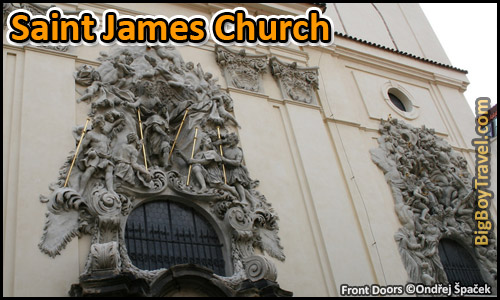
About Saint James Church : Also called Saint James the Bigger, this massive church is the 2nd largest in town behind Saint Vitus Cathedral located at Prague Castle. We love the three stucco Baroque-style reliefs above the front doors which date back to the 1600s. The reliefs show Saint James, Saint Francis of Assisi, and Saint Anthony of Padua. The enormous artistic accents have hidden gold flair and are almost bigger than the doors are.
As you enter Saint James Church, make sure to notice the 400-year-old mummified forearm hanging on display from the ceiling just inside the doors. It’s said that a thief tried to steal jewels from the Church’s altar when the Virgin Mary statue grabbed him with an unbreakable grip. The next day the thief was found still in Mary’s grasp, and they had to cut off his arm to free him. The rest of the interior has some wow factor also. We like the paintings at the base of the columns which are set up like dark altars and the impressive murals that span the entire length of the ceiling.
19. Medieval Spider Bar ( Krcmaupavouka ):
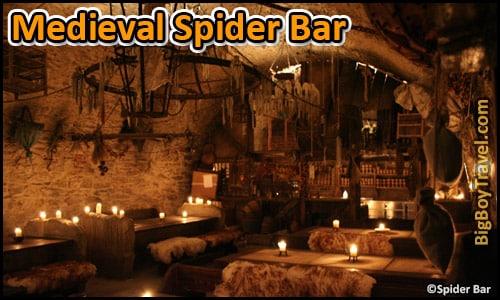
About The Spider Bar : Welcome to the true Medieval times at the amazing Spider Bar. As you enter the old world cave-like establishment the decor and costumed staff make you feel like you’ve stepped back into time. In addition to food, wine, and beer, you’ll also have the chance to be entertained by swordsmen, musicans, flame jugglers, snake charmers, and belly dancers. If you came to Prague to get a feel for its Medieval flair, this will end up being your favorite spot in town. Make sure to do whatever you have to do to fit a dinner at the Spider into your schedule.
Hour s: Daily 11am-11:30pm. Dinner Show : Happens nightly 8-10:30pm and for 1190 CZK you get a great seat for the show, a 5-course meal, and all you can drink. Location : Inside the covered walkway just off Celetná, address is Celetná 595/17. Spider Bar Website : ( HERE ).
20. Celetná Lane :
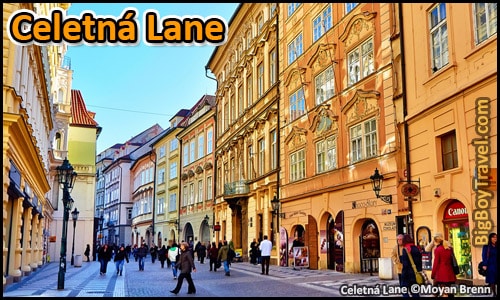
About Celetná Lane : Since the Middle Ages, Celetná Lane has been a prestigious location as it connected the Royal Court in Republic Square near the Powder Tower to Prague’ s Old Town Square. It is named after the street’s numerous bakeries that made bread rolls called Calty since the 1200s. Celetná Lane was essentially the Eastern section of the Royal Way used by the King to go from the Royal Court, through Old Town Square, through Little Square, over Charles Bridge and up to Prague Castle.
The most famous buildings on Celetná Lane is the huge Saint Charles University ( Karolinum ) complex which has an entrance in the pink building toward the start of Celetná. The school was founded in 1347 by King Charles as the oldest university in the Holy Roman Empire and also the oldest in Europe North of the Alps. Make note of house #27 which is where the Knights Templar used to hold secret meetings in the 1300s. Even after the Royal Court was officially moved to Prague Castle in 1488, Celetná Lane has remained vibrant despite local folklore of numerous ghosts that wander the street at night.
Further down Celetná Lane is another famous building called the Black Madonna ( website ) which opened in 1911 as Prague’s first Cubist style home. In many cities, Cubism as an art form dealing with objects and paintings, but Cubism in Prague is dedicated to the designed of entire buildings. Today the Black Madonna has a restaurant and Cubist Museum ( website ), not to mention a really cool warped staircase that you have to see. If you climb up to the 3rd floor you can get a great shot looking straight down the artistic staircase.
The road just South of the Black Madonna called Ovocný Street used to be quite grand, but has become bland over time. The only remaining cool building down Ovocný Street is the House At the Czech Eagle which is the awesome bright yellow building with interesting murals and a large 2nd story bay window.
21. Powder Tower ( Prašná Brána ):
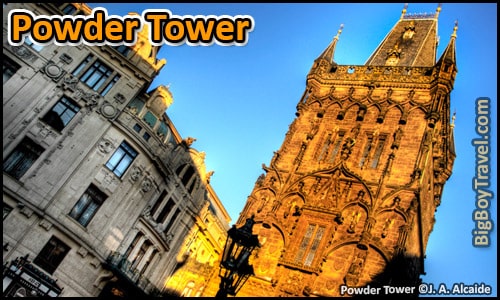
About The Powder Tower : In 1091 Old Town Prague was officially established and it didn’t take long for defensive fortifications to spring up. The first element added was a large moat circling the young Prague following the path where Na Příkopě Street sits today and was followed by a mighty wall just inside the moat. The early Medieval wall was complete with 13 city gates including the important Mountain Tower ( Horská brána ) known today as the Powder Tower. This gate was important because it was right next to the King’s Royal Court ( today’s Municipal House ) and also because it was the start of the hilly road to Kutná Hora where the royal silver mines were. The Mountain Tower also marked the start of the Royal Way which stretched West from the Royal Court, down today’s Celetná Lane, through Old Town Square, and up Kaprova Street all the way up to the historic Prague Castle. Re-reading this paragraph after looking at our free Old Town Prague walking tour map will really help you understand the early city’s layout.
Things at the Mountain Tower changed a lot in 1348 when King Charles IV established New Town making the moat and wall around Old Town unnecessary. By the early 1400s locals started calling the tower the Shabby Tower as it and other landmarks started to fall into disrepair. The crumbling monuments started getting facelifts when King Vladislaus II took over including a complete rebuild of Mountain Tower in 1475. The new tower was a whopping 213 feet tall and covered in tons of decorative statues showing Prague’s power. The King didn’t stop there as he also greatly renovated Prague Castle and in 1488 permanently the Royal Court up to the remolded castle. Just two years later Vladislaus II was also crowned King of Greece and Hungary where he spent the rest of his days. With Prague’s Royal Court move to the castle, the empty Mountain Tower was used to store random stuff until it became one of Prague’s main gunpowder storage units in the early 1700s which led to the name Powder Tower .
The Prussian Army saw how important the power storage tower was and heavily damaged it with gunfire during a failed attack in 1757 ruining most of the statues. It took over 100 years for repairs to be made to the tower when it finally got its current Gothic look in the 1880s. During the restoration, they were able to save a number of the original sculptures including 4 representing past Bohemian Kings including Charles IV surrounded symbols from the region they ruled. If you have time take the 186 steps 144 feet up to the former gunpowder storeroom for some great views of Old Town Prague and a permanent exhibit about the Tower’s history. Before leaving the Powder Tower, make sure to check out the beautifully painted facade of the neighboring Municipal House ( website ) which was built as an exhibition hall on the site of the former Royal Court in 1905. Today Municipal House hosts a lot of events from plays to concerts and its exterior murals are very photogenic.
Powder Tour Hours : Daily April-September 10am-10pm; Closes at 8pm in October & March; November-February closes at 6pm. Powder Tower Cost : Entrance is 90 CZK. Municipal House Tours : 1 hour guided tours are 290 CZK.
22. Saint Henry’s Tower ( Jindrisska Brána ):
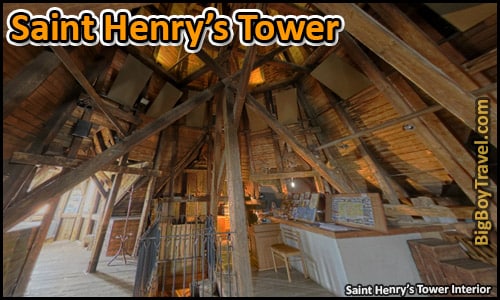
About Saint Henry’s Tower : The 10 story Saint Henry’s Tower is Prague’s tallest free-standing belfry tower at 223 feet high. It was built in 1472 and the large clock was added in 1577. The tower has 3 large bells with the oldest bell dating back to 1518 and the biggest weighing over 7,000 pounds. If you are lucky on your timing, these three historic bells go off at 9am, noon, 3pm and 6pm. The top-level area also offers a great view of the city, the 7th & 8th floor has a decent restaurant with a good view, the 6th floor has an exhibit on the tower and a gift shop. An elevator saves you a long climb of the steps. Next to the huge tower, the neighboring Saint Henry’s Church is an excellent Gothic-style stone church built in 1348.
If you haven’t already done so consider popping over a half of black toward the Train Station the amazing and colorful Jubilee Synagogue located just one block away. Even just a quick peek at the synagogue’s exterior is a treat, but the inside is also very unique. Saint Henry Tower Hours : Daily 10am-6pm. Tower Website : ( HERE ).
23. Na Příkopě Street :
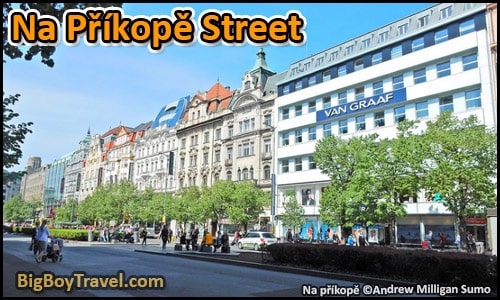
About Na Příkopě Street : Following the path of Prague’s former Medieval moat , Na Příkopě Street is a modern tree-lined boulevard with great shopping opportunities. The moat was slowly filled in after New Town was established in 1348 making the old moat and wall that surrounded Old Town Prague unnecessary. If you have been to Vienna, Austria you’ll notice now Na Příkopě feels a lot like the Ringstrasse which was also built on the path of its own former Medieval wall.
Because Na Příkopě street is a bustling avenue full of distractions, you have to make sure to keep an eye out for its hidden gem. Spanning the entrance to Nekázanka Street are a twin set of beautiful enclosed bridges which resemble the Bridge of Sighs in Venice Italy. We really haven’t been able to find much more information out on the elevated twin corridors yet, but they are very cool.
Further down Na Příkopě, religious history lovers will want to take note of the Church of the Holy Cross. This church once held one of only 40 authenticated copies of the famed Turin Shroud . The Shroud was given to Bohemia by the Archbishop of Turin, Italy in 1651. While it has since been moved to a Benedictine monastery in Broumov, also known for its mummies, it remained the only copy of the Shroud held North of the Alps.
24. Museum of Communism :
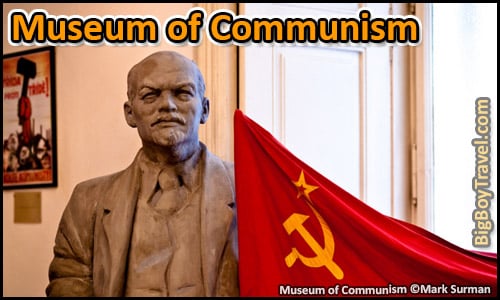
About The Museum of Communism : After nearly 400 years of Hapsburg rule ( 1526-1918 ), the people of Czechoslovakia quickly found themselves under 50 years of oppressive Communist rule ( 1948-1989 ) following WW2. During their reign, the Communists arrested over 200,000 Czechs, shot 327 of them, and terrorized many more. The Museum of Communism highlights the horrors through photos, videos, and examples of propaganda. Our favorite is the gallery on the peaceful Velvet Revolution that united the people and forced out Communism in 1989.
Hours : Daily 9am-8pm. Cost : 290 CZK; Kids under 10 free with Adult; Student and Family tickets available. Museum Website : ( HERE ).
25. Estates Theater :
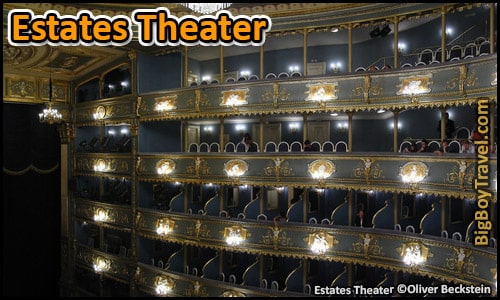
About The Estates Theater : Standing alone in the middle of a square, the historic Estates Theater opened in 1783. Among the venue’s accolades, in 1787 Mozart conducted the world premiere of Don Giovanni here and in 1983 the movie Amadeus was filmed here. Because most of the others have burned down, the Estates is one of the last remaining wooden opera theaters from its era in the world.
Before leaving the theater, make sure to check out the bronze cloak statue near the entrance by the famous Czech sculptor Anna Chromý called the Cloak of Conscience ( artist website ). The hallow cloak figure is part of a larger series which also has variations housed in Athens, Salzburg, Monte Carlo, the Vatican and over a dozen other cities. Her coolest version is made out of stone which is the largest statue ever carved out of Carrara Marble and can accommodate 2 people standing inside it. Chromý’s Cloak of Conscience 1st appeared in a painting she made which was inspired by Mozart’s play Don Giovanni, so the Estates Theater is a fitting place to have a copy of the statue. In the painting, a nude female body representing the vibrant beauty of youth lays in contrast to an empty piece of clothing belonging to an old woman weighed down by suffering and the cares of a long life.
Theater Website : ( HERE ).
26. Havel’s Market ( Havelský ):
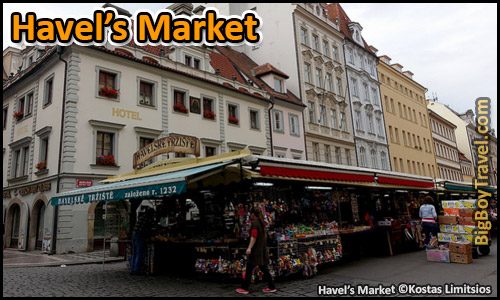
About Havel’s Market : Sitting in an alleyway type road with covered stalls, Havel Market has tons of fresh fruit, vegetables, crafts, and souvenirs. The market dates back to 1232 and is named after Václav Havel who was the last President of Czechoslovakia ( 1989–92 ) and the first President of the new Czech Republic ( 1993–2003 ). He was an author and leader in Human Rights in the 1970s which got him in jail, but his role in the peaceful Velvet Revolution against Communism in 1989 led to his Presidency. Havel is widely known for bringing Democracy to the Czech people.
At the Southwestern end of the market is Uhelný Trh Square which was the Coal Market back in the day. In the middle of the old Coal Market is a small but cute fountain from 1797 showing a boy and girl playing with fruit under a tree.
Market Hours : Daily 9am-6pm.
27. Sex Machines Museum :
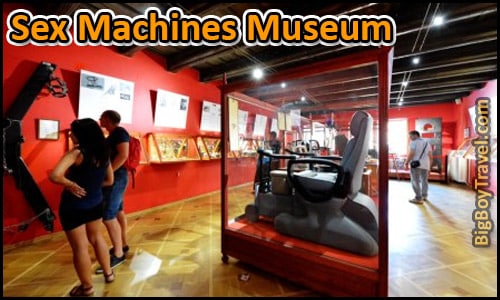
About The Sex Machines Museum : No you’re not in Amsterdam, there is actually a World-class sex machines museum right in the center of Prague. With an exposition spread over 3 floors are more than 200 mechanical erotic appliances as well as art, clothing, and objects from adult films. A trip to the museum really doesn’t really feel pornographic at all and can be quite interesting. The craziest thing we saw while visiting was a steam-powered mechanical dildo from the 1800s. One of the most popular exhibits shows old erotic films that date back to the beginning of cinema. Two full-length films from 1925 are on display and were said to have been personally made for Spanish King Alfonso XIII.
Hours : Daily 10am-11pm. Cost : 250Czk. Age Requirement : Must be 18 or over to enter. Website : ( here ).
28. Colorful Medieval Homes :
About The Colorful Medieval Homes : As you re-enter the Old Town Square check out the extremely old homes next to the double Gothic arch that span Melantrichova Street. #27 is known as the At the Ox House , was built in the early-Middle Ages and serves as the base for the arch ways. Even more impressive is the neighboring home at #26 called the Stepanovsky House which was originally built in 1170 and has a door original to the 1500s, houses a Starbucks on the bottom floor today. It may be fitting to stop at get a drink in the beer garden in front of #25 called At the Blue Goose House as it served as a wine shop and tavern throughout the Middle Ages.
Directly across from the At Minute House at #29 lies the At Black Angel which actually has a Gold not Black Angel above the door. It is the former location of Church of St. Michael, housed a Gothic Chapel in the 1400s, and today houses the U Prince Hotel. The Hotel’s Black Angel Bar ( website ) is probably the coolest bar in town with its cave like but classy appearance although it is a little pricier than the surrounding beer gardens.
Other Sites Near Old Town Prague:
30. Jewish Quarter Walking Tour : Prague Jewish population has been living in the small neighborhood known as Josefov for over 100 years before the City of Prague was even officially established. Over the centuries there have been both good time and conflict that have forged together into a rich Jewish history. Filled with beautiful synagogues, a gnarly cemetery, and many other worthwhile attractions, a walk through the Jewish Quarter in Prague is a very worthwhile couple hours. View This Walking Tour : ( HERE ).
31. National Puppet Theatre ( Marionette ): The National Marionette Theatre opened in 1991 inside The Kingdom of Puppets Theatre ( Říše Loutek ) built in the Art Deco style to perform a marionette version of Don Giovanni. It is a fitting home to the show as Prague is where Mozart premiered Don Giovanni. Theater Website : ( HERE ).
32. Image Theatre : The Image Theatre is a truly unique experience where dance, storytelling, optical illusions, black lights, neon, and artistry all blend into a seamless collection of showmanship. The troop has been operating since 1989 and have an entire collection of established shows they rotate through their 7 days a week performances. It really is a refreshing twisting on entertainment. Cost : 480 CZK. Hours : Shows are typically at 8pm but they sometimes add a second performance at 6pm. Address : Pařížská 4. Theater Website : ( HERE ).
33. Jubilee Synagogue : Also known as Jerusalem Synagogue for its location on Jerusalem Street, the Jubilee Synagogue is by far the most colorful and vibrant in all of Prague. This awesome Synagogue was built in 1906 and is as wonderful inside is out making it a favorite among photographers. It gets it name from the 50th anniversary of the rule of Franz Josef I. Its bright pink, blue, and yellow colors gleam on a design that blends Moorish and Art Nouveau architectural styles. It wasn’t until 2008 that this popular beauty finally opened its doors to non-Jews and tourists, but we are glad they finally did. The detailed interior with elegant ceilings, bright colors, and arabesque art will make you feel as if you are in an exotic Mosque in Istanbul. Jubilee is a treat that really will make you feel jubilee and since it is right by the train station you have no excuse not to check it out. Hours : Sunday-Friday 9am-4:30pm; stays open until 6pm April-October; Closed Saturdays for the Jewish Sabbath.
33. Lesser Town Walking Tour: Lesser Town, also known as the Little Quarter fills the Western bank of the Vltava River tucked under the shadow of the historic Prague Castle. Many tourists only briefly walk trough Lesser Town on their way to the Castle and miss out on a bunch of great sights. Our free walking tour of the Little Quarter will help make sure you get the most out of your visit.
34. New Town Walking Tour: In 1348, King Charles IV established New Town Prague which greatly expanded a City that was overflowing the walls of Old Town. New Town is centered around the very long, almost boulevard-like, Wenceslas Square which has an important place it Czech history. It is here where the peaceful Velvet Revolution took place in 1989 which helped to end Communist rule. Within just a couple blocks of Wenceslas Square are a number of great sights that we highlight on out free New Town Walking Tour.
Melantrich building where Václav Havel talked to crowds during the Velvet Revolution.
Featured Article

Sign Up For Our Newsletter For Free Travel Tips
Email Address *
Disclaimer: Information on this page and in our walking tours were deemed accurate when published, however, details such as opening hours, rates, transportation, visa requirements, and safety can change without notice. Please check with any destinations directly before traveling.

The Best of Prague: A Prague Walking Guide
Medieval, magical and inviting… Prague is one of Europe’s most memorable cities that continues to awe me time after time, even after a handful of visits. The allure of the Charles Bridge on an icy morning in January, the beauty of a sunset in the warm summer nights and even the city covered in a thick layer of snow that brings your fingers to freeze through thick woollen gloves – there has been no time in Prague that I haven’t felt completely embraced by this intriguing city. And yet while Prague may look like a small town riddled with tales to span centuries, the city of Prague is sprawling with many different neighbourhoods offering their own unique flair. Here’s how to discover the best of Prague in a self guided Prague walking guide.
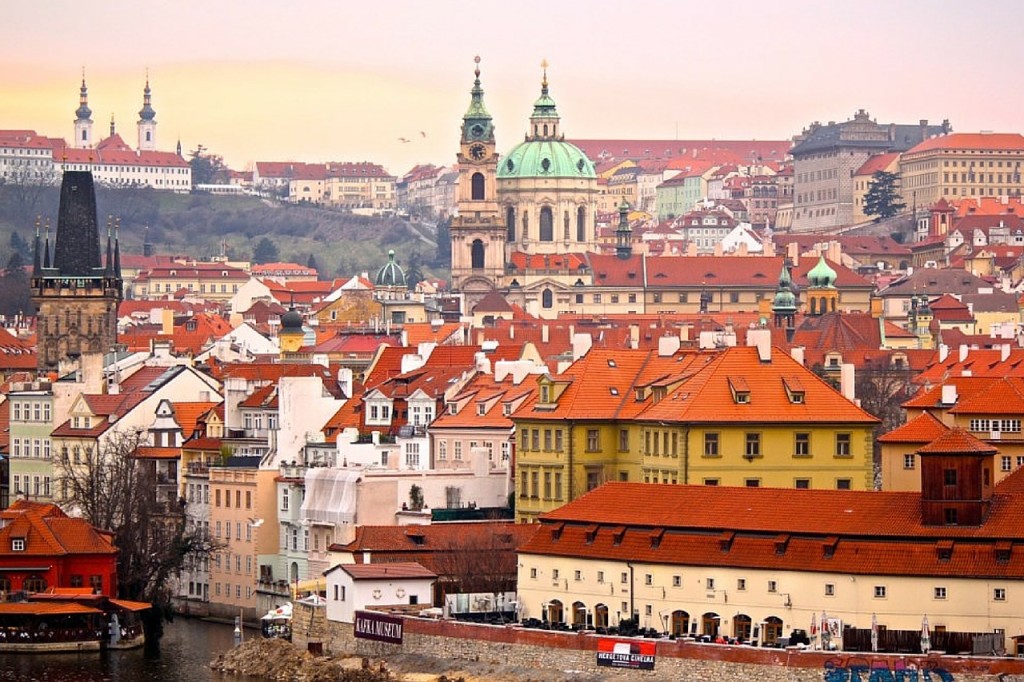
Know Before you Go: Prague for First Timers
If this is your first visit to Prague you have likely seen the postcard views, intriguing architecture, and perhaps fallen victim to the eery allure of the Charles Bridge on a winter’s morning. Each season brings a new feeling to the city of Prague, but in all honesty there is no bad time of year to visit. The first time I visited Prague was in a thick layer of knee-high snow in 2012, followed by a spring visit a couple of years later. The last time I found myself in Prague was at the end of Autumn and beginning of winter, but even an in-between season visit brought the magic of Prague I have come to know and love. It is without hesitation that I say the best way to see Prague is on foot, so be sure to pack some comfy shoes, a bottle of water, some cash for the endless amount of pitstops you are about to endure and get ready to see Prague!
Route walking time: 1 hour, 20 minutes without stops
Distance: 5.9 kilometres
1. Vrtba Garden
Although an unlikely and often unheard of point to commence your walking tour of Prague, Vrtba Garden is the perfect positioning to begin exploring the Prague’s lesser quarter. Built between 1715 & 1720, the garden was constructed in traditional baroque Italian style, with perfectly trimmed hedges in symmetrical formation. Not only is this a perfect escape from the hustle and bustle outside of the entrance, Vrtba Garden also offers magnificent views of the surrounding landscape, making it the perfect positioning to commence your walking tour of Prague. This is one of Prague’s few “lesser known” attractions that any visitor will tell you you cannot miss, so be sure to make the most of this insider tip and allow yourself a good hour here in the serenity!
What: Jardin vrtbovská
Where: Karmelitská 373/25, 118 00 Praha 1-Malá Strana, Czechia
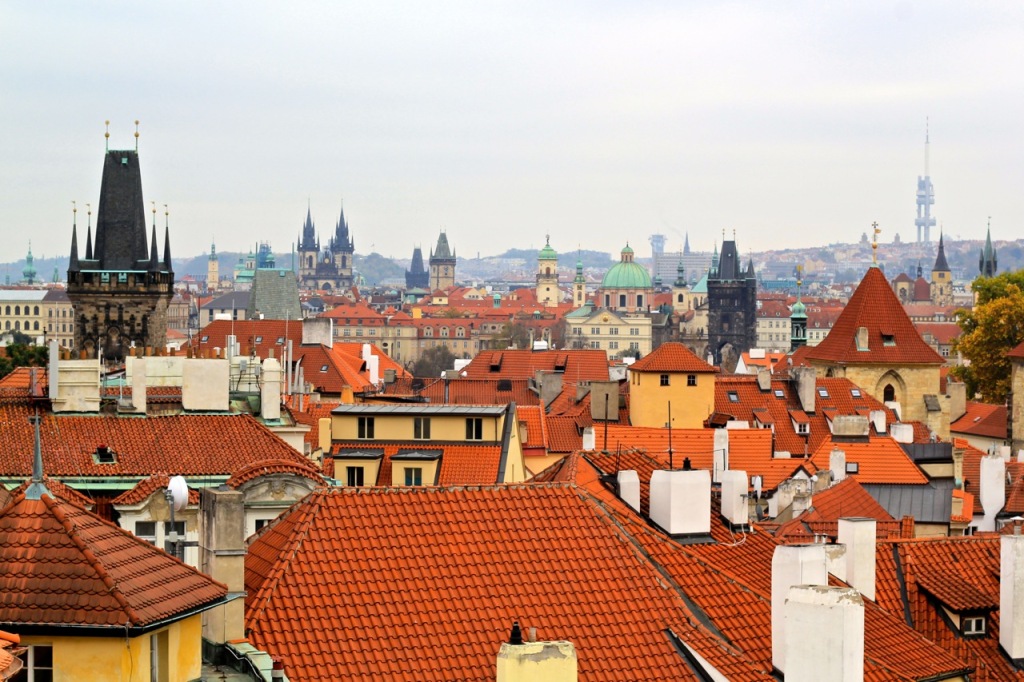
2. St. Nicholas Church
From the Vrtba Gardens, take a left toward St. Nicholas Church, a short 350 metre walk away. This church serves as a central point in the lesser quarter of Prague, where you can see the livelihood of this neighbourhood at every turn. Step inside to marvel at the baroque architecture of this church, which replaced a 13th century gothic church that was also dedicated to Saint Nicholas.
What: Baroque Church in Lesser Prague
Where: Malostranské nám., 118 00 Praha 1-Malá Strana, Czechia
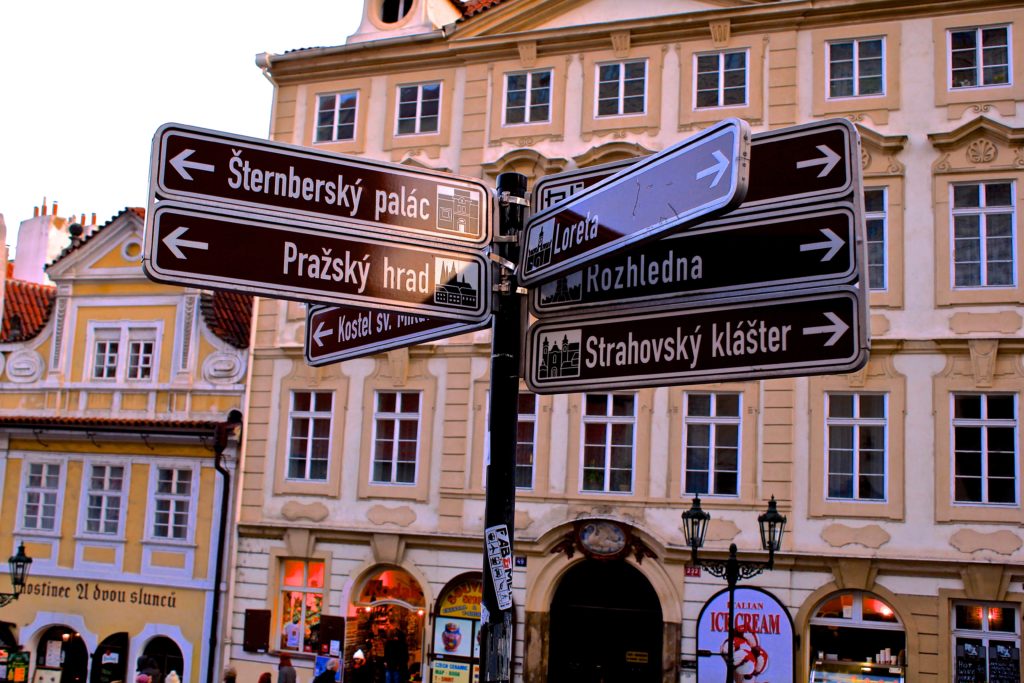
3. Prague Castle
From the Church of Saint Nicholas, get ready to begin your upwards climb towards Prague Castle. Be sure not to miss Pražská čokoláda (Prgaue Chocolate), located at the base of the stairs and famous for their chocolate covered almonds (with free samples!) Be sure to allow at least an hour or more to explore the Prague Castle complex, as there is much to see once inside. This is also one of the most confusing castles to visit in Europe (if you ask me), with no clear indication of where to head next, so be sure to consider a hosted guide or at the very least an audio guide if you wish to make the most of your visit. The 9th Century Castle attracts many visitors each year, all vying for their photo of the straight-faced guards placed at the entrance to the castle. Be sure to drop by Golden Lane for a look at some artisanal shops, before heading onwards to St. Vitus Cathedral.
What: 9th Century Castle
Where: 119 08 Prague 1, Czechia
4. St. Vitus Cathedral
Located next to Prague Castle you will find St. Vitus Cathedral, home to the Archbishop of Prague. The history of this Roman Catholic church is almost as old as Prague itself, so be sure to step inside for a step back in time.
What: Gothic Cathedral
Where: III. nádvoří 48/2, 119 01 Praha 1, Czechia
5. Lennon Wall
Heading back down-hill, be sure to stop by the Lennon Wall before stepping foot on Prague’s most photographed attraction: The Charles Bridge. Just before you cross the bridge toward the Old Town of Prague, you will find this graffiti wall inspired by John Lennon, complete with song lyrics and peace signs, which was created in the 1980’s.
What: Lenon-inspired graffiti wall
Where: Velkopřevorské náměstí, 100 00 Praha 1, Czechia
6. Charles Bridge
Onwards to the Old Town, you absolutely cannot miss the chance to walk across the Charles Bridge: the reason many visitors choose to visit Prague! This historic bridge crosses the Vltava River and is hands down the biggest highlight of the city. Although overcrowded on a good day, the best way to see the bridge is once in the morning, once during the day, and once in the evening. The bridge boasts 16 arches and is lined with a total of 30 Baroque statues and figurines.
What: Historic Bridge named after King Charles IV
Where: Karlův most, 110 00 Praha 1, Czechia
Completely surrounded by the Old Town, Josefov is a time warp neighbourhood previously known as the Jewish ghetto. As one of my favourite neighbourhoods to wander in Prague, today you will find an abundance of antiques stores, clock stores, postcards and souvenirs. One of the must see places in Josefov is the Hebrew clock on top of the Old Town Hall – located underneath the regular clock and running backwards.
What: Former Jewish ghetto
Where: Josefov (neighbourhood)
8. Old Town Square
As the historic centre of Prague, one absolutely cannot miss a visit (or a few visits!) to the Old Town Square of Prague. The various architectural styles are evident in one 360 turn, with an abundance of village life and attractions to visit within a short distance of one another. The best way to experience the Old Town is to wander through the many alleyways and boutiques without a plan or direction.
What: Historic Square in the Old Town
Where: Staroměstské nám., 110 00 Praha 1-Staré Město, Czechia
9. Prague Astronomical Clock
Whilst in the Old Town be sure to wander over towards the large crowds to get a glimpse of the Astronomical Clock – full of legends and mystery.
What: Medieval Astronomical Clock
Where: Staroměstské nám. 1, 110 00 Praha 1-Staré Město, Czechia
10. Wenceslas Square
After a complete history lesson of the oldest parts of Prague, head towards Wenceslas Square in “New Town” for a look at real Prague or more accurately, where you’ll find locals in one of the busiest shopping areas in the city. It is here where you will find many international brands and designers.
What: Main shopping area
Where: New Town, 110 00 Prague 1, Czechia
11. Prague National Theatre
Onwards toward the Vltava River, make your way to the Prague National Theatre. Along the way you will pass by Cafe Louvre – one of the gorgeous time-warp cafes I would recommend a pitstop at for a coffee or hot chocolate. Another great cafe stop is right by the National Theatre, named Cafe Slavia, one of the oldest cafes in Prague where a pianist plays in the evenings, coat check is a must and smoking inside is still fashionable.
What: National Theatre to enjoy Opera & Ballet
Where: Národní 2, 110 00 Praha 1, Czechia
12. Vltava River
Walking along the Vltava River, this is undeniably one of my favourite strolls in all of Central Europe! Along the way you can marvel at the architecture to your left, whilst taking in the gorgeous views of the Vltava River on your right.
What: Longest river in the Czech Republic
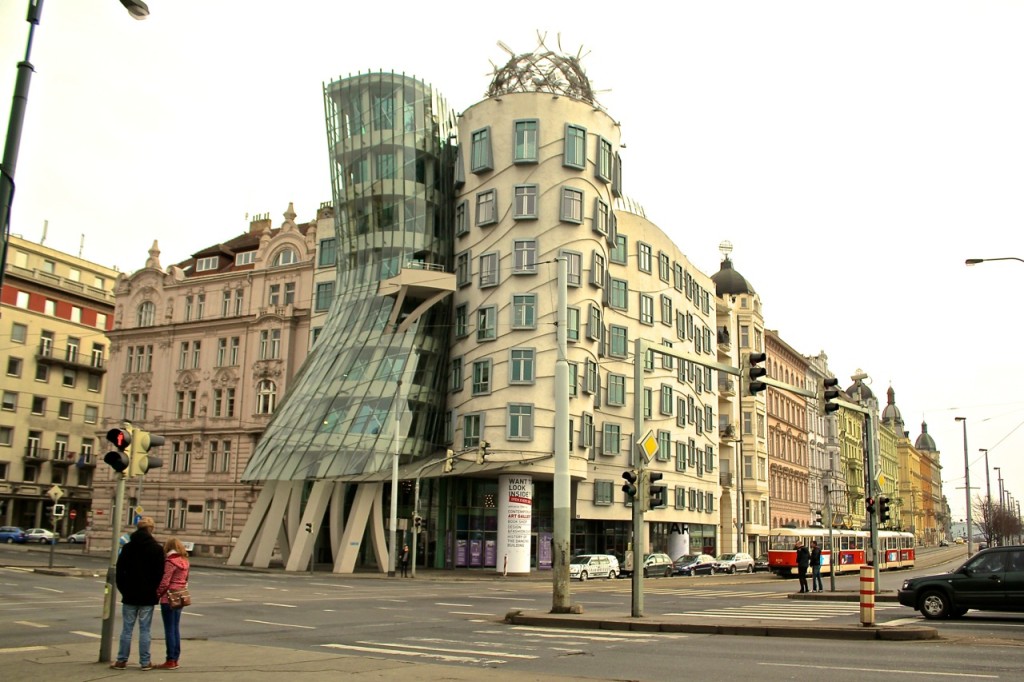
13. Fred & Ginger’s Dancing House
Finally, end your walking tour of Prague at the must-see-to-be-believed Fred & Ginger “Dancing House”. Although out of the way, it is here where you will see the sprawling size of the city of Prague, view of the old trams as they pass by and take in the views of the Vltava River.
What: Architectural marvel
Where: Jiráskovo nám. 1981/6, 120 00 Praha 2-Nové Město, Czechia
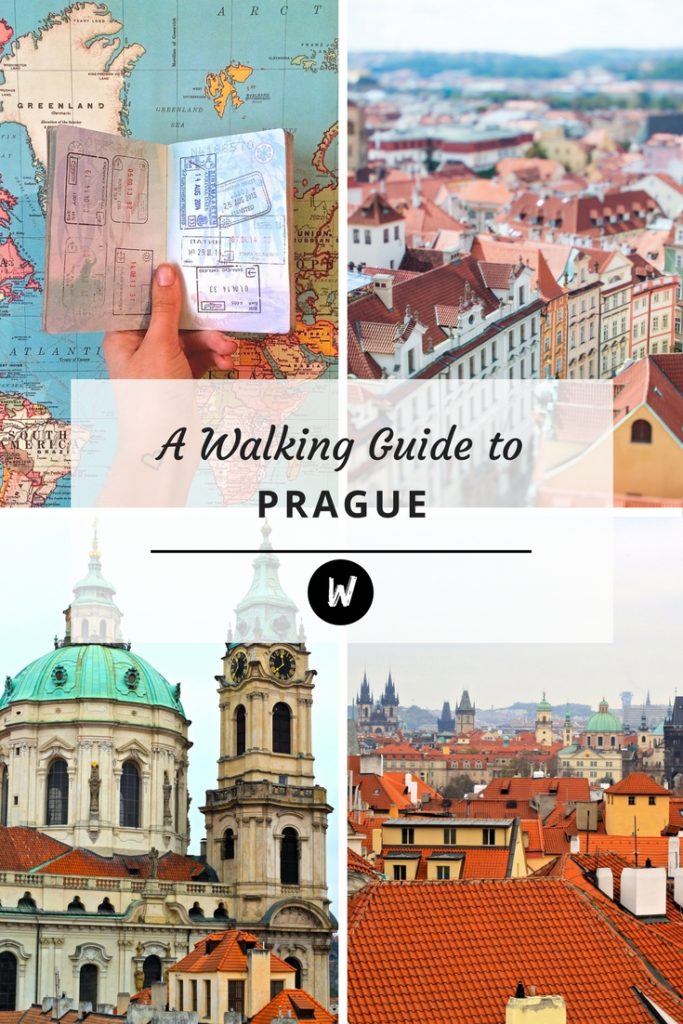
Over to you! What were your highlights from Prague!?
Brooke Saward founded World of Wanderlust as a place to share inspiration from her travels and to inspire others to see our world. She now divides her time between adventures abroad and adventures in the kitchen, with a particular weakness for French pastries.
Find me on: Twitter | Instagram | Facebook
Los Angeles
Plan a trip
First trip solo
Packing guide
20 Best Places for Solo Female Travel
Travel after a break up
20 Places in your 20’s
WAYS TO TRAVEL
Solo travel
Adventure travel
Luxury travel
Learn a language
Become a blogger

Prague’s Jewish Quarter, Your Self-Guided Walking Tour of the Best Things to See and Do in Josefov [UPDATED 2023]
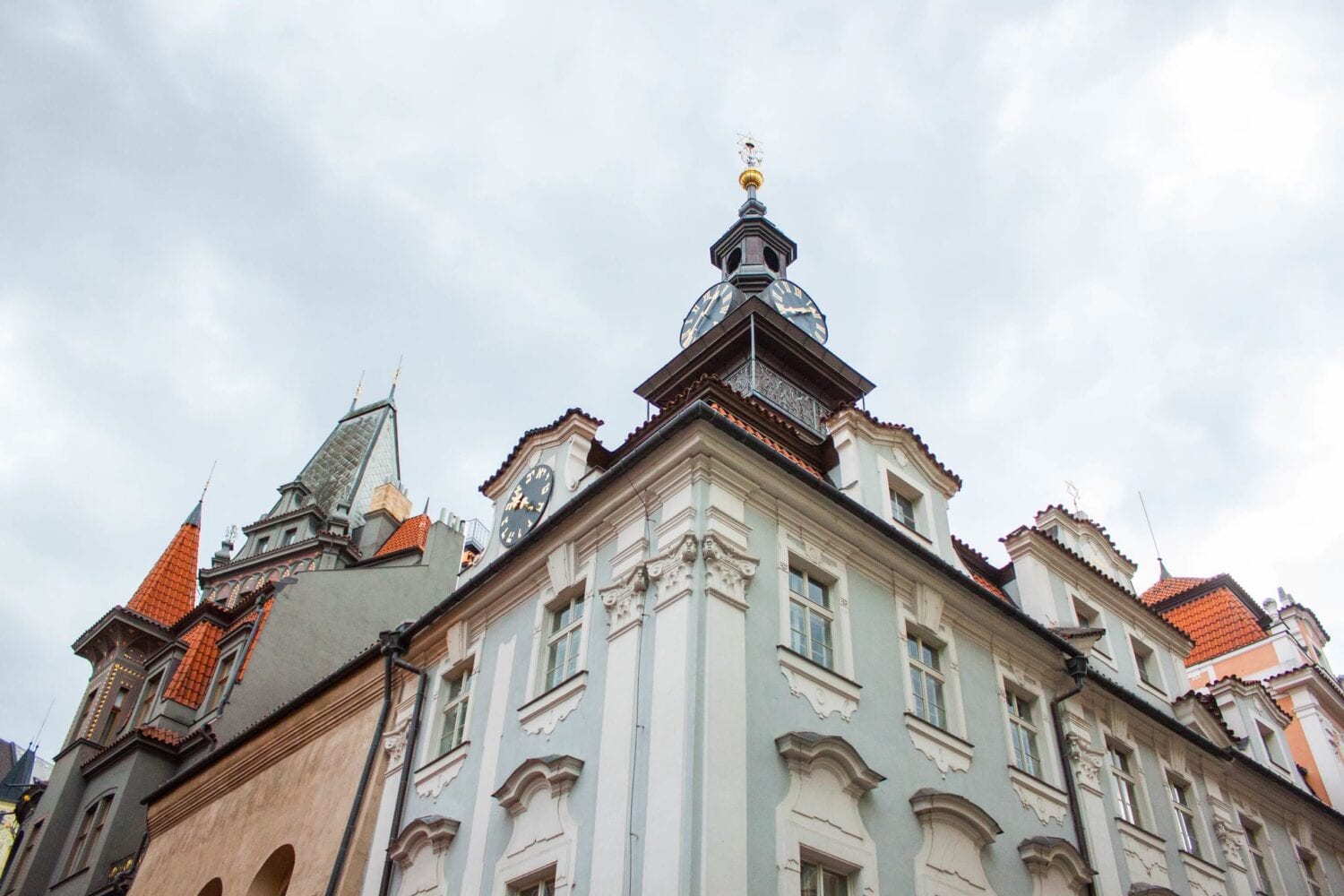
The Jewish Quarter , or Josefov as it is called in Czech, is the smallest of Prague’s neighbourhoods and yet perhaps is the one filled with the most intense and powerful history. Although some of these histories are rather dark, these streetst today are filled to bursting with joyful life. The echoes along the cobblestones feel like the voices of the people who once called this place home. Many of the area’s most important buildings were spared from destruction during the war, leaving these stretches a historic wonderland. Today, walking down these streets, you can literally touch history and walk through doorways to discover secrets from the past.
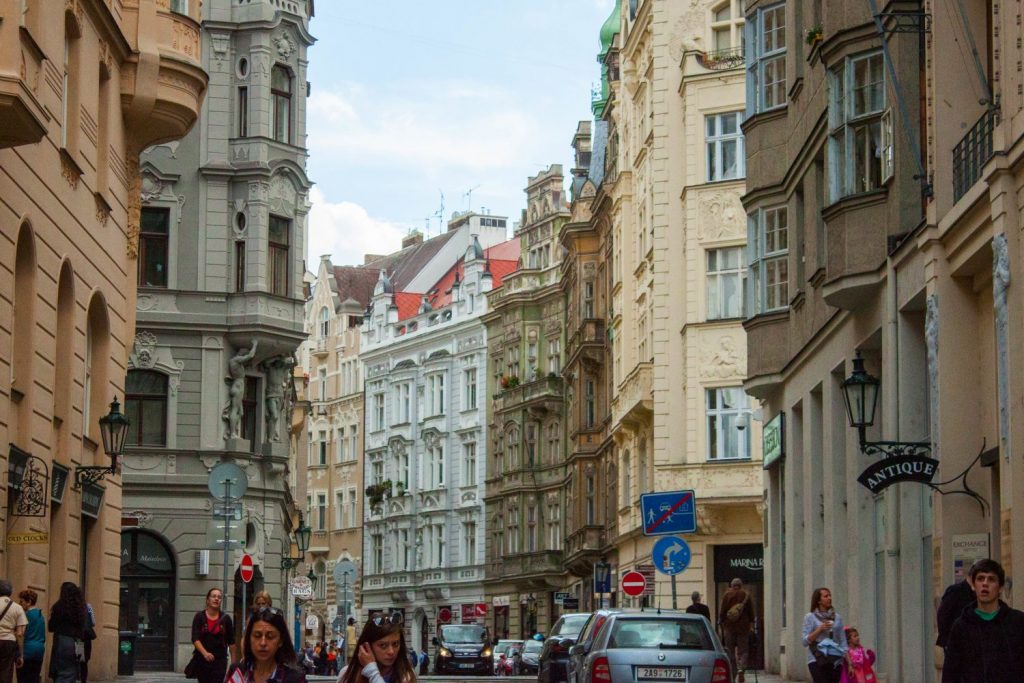
Prague’s Jewish Quarter is between Prague’s Old Town Square and the Vltava River . Our starting point is at the Robert Guttmann Gallery , only a 3-minute walk away from Old Town. Even if you’re coming from the other side of town, in the Castle district, Josefov is only a 20-minute walk. If you need to access the area by tram, the nearest tram stop is Právnická fakulta. But my favourite way to get around Prague is on foot.
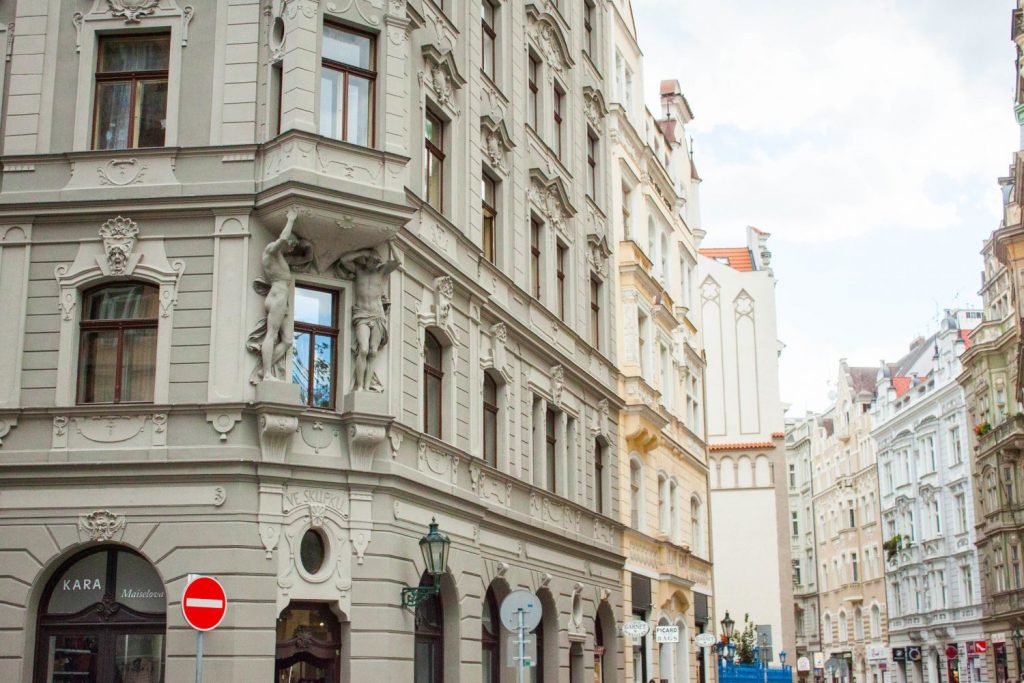
Prague’s Jewish Museum
Most of the Jewish Quarter has been reestablished with the help of Prague’s Jewish Museum . While most of us might think of a “museum” as a static building, the Prague Jewish Museum is comprised of much more than just one building. The museum contains 40,000 artifacts, over 100,000 documents, and archives of the Czech Jewish population. All of these treasures are spread out over six different historical buildings within the Jewish Quarter. The various exhibitions of these artifacts are located in the multiple synagogues we will visit along the way.
Tickets to the Museum
While this tour covers the building’s exteriors and interiors, the interiors require an admission fee to the Jewish Museum . If you’re on a time crunch, you can visit the exteriors only. But, I would highly recommend going inside. And the Old Jewish cemetery, one of the most impactful parts of the journey, cannot be viewed without an entry ticket.
In addition to the sights you’ll miss, the admission fee you’ll pay helps preserve the history of this part of Prague. Creating more opportunities for future generations. The best way to get tickets is online . There are a variety of tickets available to buy, which will let you into a different combination of the interiors. My advice is to purchase the Jewish Town of Prague Combo Ticket . It costs CZK 550 or $25 USD for adults and 400 CZK or $18 USD for kids. This ticket includes entry to Old Jewish Cemetery, Old-New Synagogue, Spanish Synagogue, Maisel Synagogue, Pinkas Synagogue, Klausen Synagogue, Ceremonial Hall and temporary exhibitons in the Robert Guttmann gallery.
The opening hours for the buildings which make up the Prague Museum are 9 am to 6 pm in the summer. And 9 am to 4:30 pm in the winter.
Be aware that the museums are open every day EXCEPT Saturday and all Jewish holidays . Since most other museums are usually closed on Monday, visiting the Prague Jewish Quarter on a Monday is a great thing to schedule when the rest of Prague’s museums are closed.
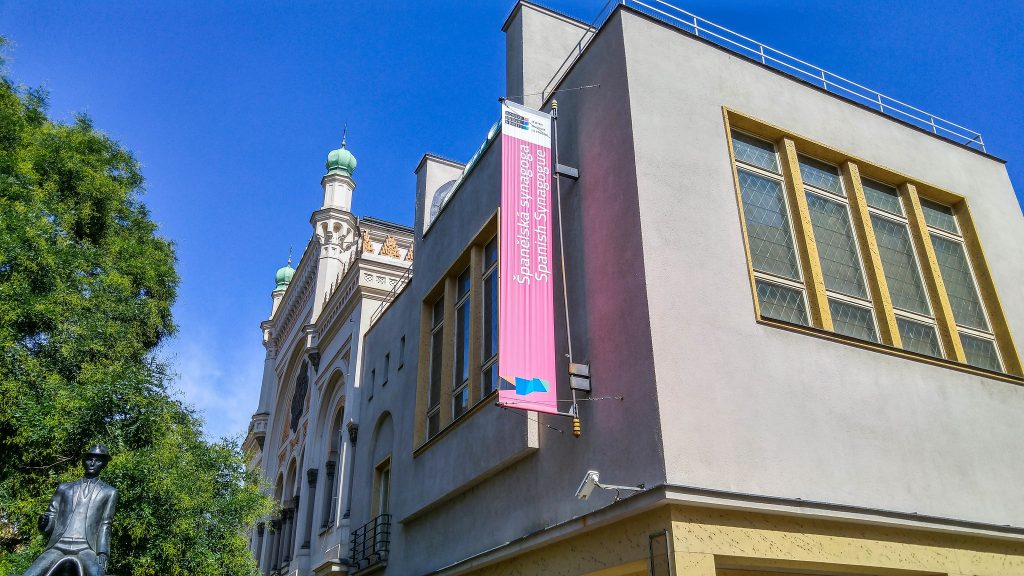
Map of Walking Tour
The streets of Josefov have seen their fair share of sadness and horror over the years. The Jewish Quarter’s dark history began in the 13th century. Riots between the Jewish people and Christians were becoming more and more frequent. To subdue these riots, the Fourth Council of the Lateran ordered the segregation of the Jewish people from the Christians. And the first “Jewish Quarter” was formed. Jewish citizens were ordered to vacate their homes throughout Prague and settle into this one area of the city. Spálená and Vladislavova street were two spots that still exist today where you could find the formations of the Jewish Quarter
The Renassaince in Prague
In the 16th century, Prague saw a kind of artistic and intellectual Renaissance. Academics and creatives from all across Europe began to flock to this mystical city. One of the most famous Jewish people to come to the city was Rabbi Loew . Rabbi Loew published more than 50 religious and philosophical books. Jacob Bashevi was another famous man who lived in this part of the city. And Jacob Bashevi was the first Jewish man to be knighted under the Hapsburg Empire.
But the man responsible for the Jewish quarters Golden Age was the great Mayor Mordechai Maisel . Today you can find one of the synagogues we’ll visit today named after Maisel himself. Maisel was Prague’s Minister of Finance and helped finance the development of the Quarter. He ensured the neighbourhood built new streets to support the growing infrastructure. New streets meant new building and the city had the finances, thanks to Maisel, to employ some of the best architects of the day. Resulting in the fantastical architecture you find in this area today.
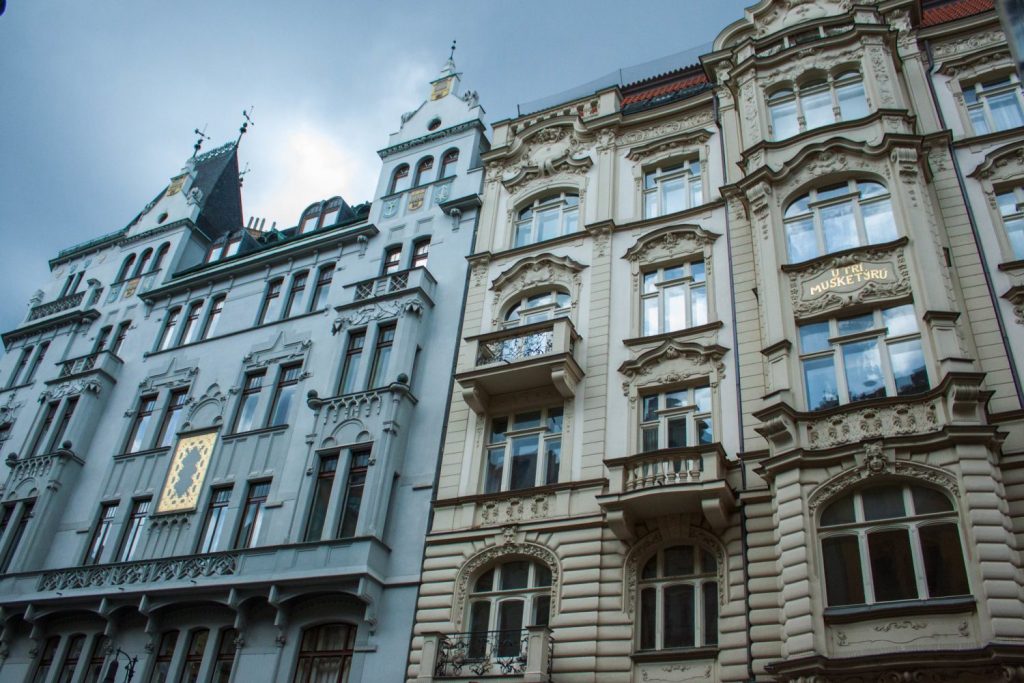
The Czech name ‘ Josefov ‘ for the neighbourhood was inspired by Emperor Josefov II . During his rule, Josefov made it a point to emancipate the Jewish population. Granting them equal rights as citizens of Prague. His mother, Empress Maria Theresa , had only years earlier expelled all the Jewish people from Prague. But once Josefov became the Holy Roman Emperor, he not only reversed his mother’s cruel ruling but also officially recognized their religion.
Josefov also named the Jewish Quarter an official district of Prague and abolished the name “ ghetto ” when referring to the area. At the time, Prague had one of the largest Jewish populations in Europe. Here, they had a dynamic and vibrant Jewish neighbourhood where they could practice their religion, enjoy community festivities and bask in the beauty of the neighbourhood they had built up.
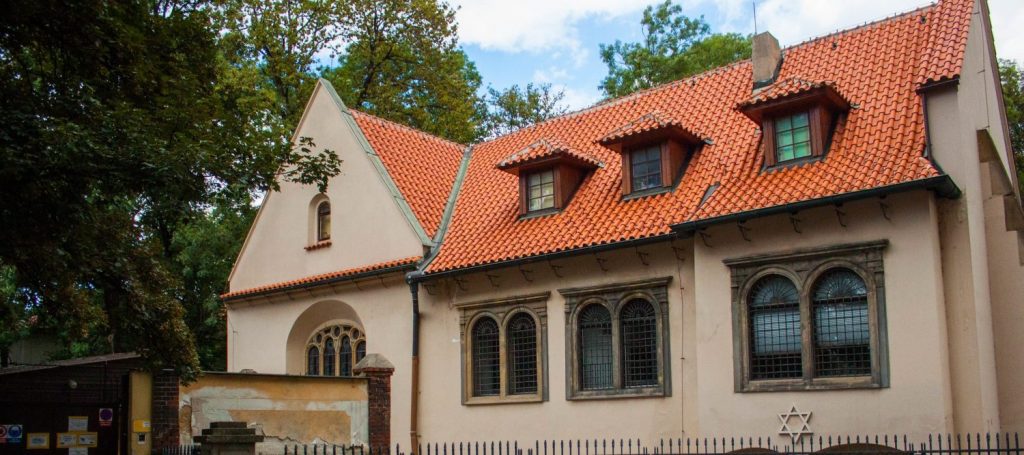
But the good times wouldn’t last forever. In 1939, Germany officially occupied Czech lands. At the time, over 92,00 Jewish people were living in Prague. This accounted for 20% of the population of Prague. As tension and fears began to mount, 26,000 Jewish people fled the country, escaping Germany-occupied cities. The remaining Jewish citizens were eventually imprisoned in concentration camps in Terezin and more than 80% were deported to Auschwitz .
Over 97,000 Jewish people from Prague and all over the Czech republic died in WWII. Only about 15,000 Jewish Czech people survived. More than half of these Jewish people chose to move to Israel after the war. Few chose to return to Prague. The memories of the past too painful to face. As you walk along the cobblestone roads and gaze at the incredible architecture, take into your memory the people who lost their lives and never got to return.
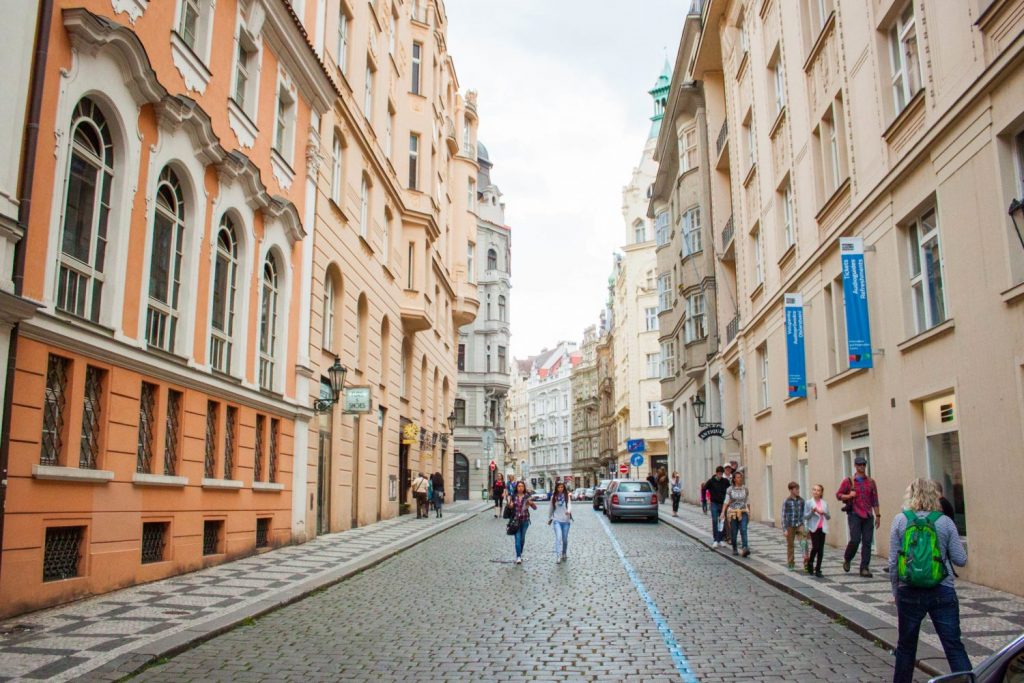
The Preservation of the Jewish History of Prague
During World War II, after Hitler’s invasion of Prague, he made a surprising decision. Instead of burning and destroying all memory of the Jewish people, Hitler had his army collect almost all of Prague’s Jewish memorabilia. And preserved their synagogues. But his reason for doing so wasn’t out of any sort of pity or compassion. Prague’s Jewish history was only spared so Hitler could create his planned “ Museum of an Extinct Race. ” Millions of Jewish people across Europe perished during the Holocaust. But not all was lost.
After the war was over, the survivors freed, and the occupied cities restored, historians took back the stolen objects and artifacts taken in Prague. Despite over 60 synagogues across the Czech Republic and Europe that were destroyed, the ones in Prague remained.
Prague’s Jewish Quarter was now truly a precious treasure. As it contained such a large wealth of Jewish history in such a small area. In the 1980s, people began flocking to the city to marvel at its “Precious Legacy.” This was a new term was coined by the newly formed Prague Jewish Museum. They made it their mission to educate people and protect their beloved cultural histories.
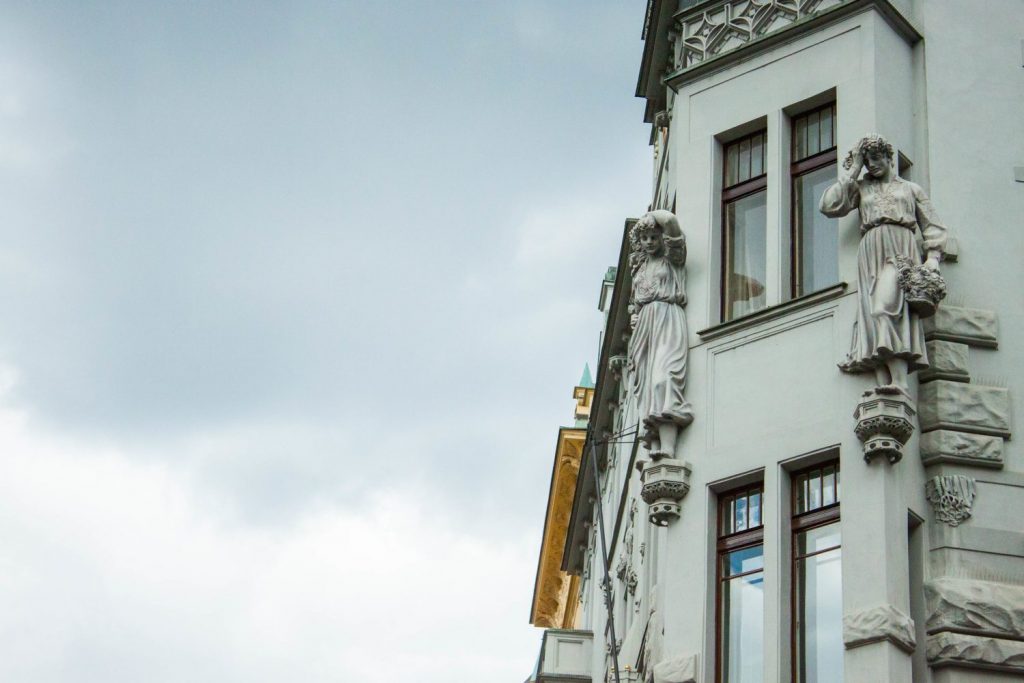
Robert Guttmann Gallery
I think one of the best places to start this tour is at the Robert Guttmann Gallery . Entry into this gallery is included in the admission to the Jewish Museum . This gallery featured images, art and artifacts from Jewish life in Prague. Here you’ll see old photos of buildings we’ll explore later in the walking tour. It will also help you learn more about the Jewish people who came to Bohemian and Moravian. And all about the persecution they suffered over the years.
I think the information presented here in the gallery helps contextualize the rest of the tour. It makes the fact that we can still see these buildings, that they were not lost, all the more powerful. In addition to the historical galleries, there are also temporary exhibitions that focus on modern Jewish visual art and artists.
View this post on Instagram A post shared by Tatyana (@skrbrka)
Spanish Synagogue
After touring the gallery, get outside and head over to the Spanish Synagogue . The Spanish Synagogue stands in the spot where the oldest Synagogue in Prague, the Old School Temple , once stood. This Old School Temple Synagogue dated all the way back to 1142. But in the 19th century, the Old School synagogue wasn’t big enough for the growing community. So the new Spanish synagogue was built and the old one torn down.
The Spanish Synagogue is built in Moorish Revival Style, defined by its muscular horseshoe arches, the onion-shaped dome, and its intricate and ornate decorative patterns. These beautiful patterns can be found on both the exterior and interior decor. After being handed over to the Jewish museums in 1958, the museum found the synagogue needed a lot of restoration. This restoration wasn’t completed until 1998, when it was finally restored to its original beauty.
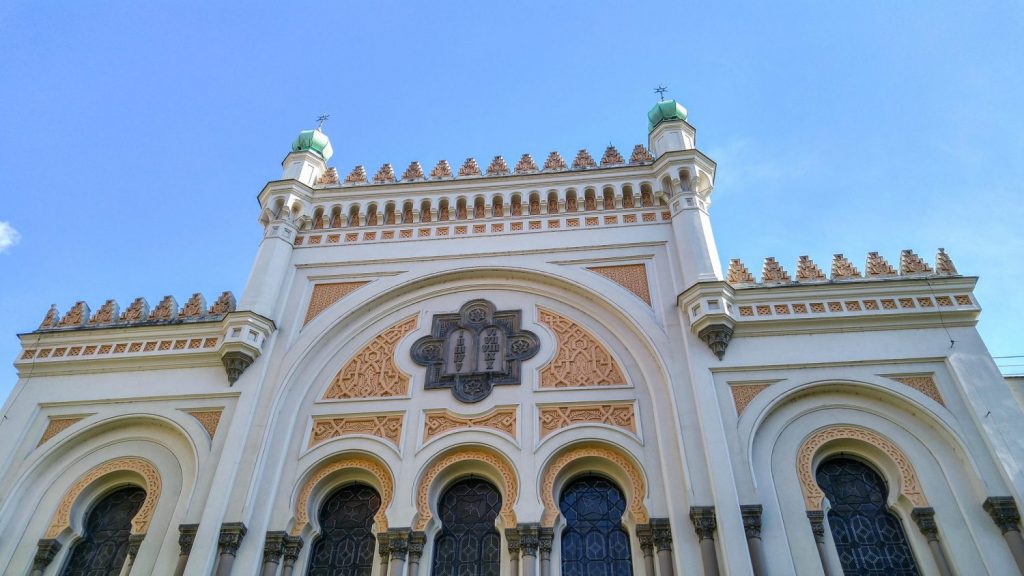
Interior of the Spanish Synagogue
You cannot visit the Spanish synagogue without stepping inside. The white exterior hides an absolutely spectacular secret. Stepping in the front doors, you’re immediately struck with a cacophony of colours and patterns. High above your head is the famed stained glass window of Magen David, designed in 1882.
View this post on Instagram A post shared by Ritsa Demetriadou (@ritsa.demetriadou)
With everything going on around you, you might not think to look down at your feet, but I implore you to do so! You’ll marvel at the incredible gilded and polychromic arabesque parquet floors that spread throughout the synagogue. Arabesque flooring is defined by its use of flowers and foliage interlaced to create this mesmerizing pattern. Every inch of this interior is covered in decorations, and the place seems to vibrate from all the gold inside.
High above your head is the grandiose vaulted cupola. It is covered in lavish gilded decorations and vibrant colours. The skylight, in the shape of the star of David with pale red points, allows light to flow into the interior. Illuminating the room with a heavenly glow.
View this post on Instagram A post shared by 蠣崎です/Itsuki Kakizaki (@vagabondejaponaise)
Kafka Memorial
On the north side of the roundabout outside the Spanish Synagogue you’ll see the tall, puzzling statue of Franz Kafka . This was designed by artist Jaroslav Róna . Despite writing all of his literature in Germany, Franz Kafka was a prodigy from Prague. He was born in Prague and grew up in the old Jewish Quarter. His bar mitzvah was held at another stop on our tour; the Old-New synagogue .
Kafka’s memory and influence lives on through these little dedications found throughout the city. Kafka is most notable for his writings focused on anxiety and alienation. No doubt influenced by his life as a Jewish man in Prague’s Jewish Quarter. This statue in the square depicts the images of Franz Kafka atop the shoulders of a headless figure. This piece was a reference Kafka’s 1912 story, “ Description of a Struggle .”
View this post on Instagram A post shared by Katerina Kutnohorska (@katkutnohorska)
Pařížská street | Paris Street
Continue walking down Široká until you reach Pařížská street . This is also known as “Paris Street.” Along Paris Street is where you’ll find high-end designer shops and trendy cafes. Inspired by the tree-lined avenues of Paris, Pařížská street saw a massive redesign in the 20th century. Happily for us, this took place during the height of the Art Nouveau period! Therefore most of the buildings in the Jewish Quarter are designed within that umbrella. While baroque is the predominant style of architecture throughout the rest of the city, the Jewish Quarter gets to flaunt this distinct style. The intersections of Pařížská and Široká are where you can find the most stunning examples.
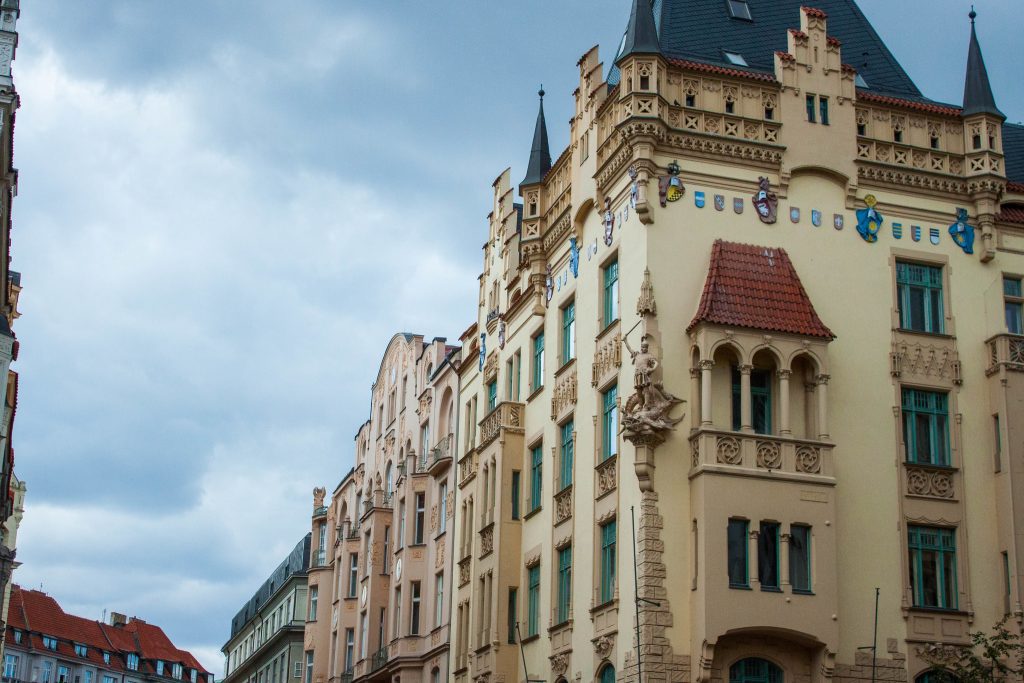
Restaurace U Stare Synagogy
Take a stroll down Červená street . One of the most incredible examples of Art Nouveau architecturecan be found at the Restaurace U Stare Synagogy. This restaurant, located beside the High Synagogue , was built in 1907 by architects František Weyr and Richard Klenka .
While most art nouveau buildings in Prague are covered in white or pale pastel stucco, this building is painted a dark grey. And in some lights, I swear it is almost purple! This makes it stand out against the rest of the surrounding structures! The building is trimmed in bright gold ornaments. And its red-tiled roof is complemented with dark wood trim and wrought iron flourishes. In the early 1900s, the Czech Republic was a part of the Austro-Hungarian empire. As such, the Art Nouveau style we find in Prague is more reflective of the Austrian Secession Style.
View this post on Instagram A post shared by ST∆RDUST (@unicorn.stardust)
High Synagogue
Walk down the narrow Červená lane. Make a stop outside the unassuming beige stucco building with a steep red roof. This is one of the most elite synagogues in the Quarter, hidden inside these walls. This is the High synagogue or ‘ Vysoká synagoga ‘. “High” refers to the fact that it was built on the first floor, above ground level, to prevent the constant flooding the rest of the city suffered from. The High Synagogue was also located inside what used to be the Jewish Council of Elders room .
High Synagogue Interior
The interior was transformed into a space modelled after the great High synagogue built in Krakow in the 16th century. Mordechai Maisel donated the funds for its construction and granted the city a few of his personal historical pieces to be housed here. These included such precious items as his ancient Torah and silver pointer. Spared from the war were hundreds of old Hebrew books which were of great importance to the Jewish people.
Today, the synagogue’s interior is the best preserved of all the ones in the Quarter. Unfortunately, it is not open to the public. Standing outside the walls, let me help you picture the interior. Or refer to the pictures below. High gothic ribbed vaults cover the ceiling and gilded stucco rosettes decorate the peaks of the vaults. A candleabara and menorah sit on either side of the niches between the great Torah placed in the centre of the Synagogue.
View this post on Instagram A post shared by Mystery of Jerusalem (@mystery_of_jerusalem)
Jewish Town Hall
Walk a few more steps towards to the corner of Maiselova and Červená street. Here we come to find the great Jewish Town Hall . Although the original building was destroyed in a fire in 1754, this new version retains the Rococo designs of the original. The town hall was used as a local meeting house for the Jewish community. The building was, once more, financed by Mordechai Maisel , who at the time was the richest man in Prague. The older name for this building was actually the Maisel Town Hall.
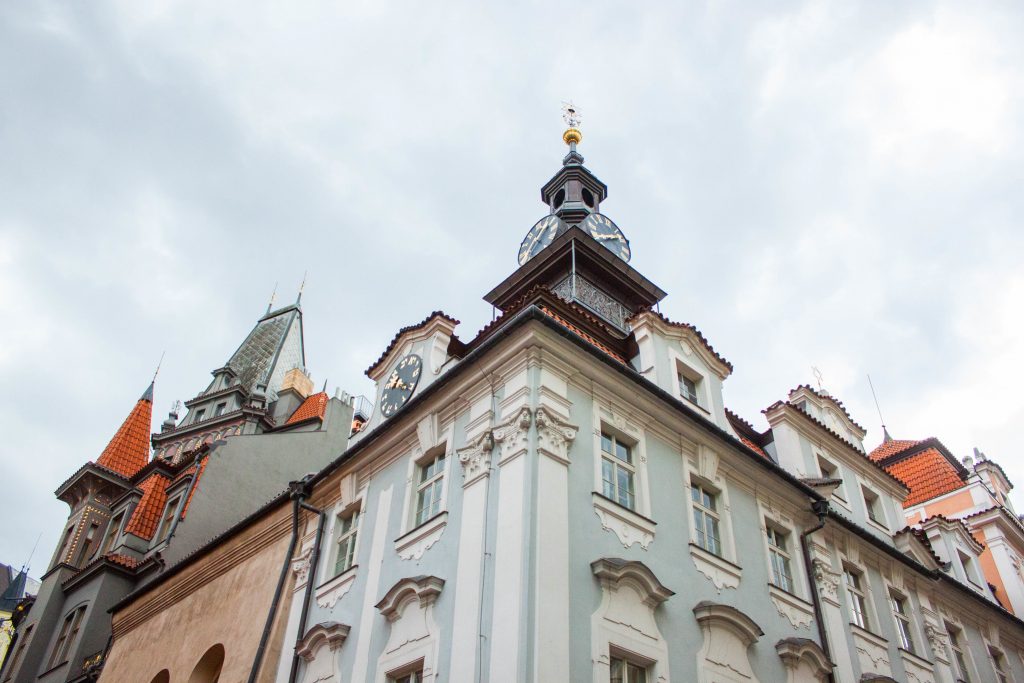
Clock Tower
Take your eyes from the street level to the top of the building. Here you’ll find a magnificent clock tower and spire. The top of the spire is finished with a finial in the shape of the star of David. Look closely and see if you can spot the small bell in the centre. This was used to call people to prayer or to announce meetings inside the town hall.
But what really makes this building unique are the two clocks. While the larger of the two on the very top of the tower is the most prominent, the smaller one is actually the one we’re going to focus on. This clock, located on the northern dormer window, has a dial with Hebrew numbers. And those dials run counterclockwise. This is because it is to be read the same as Hebrew writings, from right to left.
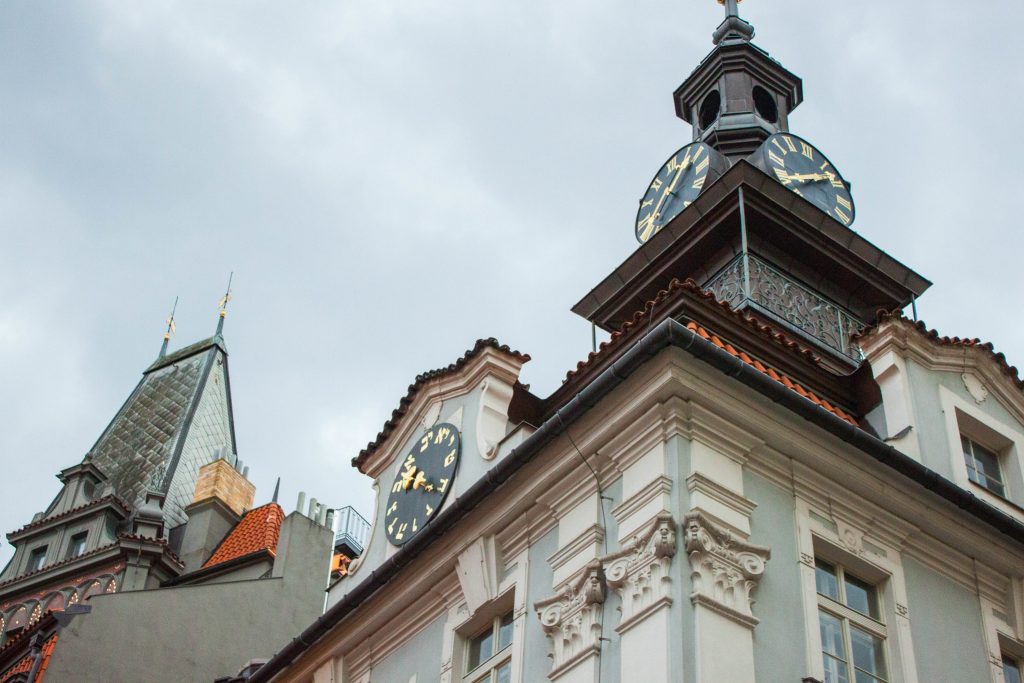
Old-New Jewish Synagogue
Turn around and look at the building on the northeast corner. Standing guard over this area is the solemn and enduring Old-New Jewish Synagogue . Also known as Altneushul in Yiddish. This is the first gothic building built in Prague, completed in 1270. It is the best example of Cistercian Gothic in Bohemia. It is also the oldest standing synagogue in Europe that is still used for religious services. It’s one thing to visit a building used as a museum, but another to see it in practice, just as it has been used for almost 1000 years.
The Old-New Jewish Synagogue has been the spiritual heart of the Jewish quarter since its construction. It was a place where people would not only come for prayer but also for celebrations. And as a place of refuge. Legend has it that the synagogue was first built atop a base of stones brought from Jerusalem. They were brought to the city by angels. Originally the temple was called the “New Synagogue” since it was the first one of its kind in Prague. But as time passed and newer synagogues began popping up, it became known as the “old synagogue”. Today, they combine the two nicknames to preserve their historical value.
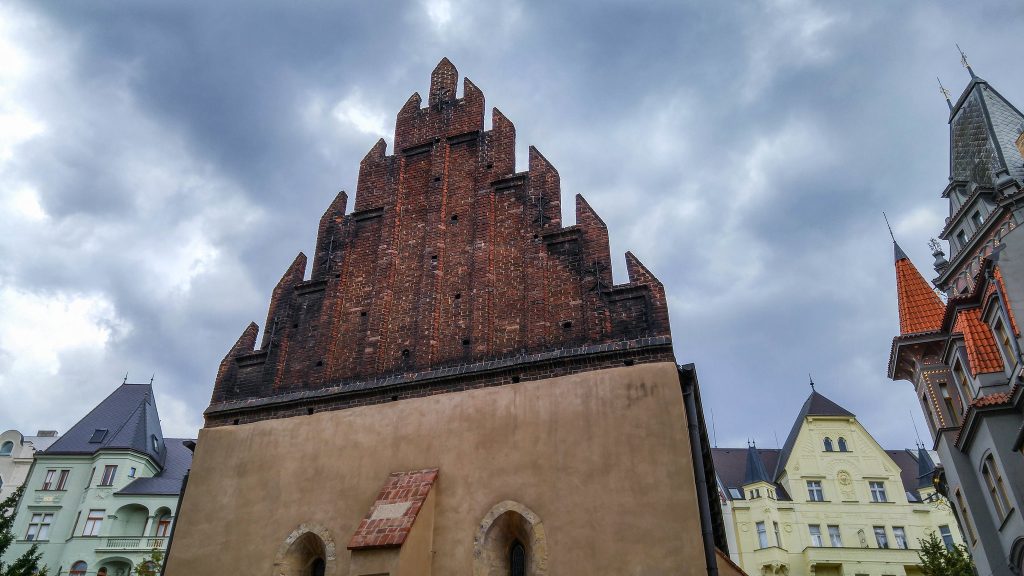
Exterior of the Old New Synagogue
From the outside of the building, you can study its medieval twin nave design. On the western facade, you can see the dark red gothic brick gables and rather obtrusive support pillars which jut out from the sides. The lower roofline has a few large windows that look into the synagogue’s nave. Before, an addition was added where women could come and pray; this was the only place women could witness the services. As per Jewish doctrine, men and women are not allowed to sit in the same space inside a synagogue. This new annexe is located just on the northern side, to the left of this facade. Twelve gothic brick windows encircle the synagogue to let light inside. These twelve windows are representative of the 12 Israeli tribes, a number which is often repeated inside.
Golem of Prague
One of the most important legends from this synagogue is that of the Golem of Prague . In Jewish folklore, a golem is a magical creature created from clay or mud by a powerful ritual. In 1389, over 3,000 Jewish people living in Prague were murdered by Catholics in a devastating event. Rabbi Judah Loew ben Bezalel feared for his people after these attacks. He decided to protect them he needed to create a Golem. He went to the banks of the Vltava River and performed Hebrew incantations which created the Golem of Prague. They implored the Golem to defend the Prague Jewish Quarter from anti-Semitic attacks. The Golem lived in the synagogue’s attic and remained silent until his time of need.
During WWII, a nazi agent came to the temple to destroy it. He entered through the attic from the stairs on the outside. Upon entering the synagogue, he encountered the Golem. When the agent tried to stab the Golem, he was instantly killed. Therein the Golem protected the synagogue from being destroyed.
Today, there is still a set of iron stairs on the exterior. These are the very stairs used to access the attic. The last few steps have been removed to prevent anyone unsuspecting from entering the resting place of the Golem. Just in case they awaken him once more.
View this post on Instagram A post shared by Dana Škrabalová (@dana_dajdulka)
Interior of the Synagogue
The interior of the synagogue is an assortment of several centuries of designs. The building has been expanded over the years, but the central nave has remained mostly unchanged since the 14th century. Entering the synagogue, you enter through the vestibule built in the 15th century. You’ll pass under the early gothic tympanum with a relief atop it featuring a tree with 12 vines. Each of the vines represents the 12 Israeli tribes we mentioned earlier.
Entering the synagogue’s nave, we can see that it’s a double nave design that slightly imitates a catholic church layout. This is because there were no Jewish architects at the time, so the designers who built this synagogue were drawing off their experience in building Catholic churches. Although there are not as many rules to building a synagogue as churches, the temple’s main focal point should be on the central axis facing Jerusalem. The ceiling of this great synagogue features a unique form of vaulting comprised of a five-rib vault instead of the traditional four. This fifth rib always arches towards the exterior walls to help with structural support. The decor throughout the temple features leaves and other natural elements. This is because, in Jewish synagogues, we do not have images of humans portrayed in a religious context.
View this post on Instagram A post shared by Adam Schneider (@theadamschneider)
In the centre of the nave is the bimah , an elevated platform where the rabbi comes to read the Torah during services. This bimah is the very same one that has been used since the late 15th century. Unlike some Catholic churches where the priests are hidden by the choir screen, the bimah allows the entire community to see the rabbi as he speaks. Surrounding the bimah are rows of seats. These seats also cleverly can flip down to be turned into desks. Desks are needed inside a synagogues since this is where medieval Jewish people would come to read, study and discuss philosophy and religions. Like a classroom for all ages.

Jewish Community of Prague Flag
Along the northern wall of the temple is the large red flag. This is the flag of the Jewish Community of Prague . It shows the Star of David with a small golden kipa (a traditional hat worn by Jewish men) in the centre. Surrounding the flag is the Hebrew prayer ‘ Shema Yisrael ‘ embroidered in gold thread. The flag was given to the people of Prague’s Jewish community by Ferdinand III , Holy Roman Emperor. It was a gift in recognition for their services in defence of Prague during the Thirty Years War.
View this post on Instagram A post shared by 𝙲𝚕𝚒𝚗𝚝 𝙰𝚛𝚝𝚑𝚞𝚛, Celebrity Entrepreneur® (@clintarthur.tv)
Klausen Synagogue
Down the street from the Old-New Synagogue, on the corner of U Starého hřbitova street, is the oldest baroque synagogue in Prague, the Klausen Synagogue . In addition to being the oldest baroque building, it is also the largest surviving synagogue. The temple’s name comes from the Latin word “ claustrum ,” which means “small rooms.” The original building that once stood here consisted of three small rooms or spaces; a synagogue for religious services, a ritual bath, and a Talmud school where the renowned Rabbi Loew taught. The new 16th-century synagogue sits on the same site as the previous temple, which burnt down in the early 1600s.
View this post on Instagram A post shared by @aremytravels
While the exterior of the building is rather simple brick, the interior is where this place truly shines. Stucco details decorate the ceiling and galleries. Motifs of ribbons and fruit, painted in pale greens, intertwine overhead. During the second world war, the Nazis destroyed most of the beautiful historic baroque decorations and furnishings. They turned the building into an ample storage space during the war. After the war, the building was restored back to its formed glory.
View this post on Instagram A post shared by Ans Wouters (@ans_wouters)
Torah Ark Cabinet
But one item was spared from the destruction; the Holy Torah Ark . The Torah Ark is a cabinet, a piece of furniture found in temples where the precious Torah scrolls are kept. Standing at the front of the synagogue, you’ll still find this fantastic, three-storey-tall work of art. It is made entirely of marble, a mixture of red and green stones carved into an almost architectural feature. Perhaps it was too large and heavy for the Nazis to move. Whatever the reason, you feel like you’re truly standing in front of something extraordinary when you visit. So many of these items were lost after the war but this was spared. On each level of the Ark are various Hebrew inscriptions.
View this post on Instagram A post shared by Dawdle (@dawdlegram)
Torah Scroll
Sitting in a glass case in front of the Ark is a copy of the Torah scroll unfurled. Different ornamental items used by the rabbi during services are also displayed in the glass case for visitors to admire. Many of these items would not usually be visible to the public during services, so this is an excellent opportunity to get up close and learn more about each item. It’s essential to know that this unrolled Torah is a copy of the original since Jewish people do not allow holy text to be publicly displayed.
Silver Torah shields show the congregation what reading would take place that day. You can study the gold Hanukkah lamps and a silver Pidyon ha-Ben trayf from the 19th century, which depicts a scene of the exodus of the Jewish people from Egypt. One of my favourite parts of the synagogue is the single circular stained glass window. The pale blue circle is decorated with the star of David in beautiful golden glass. Against the rather monotone interior colours, this vibrant burst of colour really stands out!
Old Jewish Cemetery
Behind the Klausen Synagogue, we find the moss-covered stones and footstep-worn pathways of the Old Jewish Cemetery. Here is where some of the oldest residents of Prague’s Jewish Quarter have been laid to rest. The original Jewish cemetery was located where we can now find Vladislava street. The original cemetery was dubbed the “Jewish Garden” as most of it was left to the elements, and it became overgrown and wild. Residents of the neighbourhood began to complain about the smell, and the community was ordered to move the cemetery in 1478.
Morbidly, the roads of New Town were actually built atop these old tombs. Although there is no recorded history of when the Old Cemetery (then the “new cemetery”) was established, we know that its earliest recorded gravestone dates back to 1439. The last person to be buried here was during the 17th century, after Emperor Josef II banned burials anywhere inside the city walls for hygienic reasons.
View this post on Instagram A post shared by Gabriele Paesani 📷🌞♈🇮🇹 (@esploratoredelbello)
Jewish Gravestones
Waking in this cemetery for the first time is a powerful moment for those who have never seen it. We usually think of cemeteries in a very organized and orderly way. Each stone is given its own plot of land sectioned a few feet away from another. But the Old Jewish Cemetery is entirely different. The gravestones look like a pile of dominos, stacked one on top of the other in an almost haphazard fashion. The sprawling grounds of the cemetery roll up and down, spread out on various levels.
In Jewish law, deceased ancestors are not allowed to be moved or tombstones to be removed. Despite buying more and more land eventually, there was no space left for new burials. Because there was nowhere left to expand, a new layer of soil was piled on top of the old graves to make room for new ones. In some areas, more than 12 layers of graves are stacked on top of each other! There is something genuinely overpowering upon seeing these piles of graves. The magnitude of the number of people who once lived in this area thrust upon you.
View this post on Instagram A post shared by Roxy (@catwoman1970)
Reading Symbols
Studying the various tombstones is one of the most interesting parts of walking through the graveyard. Even if you can’t read the Hebrew words carved into the stones, each one is still visually arresting. There are two different kinds of monuments in the cemetery. One is a simple headstone; these are the most common ones you’ll see almost everywhere throughout the cemetery. The other one is much larger and looks almost like a stone tent. These are called tumbas and were significant community members during the baroque era. In the 16th century, Jewish gravestones were not just marked in Hebrew with the date of the person’s birth and death. They also included a eulogy of the life of the deceased. This is why most gravestones are covered in the text, almost so much that they look like an ornamental pattern.
View this post on Instagram A post shared by Ilona Tumova (@tumova.i)
Later on, in the 17th century, these eulogies were simplified into symbolic characterizations, which give a metaphoric glimpse into the character of the person buried below. Some of these emblems also might signify the person’s occupations or what clan they might belong to. Two hands denote that they are beloved to the Aron Tribe of priests, a bear and a kettle refer to the Levi family, and a mouse is the symbol of the Masiel family.
View this post on Instagram A post shared by Barbara David Matias (@barbaramatias702)
Oldest tombstone
The oldest tombstone in the cemetery is that of Avigdor Kara, buried in a tumbas in 1439. Other famous graves you can see when visiting are:
- The tomb of the district’s benefactor Mordechai Maisel died in 1601.
- The tomb of Rabbi Low and his wife Pearl died in 1609.
- Astronomer David Gans died in 1613, and the grave of doctor and physicist Josef del Medigo, passed in 1665.
View this post on Instagram A post shared by 𝕸𝖆𝖑𝖆𝖎𝖐𝖆 (@teaontombstones)
Nephele Hill
On the northern side of the Klausen Synagogue, we find one of the saddest areas of the cemetery, Nephele Hill. Nephele Hill is where children who died before one month are buried. Nephele is the Hebrew word for miscarriage since many of the children buried here died due t miscarriages. It’s impressive to see that something we so often cover up or hide in this modern world was given such reverence and care hundreds of years ago. Sometimes there is something to be learned from our past to change the future.
View this post on Instagram A post shared by ✡️Židovské muzeum v Praze (@jewishmuseum_prague)
Ceremonial Hall
An inscription above the entrance to the Ceremonial Hall reads, “the H oly society, performing merciful deeds. ” Although now a reconstruction of the original, this building was the place of the Burial Brotherhood, who performed the ceremonial death rites on the dead of Prague’s Jewish Quarter. The design of the exterior was done by architect J. Gerstl in 1906-1908. It was produced in neo-Roman style, with details like heavy masonry, columns and detailed capitals on the windows, round arches and simplistic iron grilles. The hall was used until the 1920s as a mortuary, but today is a part of the Jewish museum. The morgue was initially located in the basement, and the first floor was where ritual purification of the dead (taharah) took place.
Interior of the ceremonial hall
The interior of the ceremonial hall has some of the most exquisite mosaic work. The geometric floral patterns seem almost too pretty for a mortuary and bloom across the first floor. Inside various display cases inside the ceremonial hall are items from the history of the Prague Burial Society . The most amazing of these pieces is a series of baroque paintings from the 1770s. Each of these 15 paintings details the Jewish community’s customs and ceremonies that occur after someone dies. There are also some fascinating relics from the graveyard safely stored inside. These are some of the oldest tombstones which can no longer be left outside due to their deterioration.
Maiselova 41
Head across U Starého hřbitova street and turn north a few feet to Maiselova 41/21. Maiselova street is named after Mordecai Maisel, a name you must be sick of hearing by now, but the repetition only cements his great importance. Historically this street was nicknamed “gold street” due to the vast amounts of gold Maisel donated to the crown to aid his war against the Turks. This apartment complex was built in 1911 by Klenka and Weyr. The two silhouettes on the front window were meant to resemble Mordecai Maisel and his beautiful wife. In the centre between them is a star of David surrounded by, and you might be able to guess, piles of gold coins.
View this post on Instagram A post shared by Olivier Bernard (@olivierbernard)
Siroka Street
Siroka Street is another avenue to find some of the best views of Prague’s incredible 19th and 20th-century architecture. #9 on this street is an old apartment building built in 1908 with one of the most mythical doorways seen anywhere in the city. Further up the building are some gorgeous mosaic cameos with images of traditional Czech men and women.
#36 is the old Jewish General Hospital. #11 is a Gothic masterpiece by architect Josef Blecha , built-in 1905, called the House At Saint George. Its namesake is featured on the facade of the building, standing atop the slain corpse of the giant dragon.
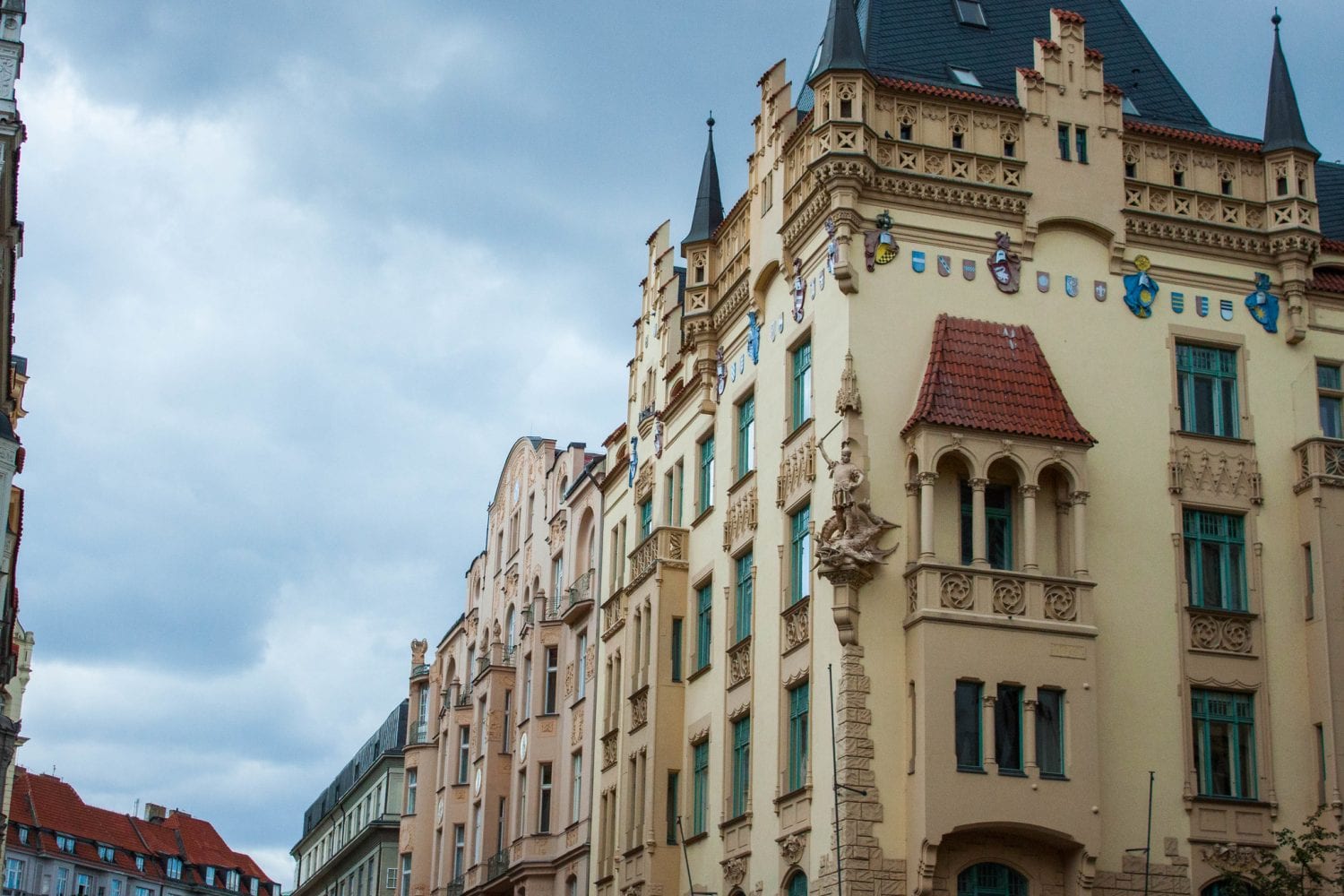
Maisel Synagogue
Walking south down Maiselova street, set a few meters away from the road, behind a set of bright blue painted fences, is the Maisel Synagogue . Finally, we reach the synagogue named after the man who seemingly is responsible for almost the entirety of Prague’s Jewish Quarter. If you weren’t looking closely, you might not recognize the building as an old synagogue. The architectural style seems so similar to that of old neo-gothic palaces.
The first synagogue built here was made in 1590. But this building was severely damaged in 1689 in the fire which ran rampant throughout the Jewish ghetto. For a synagogue named after one of the richest men in Prague, it is ironic that after WWII, when the temple fell to ruins, there was no money to restore it. It wasn’t until the 19th century that a full restoration took place to restore the synagogue to its former glory.
View this post on Instagram A post shared by Julie S Pentelnik (@jspjudaic)
Legen of Mordechai Maisel
There is a charming legend about how Mordechai Maisel earned so much money over his lifetime. The legend goes that once Maisel was just a simple man who owned a small shop. One day, a man came by and left a large chest inside the shop and said he would return later to retrieve it. The man never returned, but Maisel, an honest man, did not open the chest. Years later, when Maisel saw his city on the verge of ruin and in dire need of financing, he opened his chest. Because Maisel hadn’t been greedy and opened it right away, the divine blessed him, and the chest was full of gold coins. Although the reality is that he was just an incredibly hard worker and a dedicated community member, the legend is still amusing.
Interior of the Maisel Synagogue
The synagogue’s interior contains opulent nine-branched gilded candelabras, which decorate the gallery’s arcades above. It also is home to one of the oldest synagogal curtains from the end of the 16th century. During WWII, this synagogue was gutted and used to store over 6,000 pieces of Jewish artwork from all over synagogues in Bohemia and Moravia. The pieces saved after the war were returned to the State Jewish Museum, but the Maisel synagogue kept a collection of silver used in Jewish rituals from Czech synagogues throughout history.
View this post on Instagram A post shared by Cynthia Graner (@postcardsfromauntie)
Pinkas Synagogue
The small and unassuming Pinkas Synagogue is the best place to end this tour. It is perhaps the most sombre of all the synagogues. From the exterior, this place looks more like a family home than a temple, which is for a good reason. In 1492 this was home to a distinguished Jewish family, the Horowitz family. They were extremely religious and built a private oratory attached to their house.
In 1535, the oratory was replaced with a public synagogue that the family could share with their community. In the basement of the house, we can still find the 15th-century Mikvah. A Mikvah is a ritual bath used in Judaism to achieve ritual purity. Besides the Mikvah, several old wells and ancient cellars are the earliest archaeological discoveries of ancient Jewish settlements in Prague. Today, this synagogue is most notable for containing a moving memorial to the Czech victims of the Holocaust.
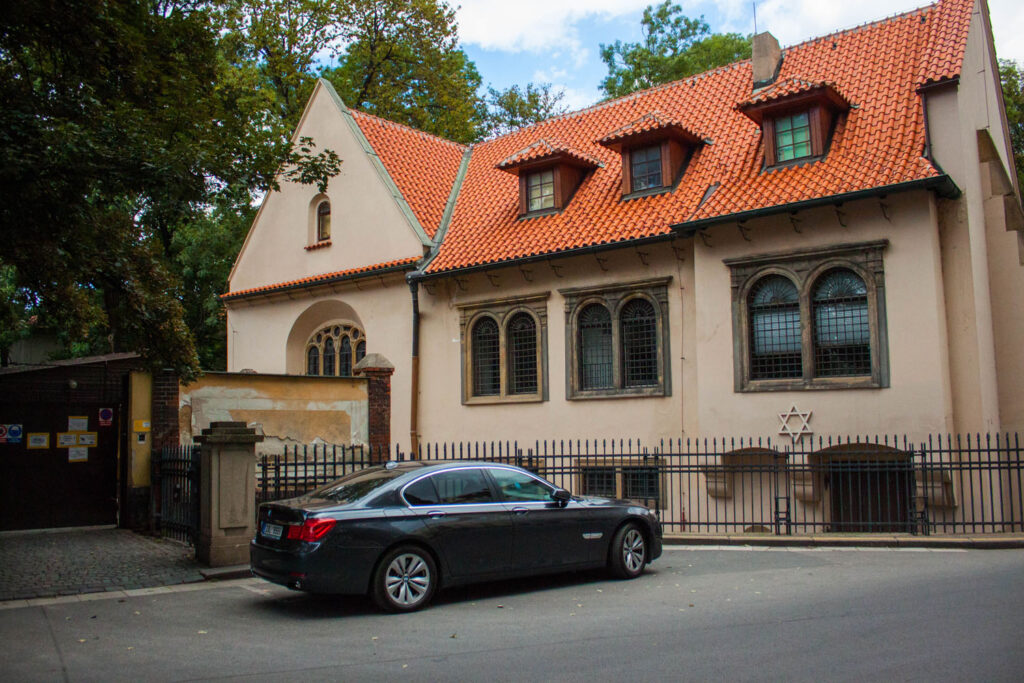
Interior of Pinkas Synagogue
The interior is very austere and feels like a museum of architectural styles since so many different ones are on display. On the ceiling, you can see the gothic reticulated vault system. On the walls, we can study Renaissance ornamentation. The bimah in the centre of the room is from the baroque era since the synagogue floor was below ground level and, over the years, was subject to multiple floods. The grille surrounding the bimah was decorated in rococo style and donated by successful businessman Joachim von Popper . The grill has the emblem of Prague’s Jewish Community, as seen in the Old-New synagogue’s red flag, embedded into the wrought iron.
One of the most surprising elements of the synagogue is the geometric art-nouveau stained glass found on the windows throughout. The delicate cool colours and abstract shapes lend to the subdued atmosphere while adding an artistic element.
View this post on Instagram A post shared by Natalie Marchant | Travel&Food (@taliena)
The Wall of Jewish Names
A portion of the walls inside the synagogue has been covered with 78,000 names of the Jewish members of the Czech Republic who were victims of the Holocaust. These names are arranged by the various individual communities where the victims came from. In these sections, they are listed from their birth to their death. Often you’ll still find family members making a pilgrimage here to pray for their fallen ancestors.
View this post on Instagram A post shared by • 𝕜 𝕖 𝕝 𝕤 𝕖 𝕪 𝕜 𝕚 𝕝 𝕘 𝕠 𝕣 𝕖 • (@kk.ilgore)
Children’s Drawings
One of the most moving parts of the synagogue is on the first floor, where you can see an exhibition of pictures drawn by children from the Terezín ghetto between 1942 and 1944. Sadly, most of the children who authored these drawings were sent to Auschwitz, where they were killed. These drawing sessions were actually led by painter Friedl Dicker-Brandeis . Dicker-Brandeis provided drawing lessons to the children in the ghetto.
But instead of just following the drab curriculum provided by the Nazis, she encouraged the children’s artistic skills as a kind of therapy. It was a way of the procession of losing their homes and the harshness of life in the ghetto. She had the children draw their emotions and their memories. We are today left with such a compelling look into the eyes of a child during this tumultuous time. Dicker-Brandeis herself was sent to Auschwitz, where she was murdered. With a few moments warning before being put onto the trains, she hid all 4,500 of these drawings in a suitcase and stashed it away inside her house where the Nazis wouldn’t find it. Years later, it was uncovered by the Jewish Museum in Prague. They took it upon themselves to ensure the memories of these children lived on, even when they did not.
View this post on Instagram A post shared by Tᤢoຼmᤢoຼmᤢi࿆ (@tomo_oo.ho)
King Solomon Restaurant
After this tour, you are, no doubt, feeling a bit hungry. And what better thing to eat than a modern, kosher meal. There are still a few remaining Kosher restaurants in the area, but the best has to be King Solomon . They have a wonderful philosophy about their cooking. They are passionate about following their ancestors’ traditions while incorporating fresh ingredients and new cooking methods. Their grilled fallow deer steak with mushroom sauce and potato pancake is my absolute favourite! The dishes are a bit pricey, but such is the price of tradition. Skip the wine, which I found to be the most over-priced, and you can enjoy the food without it!
View this post on Instagram A post shared by KING SOLOMON PRAGUE (@kingsolomonprague)
This brings us to the end of the tour. If you’re a history buff like me, hopefully, you’ve enjoyed all the details I’ve included in this tour to help you walk back in time and discover the trails of the amazing Jewish people of Prague. Let me know in the comments if you have any questions about the tour!
Happy Travels, Adventurers!
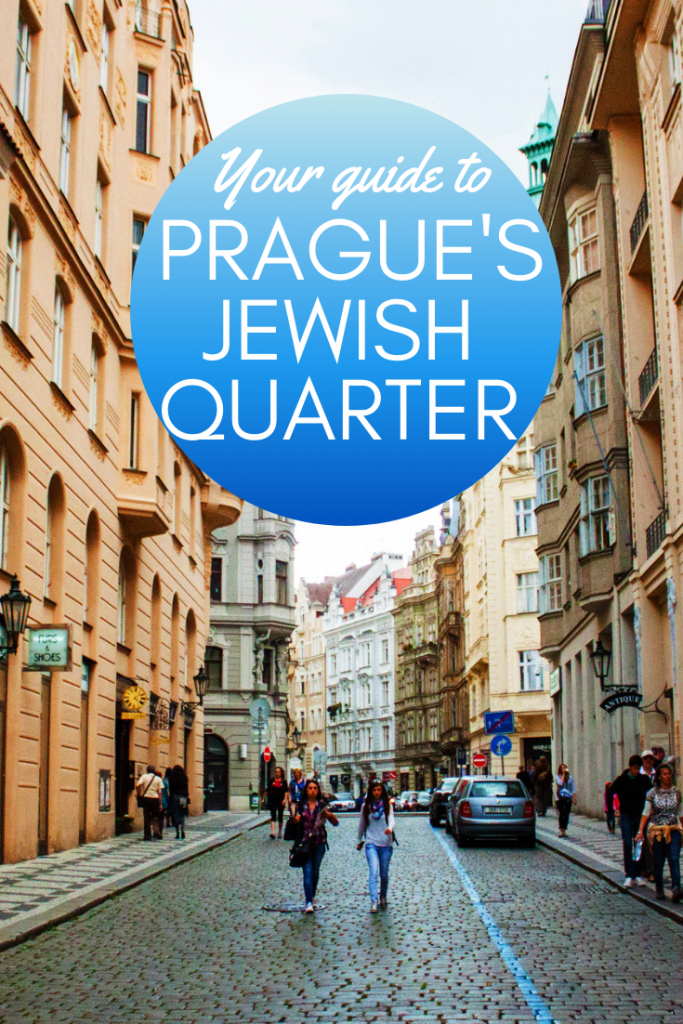
« The Ultimate Free Self-Guided Walking Tour of Malá Strana, Prague
The ultimate self-guided tour of frida kahlo’s casa azul museum », you may also like.
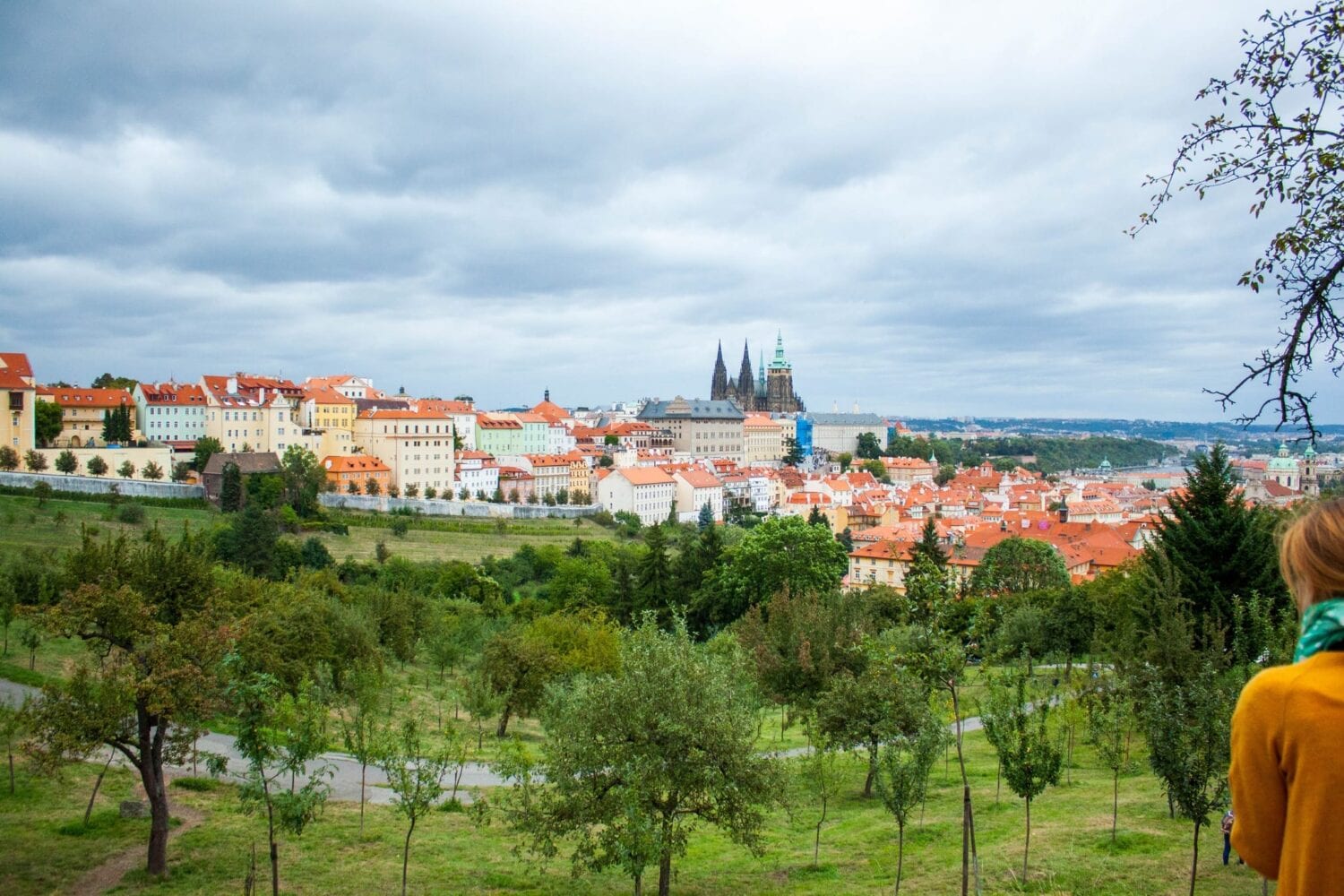
The Ultimate Self-Guided Walking Tour of Prague
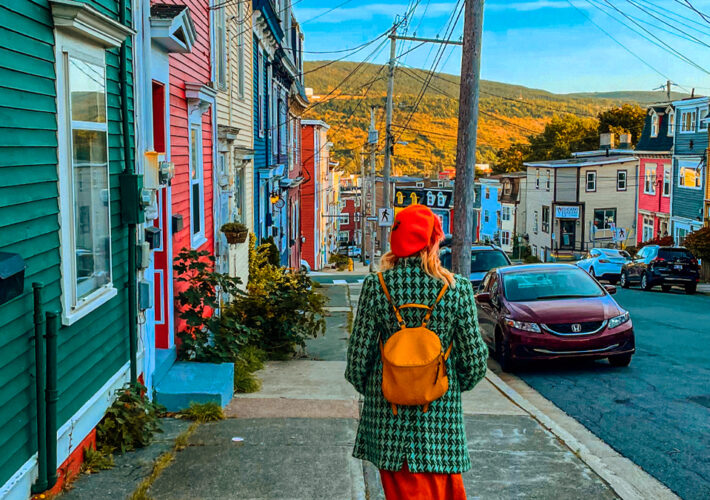
Newfoundland’s 10 Most Colourful & Beautiful Places to Visit
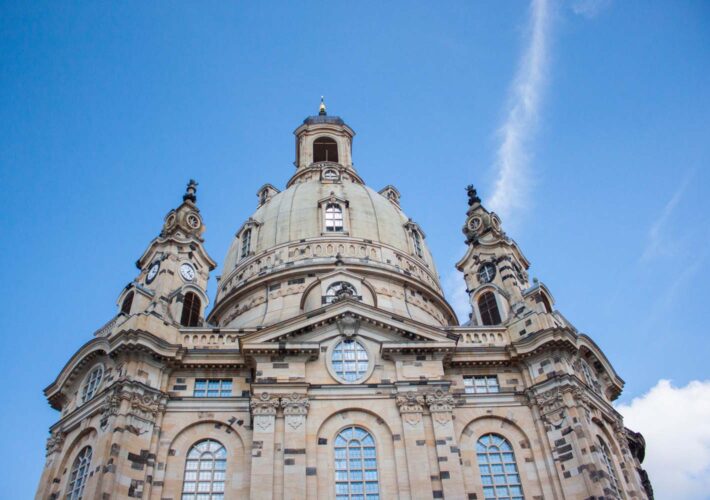
The Best Guide to Discovering the Beauty and History of Dresden’s Iconic Frauenkirche
[email protected]
I have just finished reading all your blog posts about Prague and I cannot thank you enough!!! First of all, I enjoyed reading them. Second, I have taken pages of notes for our trip to Prague and the Czech Republic in 2 weeks. Your posts will be so, so helpful. Thank you for all your work on these.
Aw, thanks so much Bonnie! I love doing all the writing and research but it means so much to me when people leave me these kind words! If you have any questions about your trip let me know, always happy to help out!
Thanks for this info – I’ve been to Prague several times… This time with my little girls, your guide has made our visit even more enthralling and informative!
The Creative Adventurer
Aw David that is AMAZING to hear. I love the fact you brought your little girls to Prague, I know I would have loved to visit when I was a little kid. Let me know what there other favourite things were. I think seeing the city through the eyes of a child must be such a special thing.
Leave a Comment Cancel reply
Your email address will not be published. Required fields are marked *
Copyright @ 2023 The Creative Adventurer | All Rights Reserved | Privacy Policy
This website uses cookies to improve your browsing experience and analyze the use of the website. Learn More

Prague Free Walking Tours

A visit to Prague in the Czech Republic is a memorable experience which is why it's so popular with tourists.
The fascinating history and the marvelous Gothic and High Baroque architecture are very special, so much so that the historic center of the city is a UNESCO World Heritage site.
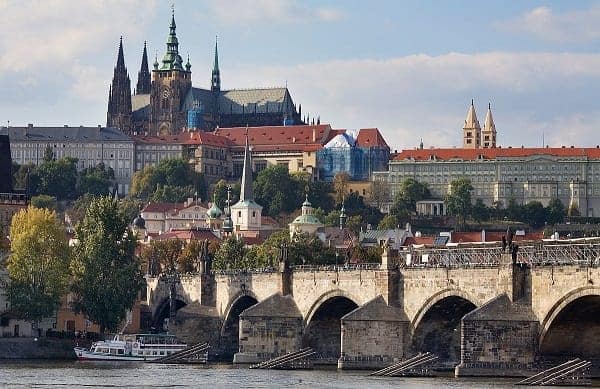
Prague is a very walkable city. In fact, many historic areas in the city are accessible only to pedestrians.
There are 5 types of free walking tours in Prague, and below, we explain your options, provide schedules, and go over what you will see on each tour.
We are a group of local walking tour guides who lead daily tours of this enchanting city.
And, in the video below, Valery, Nico, and Vaclav, guides with 100 Spires City Tours, take you on a virtual walk through the Old Town and Jewish Quarter.
We hope to see you on one of our tours.
OVERVIEW AND SCHEDULE
Below is a calendar of some of the great walking tours available in Prague, all from local guides.
The tours listed here are all in English. Typically they are between 2 hours to 3 hours long.
Tours in Prague has a small booking fee to guarantee a reserved spot in order to keep group sizes low for an enjoyable experience. Walk-ups may be accommodated if space allows.
Searching Availability...
More Tour Options? More tours are available in the individual tour sections below.
- Old Town+ Jewish Quarter Tours
- Prague Castle Tours
- WW2 + Communism Tours
- New Town Tours
- Night and Ghost Tours
This model of "free" tours is tours that are free to take. There's no need to pay at the end, but you can if you want.
Engaging locals adds to the experience by offering understanding and insights.
You can pay what you think the walk was worth at the tour's end, even nothing.
If you enjoyed your tour, it is recommended to give your tour guide between 200-400 Czech Crowns (CZK), which is between €8-15, or whatever you can afford.
We also offer free self-guided walking tours as well as two GPS-led audio tours, one of Prague's Old Town and one of Prague Castle.
(Click here for tours en español )
FREE TOURS OF OLD TOWN AND THE JEWISH QUARTER
Old Town is the central historic district in Prague and it's the neighborhood most visitors expect to explore.
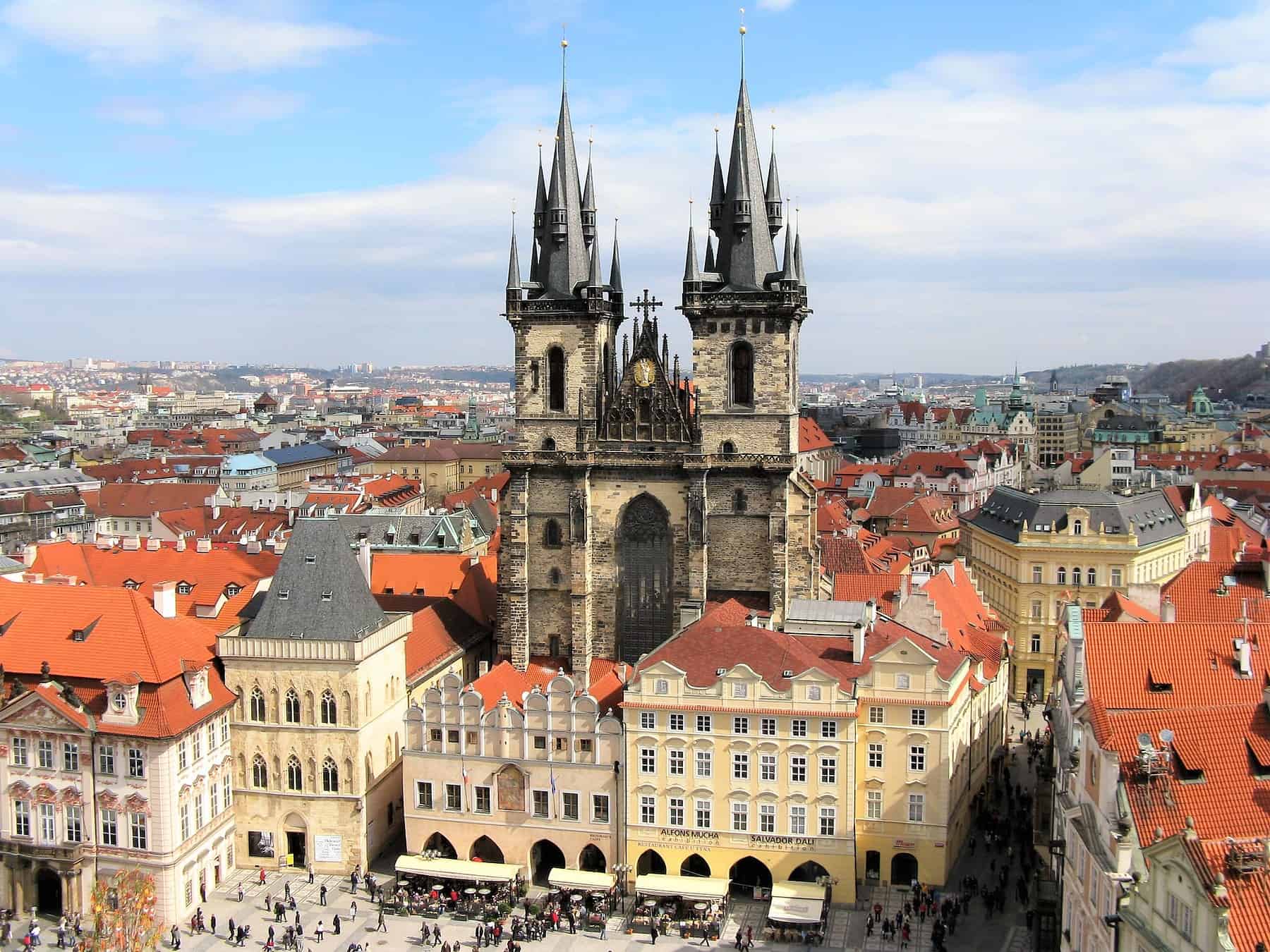
Notable Attractions on the Old Town and Jewish Quarter Tour
- Astronomical Clock
- Old Town Hall
- Mozart Theatre
- Old Town Square
- Powder Tower
- Wenceslas Square
- Prague Castle (from afar)
- House of the Black Madonna
- Church of Our Lady before Týn
- Site of Prague Uprising in WW2
- Old Jewish Cemetery
- Old Jewish Synagogue
- And more (read our guide to the area )
Most companies end their tour at Charles Bridge but the first company also includes a walk across it.
TIP: We also offer a GPS-led audio tour of Old Town and the Jewish Quarter (as well as Prague Castle).
Here's a sample.
Purchase an Audio Tour
100 Spires City Tours
This company offers a 3-hour free walking tour of Prague's Old Town and the Jewish Quarter every day at 10:00 and 15:00 (3 pm).
The meeting point of the tour is Powder Gate and the tour guide will hold a red umbrella with 100 in their hands.
What sets this tour apart from the others in town is that instead of ending at the foot of Charles Bridge, you will walk across it, over the Vltava River, and end at the John Lennon Wall.
They keep groups relatively small (maximum 25 guests), which they say allows them to visit the interiors of some churches and other buildings.
Note that they only offer tours in English.
View the calendar above . Reservations are required .
Additional Companies
If the above company's tour schedule doesn't fit with yours, check out some of the other companies offering this tour in Prague.
FREE PRAGUE CASTLE TOURS
Prague Castle is one of the most historic sites in the city, and there are some free walking tours that cover Prague Castle, Charles Bridge, and the sites in between.
There is also one company that focuses solely on the castle and spends more time there.
And, in the video below, local guide Valery takes you on a virtual walk through the Old Town and Jewish Quarter.
Notable Attractions on the Prague Castle Tour
- Church of Saint Nicholas
- Saint Vitus Cathedral
- Old Royal Palace
- Basilica of St. George,
- Prague Castle (public areas)
And several tours make these additional stops:
- Charles Bridge
- The Lennon Wall
Most tours listed below require one tram ride so be prepared for that. You can read our guide to Prague public transport .
Unless otherwise noted, each tour lasts 2 hours and 30 minutes and begins from Charles Bridge and ends at Prague Castle.
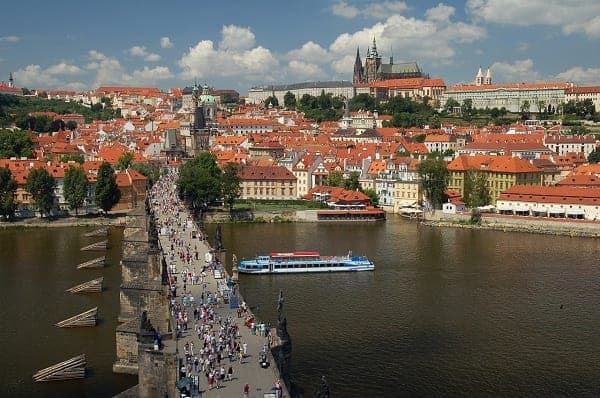
TIP: We also offer a GPS-led audio tour of Prague Castle (as well as one of Old Town Prague and the Jewish Quarter).
This free Prague Castle tour concentrates fully on the area of Prague Castle and the Castle District. It runs every day at 11:00 and 15:00 (3 pm).
The meeting point of the tour is Klarov, Malostranska metro exit. The tour guide will hold the red umbrella with 100 written on it.
The 11:00 tour allows you to see the Change of Prague Castle Guards accompanied by the Music Band of the Castle Guards which occurs daily at 12:00 pm.
On this free tour of the castle, you’ll visit the courtyards and the free areas of the castle grounds.
Additional Options
It probably won’t surprise anyone that there are plenty of tour options when it comes to visiting Prague Castle and seeing Charles Bridge.
If the above company's tours don't fit your schedule, check out some of the other companies offering this tour in Prague.
While free walking tours typically cover only areas open to the public, there are a few Prague Castle tours that include admission to some of the more notable nearby sites.
Ticket prices range from 600 CZK (€22) to 1,000 CZK (€37) on average.
Check our post about Prague Castle for more information.
TOURS OF NEW TOWN PRAGUE
Although there aren’t as many tours of New Town Prague, if you’re interested in learning about this area of the city, there is at least one free walking tour you can take.
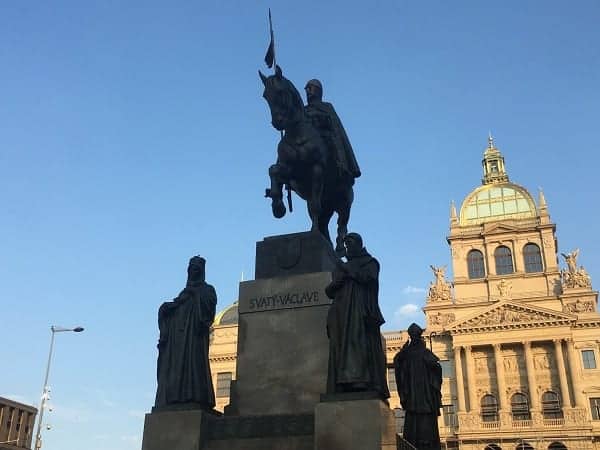
Notable Attractions on the Prague New Town Tour
- New Town Hall
- Charles Square
- Dancing House
- National Theatre
- Jungmann Square
Free Walking Tour Prague
In addition to their Old Town + Jewish Quarter and their Charles Bridge + Prague Castle outings, this company also offers a tour of Prague New Town.
This tour is available much less frequently than the others, but it typically runs every Sunday, Monday and Friday starting at 10:30 am.
The tour duration is 2 hours and 30 minutes.
Check their calendar to see when the next New Town tour begins.
Book this tour or learn more .
WW2 AND COMMUNISM TOURS
If you’d like to learn about Prague during WW2 as well as the city's response to Communism, there is at least one free walking tour that covers this subject.

Notable Attractions on the Prague WW2 and Communism Tour
- National Museum
- Communist Party HQ
- Gestapo Party HQ
- Jan Palach Monument
100 Spires City
This tour covers many significant locations related to Prague's history during WW2 and life under Nazi Occupation.
You'll see the National Memorial to the Heydrich Terror, the Second Resistance Memorial, the Pinkas Synagogue, and other notable sites.
The WW2 and Communism tour is offered every Tuesday, Thursday - Sunday at 10:00 a.m. and every Wednesday and Saturday at 14:00 pm.
The tour lasts for around 3 hours and the meeting point of the tour is Klarov , in front of the Malostranska metro exit.
Other Options
Whether you are looking for a later start time or a slightly different experience, there are several paid tours you can take that cover Prague’s history with Communism and WWII.
Some of these outings are walking tours, but there are also bike tours and combo packages which include admission to the Museum of Communism.
Prices range from around 850 CZK (€31) to 2,000 CZK (€75). Check this list of Prague WW2 and Communism tours to see the full range of options.
NIGHT AND GHOST TOURS
This free tour will take you where no other Prague free tour will -- to the threshold between the real and spectral.
Explore the dark hidden streets, passages, and alleyways of Old Town while learning about the legends and scary stories that are imprinted within its walls and like dark shadows looming over the city and its inhabitants till today.

Hear stories about the Golem, the Headless Horseman, the Templars, vampires, absinthe, and alchemy. Learn more here .
There are also several ticketed tours that you can browse here .
Your guide will take you to the oldest parts of Old Town, near the St. Agnes Monastery.
St. Agnes was a bohemian princess, whose undiscovered grave was for centuries the cause of many disasters that befell Czech lands.
Near her convent is a hospital, whose bloodied staircase till today reminds us of one of the largest executions in Czech history. It's stories like these that are waiting for you. We will see you soon.
The tour usually runs at 19:00 (7 pm) on Tue, Fri, and Sat and the tour lasts for around 1 hour and 45 minutes. View the calendar above .
The tour starts at Klarov and ends at Charles Bridge. Reservations are required .
And much, much more
North america, united kingdom & ireland, middle east & india, asia & oceania.

Best things to do and see in Prague
Prague is the capital of the Czech Republic and it is known as the “City of a Hundred Spires” or the “Golden City.” This European capital is one of the most visited destinations by tourists in the entire world and not only because of its beauty, but because it is practically a museum where tourists can walk through its neighborhoods and witness Prague’s historic, architectural and cultural legacy. Few cities in Europe can compete with all Prague has to offer, culturally and in terms of its many monuments. Prague’s many squares and corners all have a rich story to tell, full of interesting local history that will bring your holiday to life and ensure you a visit that you will remember for a lifetime.
When it comes time to plan out what to see in a city that is this packed with amazing monuments, it’s more important than ever to have some criteria based on how much time you’ll have to explore, this way you get to see all those must-see places on your list without missing anything too important. If you end up doing a free tour in Prague (in the morning, afternoon, or evening) with a local guide, you will have the opportunity to see the places that are most significant or emblematic, places like Prague Castle, Charles’ Bridge, the Cathedral, the Old Town Square, Wenceslao Square, the Dancing House, the Prague Astronomical Clock, The Jewish Neighborhood, the Spanish Synagogue, or the John Lennon Wall.
If you’d like to know more about the free walking tours in Prague in Spanish or English that are available, get online where you can read other walkers’ opinions and reviews they left about their gurus and their guided tours and find the best one for you.
Others cities to visit after Prague
Free walking tour near prague.
- Free walking tour in Amsterdam
- Free walking tour in Brussels
- Free walking tour in Florence
- Free walking tour in Split
- Free walking tour in Dubrovnik
- Free walking tour in Wrocław
- Free walking tour in Nuremberg
- Free walking tour in Salzburg
Find other guruwalks in Prague
- Food & Drink
Be Your Own Tour Guide: A Self-Guided Walking Tour of Prague

Maybe you’re finding yourself overwhelmed by the sheer amount of beautiful and fascinating sights in Prague, or you just arrived and you don’t know where to start. Well, have no fear! The following walking tour will take you to some of Prague’s absolutely unmissable attractions – including a few that you can taste.
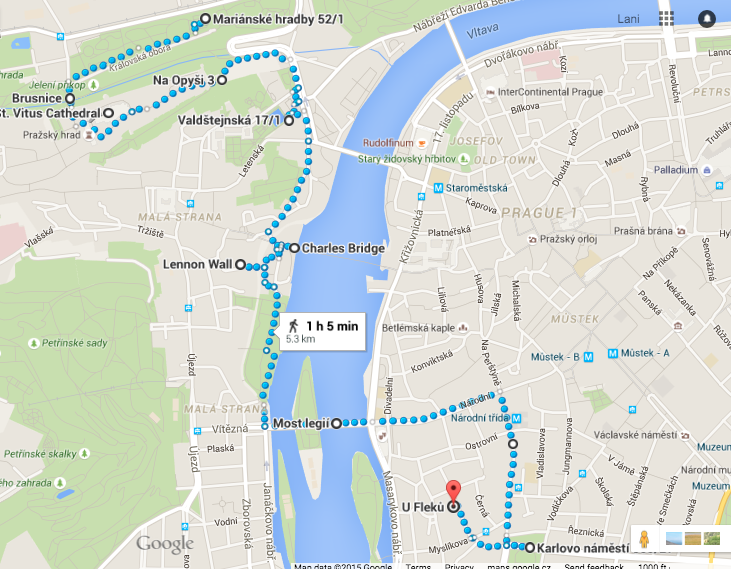
1. We’re starting at the Královský letohradek , or Royal Summer Palace , which you can get to from the Královský letohradek tram stop or the nearby Hradčanská metro stop. Step into the gardens, and picture yourself as a royal – this is where the nobility would spend their summer days, and now you can enjoy the calm atmosphere and deep shade yourself. Walk up through the botanic gardens, which are filled with plant species from all around the world.
2. Once you’re outside of the gardens, take a left to go over a bridge. Right now you’re crossing over the Deer Moat , which still carries the name it was given when the Hapsburgs ruled the Czech lands of Bohemia and Moravia, and the kings used to hunt deer just steps away from the castle. Rudolf II, also known as the Mad King, even had lions in the Deer Moat.
3. Go forward through the big gate – you’re now entering the area of the Castle itself. Walk through the courtyard and then to the left, until the magnificent St. Vitus Cathedral appears in front of you in all its Gothic glory. Because of a variety of financial and other reasons, construction on the cathedral started in the 14 th century and didn’t end until 1929. Inside, don’t miss the Alfons Mucha stained-glass window on the left-hand side, which depicts the life of Saint Václav, the patron saint of the Czech Republic.
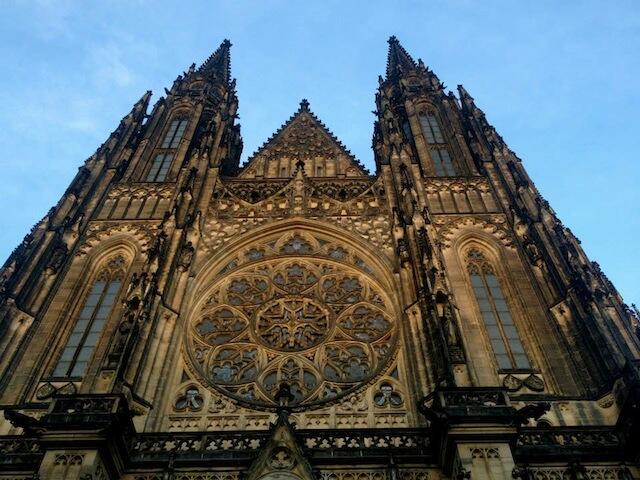
4. Walk around the cathedral towards the back of it, and then downhill through the rest of the Castle complex until you’ve gone through the last gate. You’ll then see a vineyard on the left of the path. This is the oldest vineyard in the Czech lands, and it’s a great place for a refreshing drink in the warmer months, or a svařák , mulled wine , in the winter. You’ll also get a stunning view over the city.
5. Head downhill on the old stairs, and then turn right towards the Malostranská metro stop, stopping for a trdelník , or roasted round pastry, on the way if you’re hungry. They call them Old Bohemian pastries, but they actually originated in Transylvania. At the metro stop you’ll find the entrance to the Wallenstein Gardens, a Baroque garden where they have live peacocks roaming around and owls in a large cage at the back. They’re also called the Senate Gardens, because the surrounding buildings now house the Czech Senate.
6. Your next stop is the Charles Bridge – walk just far enough onto it that you’re over the Vltava River, and then look off the right side of the bridge. You’ll see a statue of a knight with a gold sword held up at attention, guarding the bridge but not a part of it; this is the Knight Bruncvík , the legendary guardian of Prague.
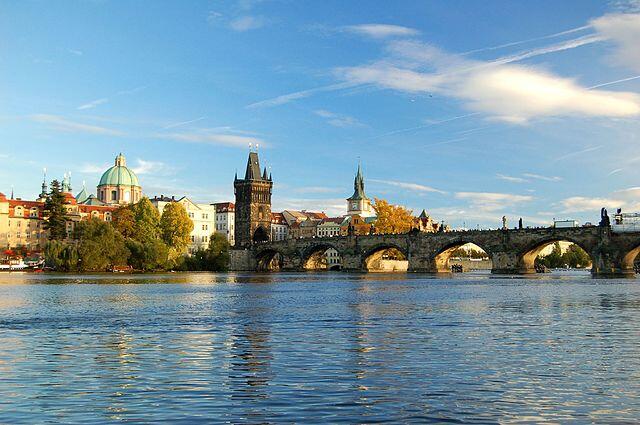
7. Head back towards land and then follow the route to the right, down the curving streets that will lead you to the colorful and ever-changing John Lennon wall . This area for sanctioned graffiti is where you can literally leave your mark on the city, knowing that it started as a form of passive resistance against the communist regime that outlawed western music.
8. Go back towards the river and then turn right, and eventually you’ll come upon some very strange bronze sculptures of babies without faces. These are the work of controversial Czech artist David Černý , and they’re also crawling up and down the Žižkov TV Tower.
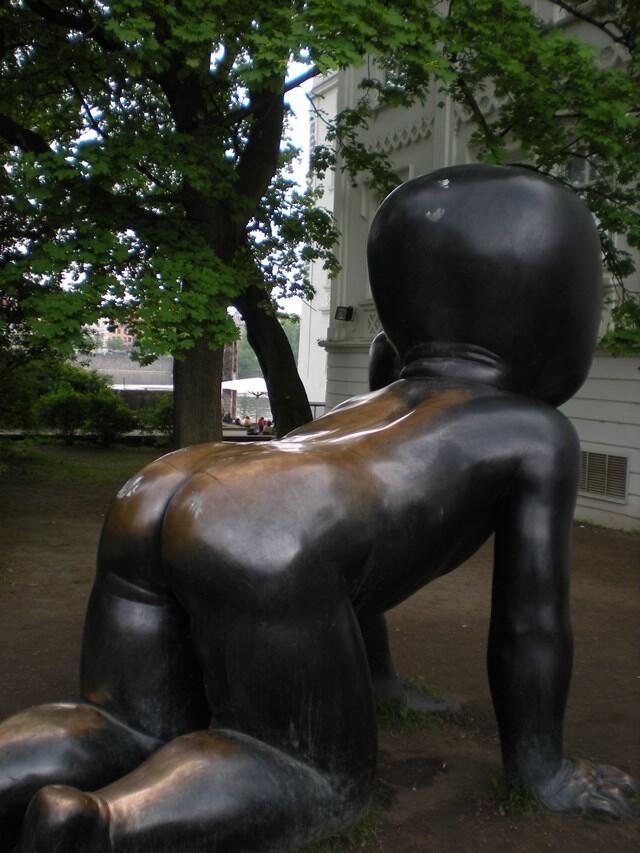
9. Continue south until you hit the next bridge, and while you’re walking across, take in the beautiful view of the castle. If you happen to be going across at night, you can thank the Rolling Stones for illuminating the castle back in the 1990s – they still fund it even now.
10. The gold-crowned building on your right at the end of the bridge is the National Theatre , built twice in the late 19 th century (the first time ended in a fire, unfortunately). The National Theatre is very close to the heart of the Czech nation, as it was a major symbol during the Czech National Revival, when they began the process that ultimately defined themselves as a nation with a language and all the various cultural trappings of their own.
11. On your left, you’ll see the famed Kavárna Slavia, a beautiful art deco cafe . Go inside for some high-end Czech cuisine, made even better by the fact that this is where important Czech political figures like first post-communist president Václav Havel used to meet and discuss their ideas.
12. Just up the street on the right, you’ll find the newly opened Pivovar Národní . Hop in for some hoppy goodness in the form of one of their three micro-brewed beers.
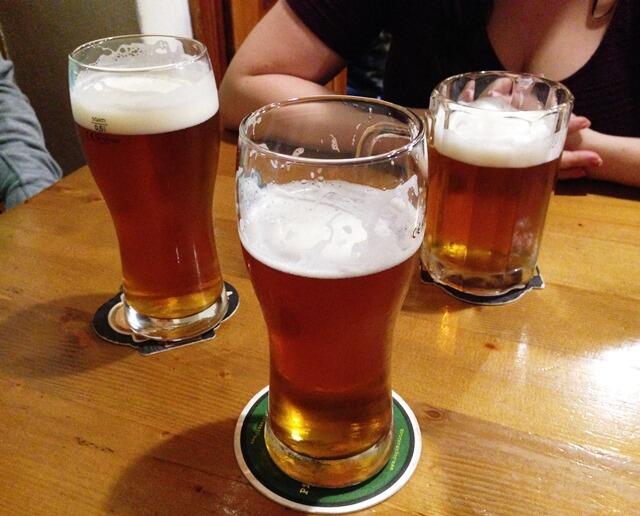
13. Follow the route into Charles Square for your next history lesson. One quirk of Czech history is that there have been 3 defenestrations, 2 of which precipitated wars. What’s a defenestration, you may ask? It means to murder someone by pushing him out a window. The first defenestration of Prague happened at the New Town Hall on Charles Square in 1419, when members of the Czech Hussite Church threw 7 Catholic officials out of the windows. This event was the catalyst for the Hussite wars, which lasted until 1436.
14. Your final stop is the granddaddy of Czech pub culture – U Fleků , which, thanks to its founding in 1499, has the right to call itself the oldest pub in Prague . They brew their own dark lager, and you can’t get it anywhere else. Now just kick back, relax, and enjoy that favorite Czech drink the same way they were doing it right after Columbus discovered America.
Now that you’ve discovered some of Prague on your own, how about joining our Prague Food Tour for a more in-depth look at Czech culture, history, and most importantly, cuisine? With one of our amazing guides to fill your mind and all of the tasty treats to fill your stomach, you’ll walk away knowing that you’ve really experienced the city to its fullest.
Need more detailed maps?
Walking route steps 1-7:
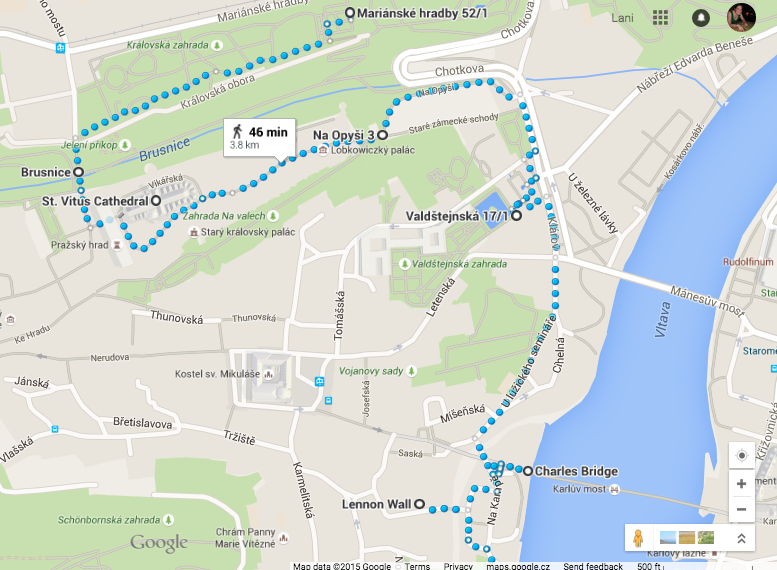
Walking route steps 8-14:
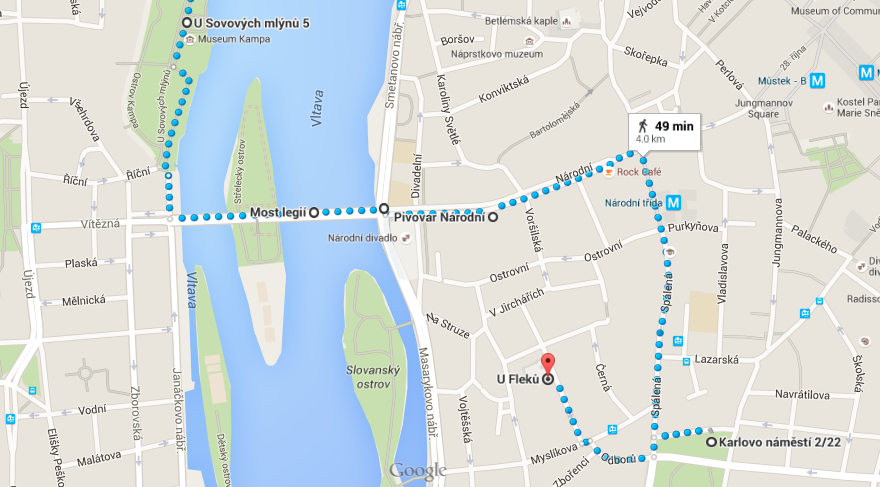
Join over 250,000 travel & food experts
Get the latest food trends, special offers and new tour announcements. Subscription is free
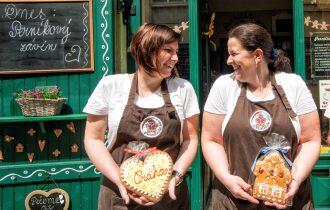
Eating Prague Food Tour
Dine in the same cafe as Albert Einstein and meet the local vendors keeping the city’s food traditions alive. Explore the mysterious history of Prague through its cuisine.
- Small Group
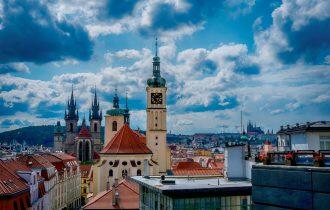
Prague Evening Food Tour
A magical evening in a side of Prague that most people miss.
- Private tour
About Kenny Dunn
Kenny’s love for European cuisine was sparked after moving to Rome in 2009. He fell in love with the city’s backstreet eateries, and even more with the people and stories behind each dish. Now he's turned his passion into food tours, so Eating Europe guests can also share a taste of local life.
Get the best advice and offers on Eating Europe tours
Subscribe to our newsletter for exclusive offers, discounts and the best in food and travel advice across Europe
Related Posts

Koláče : a traditional Czech recipe to make grandma proud
Kolace is one of the sweetest dough recipes. Most suitable for picnic and wedding season…a fitting time to pass along the recipe for the traditional Cz...
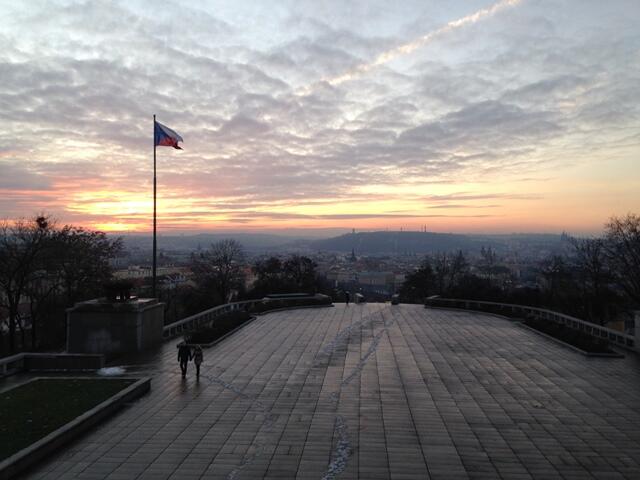
A Visitor's Guide to Prague Museums
In many ways, all of Prague is like a living, breathing, outdoor museum. Around every corner, there’s some interesting historical tidbit or element of art or...

Traditional Czech Christmas Food for the Festive Menu
Christmas in the Czech Republic is celebrated on Christmas Eve, December 24. Literally translating to “Generous Day”, it’s a day for festive traditions – tre...
Lani Seelinger’s Top 10 Tips for Making the Most of Your Prague Vacation

Free Walking Tour Prague
Experience the best of Prague with our professional guides.
EXPLORE PRAGUE
Discover the most famous sights and hidden gems of Prague on our unique free tours in English & Spanish.
Choose tour language
Prague Old Town & Josefov
Discover the most interesting sights of Prague Old Town & Jewish Quarter and hear fascinating local legends!
Prague Castle and Charles Bridge
Explore Europe’s most romantic bridge and learn all about the largest castle complex in the world!
Prague New Town: 20th Century Tour
Step into History: Uncover the Secrets of Prague's Historical New Town!
Small group Old Town tour (Paid)
Discover the enchanting Old Town of Prague and Jewish Quarter in a small group.

Private Tours
Need a tour for a bigger group or a more personalized experience?
Frequently Asked Questions
Find more FAQ .
Testimonials
What people are saying!

„ I thoroughly enjoyed Michal's Free tour of the New Town because it was really considered and carefully put together with a deep love of the city and its people. More reviews “
Kath , United Kingdom
„ We went on the New Town and the Charles Bridge/Castle tour with Michal. It has been a lot of fun, Michal has quite a wide knowledge on Prague! More reviews “
Sophie , Germany
„ Whether you choose Old Town woth its legendary sights or New Town with amazing cubist architecture, you will habe a great time. More reviews “
Ana , Serbia
„ Michal's well-crafted free tour was a great way to see the city and peppered with interesting legends. More reviews “
„ I loved these tours! I went two of them during my five days in Prague and met some wonderful people, learned a lot about the city's history, saw special secret spots, and really had a great time. More reviews “
Kimya , Spain
„ My daughter and I really enjoyed the walking tours of the beautiful historic city of Prague with Michal. More reviews “
Jeannette , USA
„ Great well-prepared tour and guide. Michał shared interesting facts and stories about city and each seperate district. More reviews “
Pawel , Poland
„ I recommend to all who visit Prague, take this tour first, Michal took us to know a bit more of the stories and beliefs of this wonderful city. More reviews “
Vito , Argentina
„ One of the best walking tours I had in Europe! More reviews “
Thaís , Brazil
„ We did the Old town and Charles Bridge tours and both where full of history, legends and really fun! More reviews “
Lucía , Spain
„ Just completed two tours and have been amazing, a great way to see "the best of Prague". More reviews “
Eli , Macedonia
„ Michal's tours were very interesting, I recomend them warmly ! Plus he always has good advices on restaurant and nice place to go More reviews “
Thibaud , France
„ Mischa is a very positive and informative guide. It was a pleasure of having a tour with him. More reviews “
Nataliya , Ukraine
„ Great tour. Great people. Great fun. Best value for money and a great tour guide. More reviews “
Stephan , South Africa
„ This walking tour was so much fun, informative and our guide Michal was so personable. I would definitely recommend this tour! More reviews “
Kelly , USA
„ So personable and knowledgeable. I'd recommend it to anyone More reviews “
Join us for a tour!


Walking tours in Prague: Book with the best!
Free guided tours in prague, czech cuisine crawls and more.
Exploring the Czech capital doesn’t get more captivating than these walking tours we’ve curated at Discover Walks.
With over 100,000 walking tours a year, we know Prague better than most, and showing the city’s hidden gems to travelers from around the world is what we do best.
Why we love guided tours through Prague?
When you’re as passionate about travel as we are, you develop a knack for finding the best locations, unmissable attractions, unique experiences, expert guides and perfect price points.
If Prague’s eclectic culinary, art and history scenes make you excited to explore, then we’d recommend you read through all of the guided tours we have to offer at Discover Walks.
Find the best tours by category now
Our selection of prague's best rated tours, your best day in prague private tour.
let us customize a perfect day

Prague Old Town Free Walking Tour
Get Inside outs of old town

Prague At Dusk Free Walking Tour
Encounter Twilight Magic

Prague New Town Free Walking Tour
Contemporary Prague Center
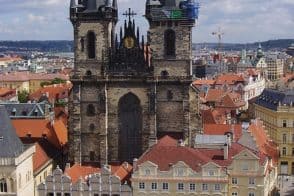
Prague Medieval Free Walking Tour
Old City, Jewish Quarter & Astronomical Clock

Prague Highlights Free Walking Tour
Castle, Bridge, Malá Strana & Cathedral

Prague Fundamental Free Walking Tour
Old Town and Jewish Quarter
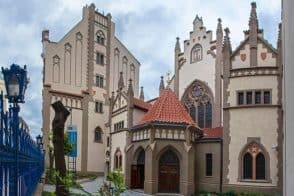
Prague World War II and Communism Free Tour
Interesting yet Dull Chronicles

Prague Castle with Change of Guard Free Tour
Castle District and Band Music
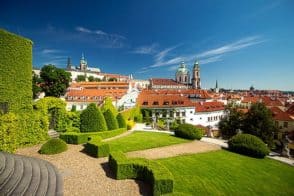
Prague Castle District Free Tour
Charles Bridge and Cathedral
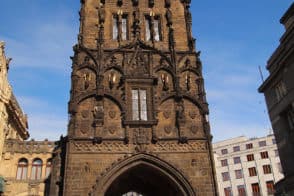
Prague City Highlights Free Walking Tour

Prague Jewish Quarter Private tour
Synagogues, Cemetery & museums

Prague To Cesky Krumlov Private Tour
Enter Cesky Krumlov Castle

Prague History and Food Tour
Savor Local Dishes & Know The Past

Prague Delicious Food Tour
Sample as many local dishes

Prague To Bohemia Countryside and Winery Trip
Wine Tasting and Lunch

Prague To Brewery and Glass Factory Tour
Full Day in Nizbor and Plzen

Prague To South Moravia 2-Day Tour
See UNESCO Sites & Taste Local Wines

Prague Entire City Bike Tour
Personalized Experience

Prague Guided Electric Bike Tour
View Historical Sights

Prague Grand Electric Ride
City Tour in Style

Prague Viewpoints on SCROOSER
Grand Castle View

PRAGUE ELECTRIC BIKE TOUR
BEST CITY VIEWS
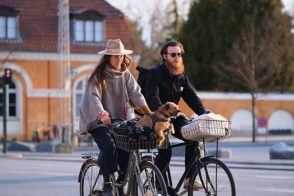
Prague Bike Tour New and Old Town
Classic City Exploration
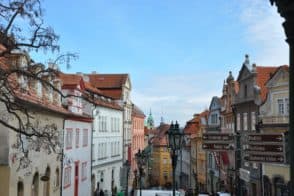
Prague Tour on Scrooser
Grand city Excursion

Prague Electric bike Guided Tour
Choose Small Group or Private Option

Prague All Ages Bike Tour
Complete City View

Prague Traditional Authentic Cuisines
Czech Grandma Recipes

Prague Interactive Cooking Class
Tour Prague Market

Prague Medieval Dinner Treat
Bottomless drinks
Let’s Go to Prague!
Also known as the “Golden City”, a visit to Prague feels a lot like acquiring actual treasure. Prague is one of the most attractive cities in Europe for foreign tourists, and it’s mostly because they city itself is like one giant outdoor museum that is completely explorable on foot, which happens to be what we do best!
Because of the fact that around just about every corner in Prague there lies some new artifact or monument, time management is an important factor for anyone who would like to make the most of their visit. Guided tours have become an almost essential part of seeing Prague in an efficient way. We all know how time flies when you’re having fun! Unmissable attractions in Prague include the Prague Castle, The Jewish Neighborhood, the John Lennon Wall, the Dancing House and, of course, the Old Town Square.
Baroque cathedrals and medieval squares aside, this is a city known for cheap beer and hearty cuisine, spurring the creation of our Prague food tour. It is also one of the most affordable places to party in Europe, along with an abundance of shopping options to suit every budget.
Guided tours through Prague have become a right of passage for first timers in the city, and remain the most efficient way of seeing all that the Czech capital has to offer in short, exciting bursts. Book soon and let our guides take care of the rest!
More cities and tour options? Explore our Paris walking tours , Barcelona walking tours , Lisbon walking tours , and more !

Is Prague walkable? + 5 easy walking routes from the centre
Everything you need to know about walking in Prague, including practical walking tips and 5 easy walking routes from the centre as recommended by a local.
Planning your trip to Prague can be a little overwhelming, especially if you try to plan what you want to visit and workout the distances in between and how it’s going to fit into your travel schedule. On top of that getting your head around the local public transport might be just too much, so I completely understand if you are wondering whether Prague is walkable and whether you can manage the whole of your trip on foot.
The good news is that most of the popular and the must see attractions in Prague are within the inner centre which is compact and easy to walk around as it’s fairly flat and level walking. Most attractions are also close together, so you can see quite a lot in a short space of time.
I walk pretty much everywhere in Prague – especially in the centre – because the perfect way (for me) to explore the town is to get lost (on purpose) and I seem to always find something new! Getting lost in Prague is my favourite way to finding new places, enjoying the architecture and exploring the streets.
In this blog post, I wanted to share with you my favourite walks in the town and also tips on how to make the most of your visit to Prague by exploring the town on foot.
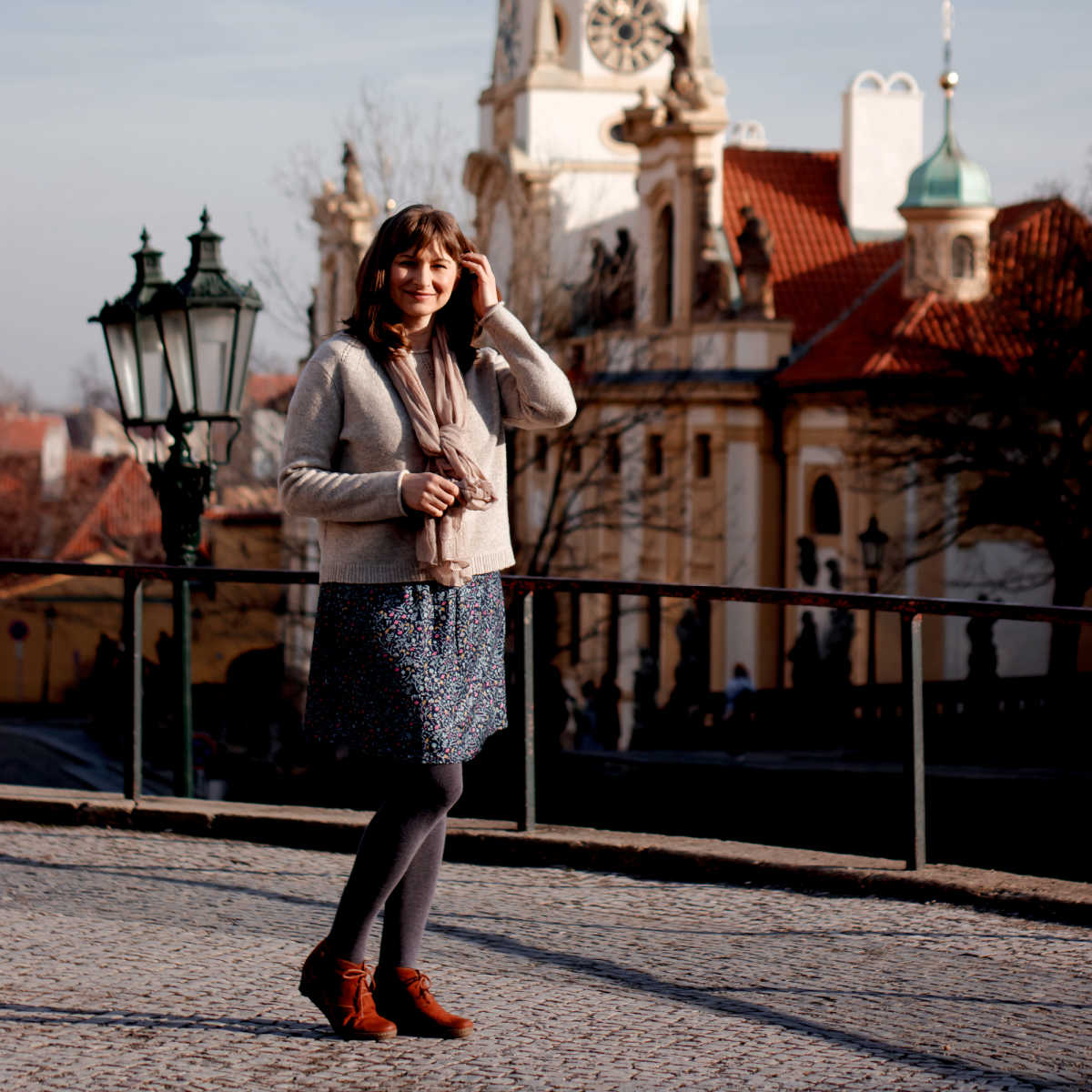
Is Prague walkable? The quick answer
Yes, absolutely! Prague is one of the best walkable cities in Europe (one of the top 5 actually) and the centre of Prague is pretty compact. A lot of the centre of Prague which is about 3-5 miles wide, is also pedestrianised and without much public transport, so you don’t have a lot of choice, but to walk there anyway.
- Self-guided walking tour of David Cerny sculptures in Prague >>
Can I walk everywhere in Prague? (without using public transport)
If you are in Prague for just a few days and staying in the centre (or close by), you can pretty much see all the main attractions on the foot and you don’t need to use public transport if you don’t want to.
You might not want to walk all the way up to the Prague Castle or Vysehrad Castle Area, but the rest of the centre of Prague is perfectly manageable on foot.
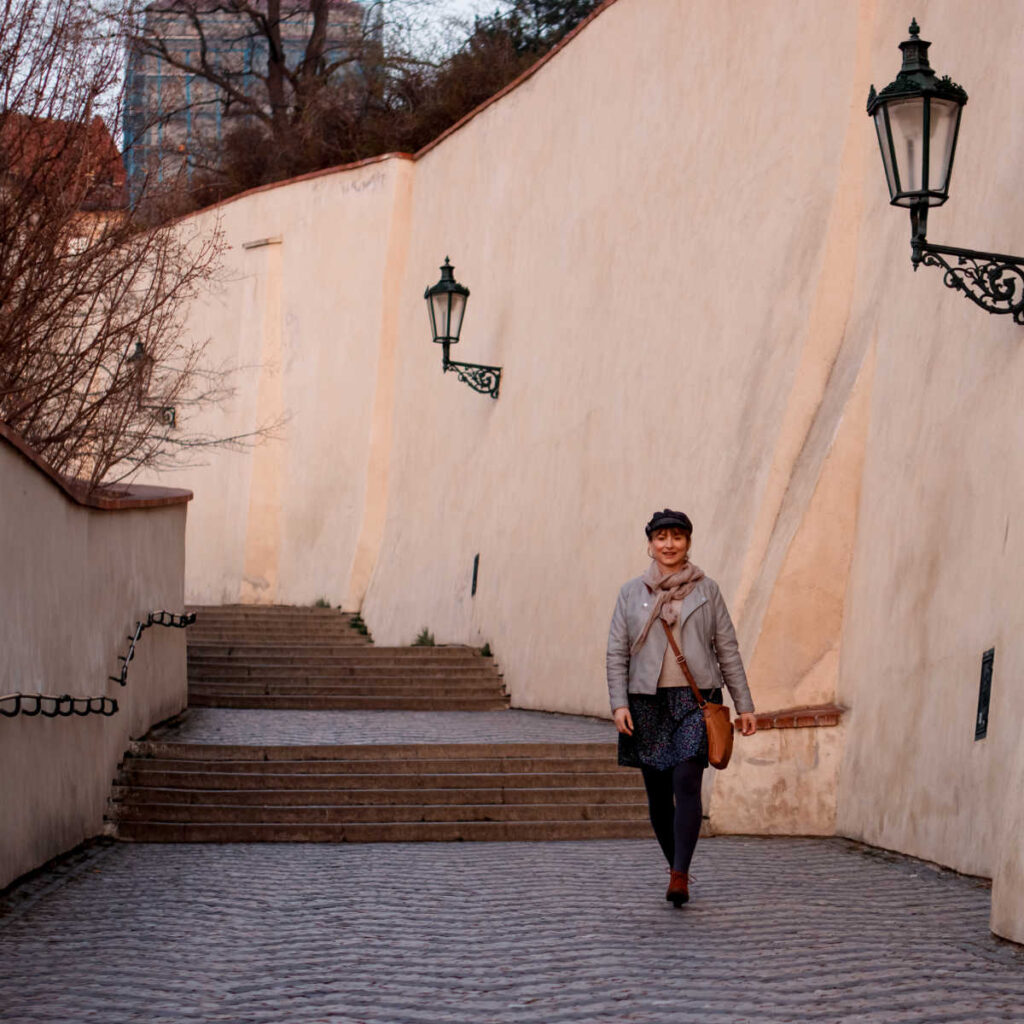
Is Prague easy to walk around ? Is it flat or hilly?
The centre of Prague such as the Old Town Square, the quirky streets and squares around it, Jewish Quarter are fairly flat and easy to walk around. It’s also very easy to walk across the Charles Bridge and walk around Kampa Island and the lower part of Lesser Town.
But, the other main attraction – the Prague Castle is on top of a steep hill. The good news is that you can take a tram 22 or the historic Prague tram no 42 up to the top of the hill and walk down afterwards.
If you have more than just a few days in Prague, you might like to explore other parts of Prague and some are again on other hills – these include the famous Petrin Lookout Tower, the large Letna Park, the trendy area of Zizkov district or Vinohrady or the Vysehrad Castle area . Whilst you can walk to all of these places from the centre of Prague (they would be a good 45-60 minutes walk) you can also hop on public transport and get directly there and then walk back to the centre of Prague.

Best places in Prague for flat level walking
If you want to keep level and don’t want to do a lot of hill climbing, then the centre of Prague is the best place to start. You can walk around the Old Town Square, Jewish Quarter, the streets around the Kings route, the beautiful Charles Bridge and Kampa Island with green park and streets around it.
You can also walk around the Vltava River, which has various points of interest on both banks, including the islands in the middle. You can start the loop around the river anywhere, but if you start from Old Town Square walk towards the Jewish Quarter and then turn into Dvorakovo Nabrezi.
This will take you through a lovely park and you get a great view of Prague Castle. Cross the river on Manesuv Most – Manes Bridge (one of the many historic bridges over Vltava River) and continue walking towards the Kampa Island (you can get some amazing photos of Charles Bridge from there).
You can walk all the way to Smichov along the river or cross the river at Most Legii (Legionaries Bridge) to see the Shooter’s Island , National Theatre and then walk on the other side of the river to the modern building called the Dancing House and even further to Smichov Naplavka where you can visit the popular farmer’s market on Saturdays. And of course you can zig zag through Charles Bridge at any point and change the walk to suit you.
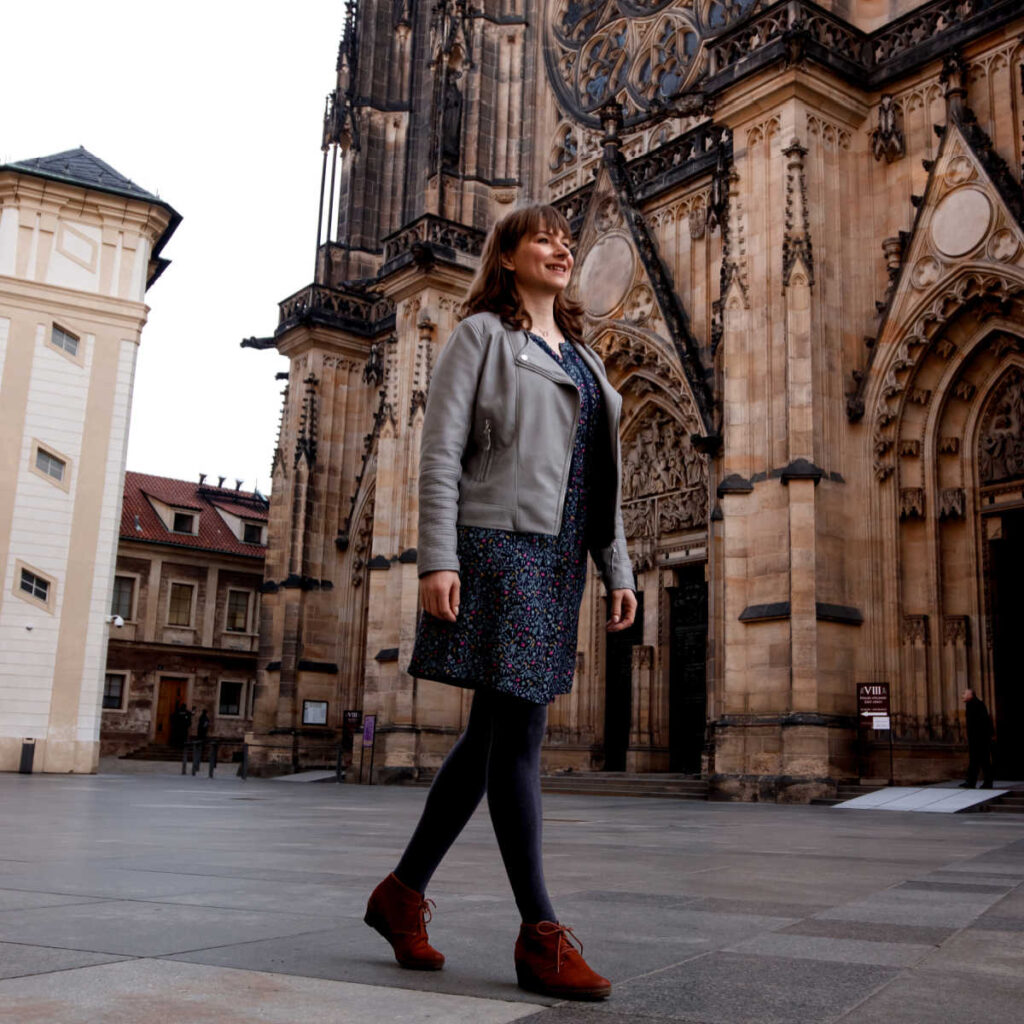
Pedestrianised areas of Prague
The centre of Prague doesn’t have much public transport on the surface (e.g trams tend to go around the centre and there are no buses) and only few underground stops (Staromestska, Namesti Republiky, Mustek).
- Old Town Square – and some streets around such as Celetna Street
- The Kings route through Old Town Square to Charles Bridge
- Charles Bridge (no bikes, scooters allowed)
- Prague Castle Grounds
- Na Prikope Promenade (from Wenceslas Square to Municipal House at Peace Square)
- Wenceslas Square (part of)
A lot of narrow streets in the Old Town look like they are for pedestrians only (because they are so narrow or small), but cars are allowed in, so you still need to watch out for traffic.
How to orientate yourself in Prague
I know that a lot of people would use google maps on their phone, but a good guidebook with real map is also useful if you run out of battery or don’t want to use your phone data.
I also use the Czech version of google maps called Mapy.Cz which you can download on Google Play and it’s available for both android and apple users. The benefit of the mapy.cz is that once you have it as an app on your phone, it works even if you don’t have a signal or don’t have your data switched on.
There is also fairly good signage on streets in main areas to take you to the most visited tourist attractions. You can also find displayed local maps, especially as you walk into the underground stations.
What walking shoes are best for walking in Prague?
Prague has a lot of cobbled stones, stone paved pavements and old quirky streets, which are quite hard to walk on. The streets and some older pavements are also not perfectly straight and level, so if you don’t have comfortable padded shoes, you can feel every little stone as you walk.
Because of that, I’d really recommend packing good quality trainers or soft padded shoes with enclosed toes for walking during the day and keeping strappy sandals or pretty high heels for the evening if you want to go out to a restaurant, theatre or club.
I found that soft padded trainers are the best for me, rather than actual walking shoes which can be quite hard to walk on and I keep them for my hiking trails in the Czech countryside.
My favourite walking routes in central Prague
These routes are not marked in any way, but make a great walks through a lot of historic places, parks and they really give you the chance to experience the city in a different way. There are of course many walking routes outside the centre of Prague, but the ones I’m mentioning here are accessible straight from the Old Town Square or by riding a few stops on a tram.
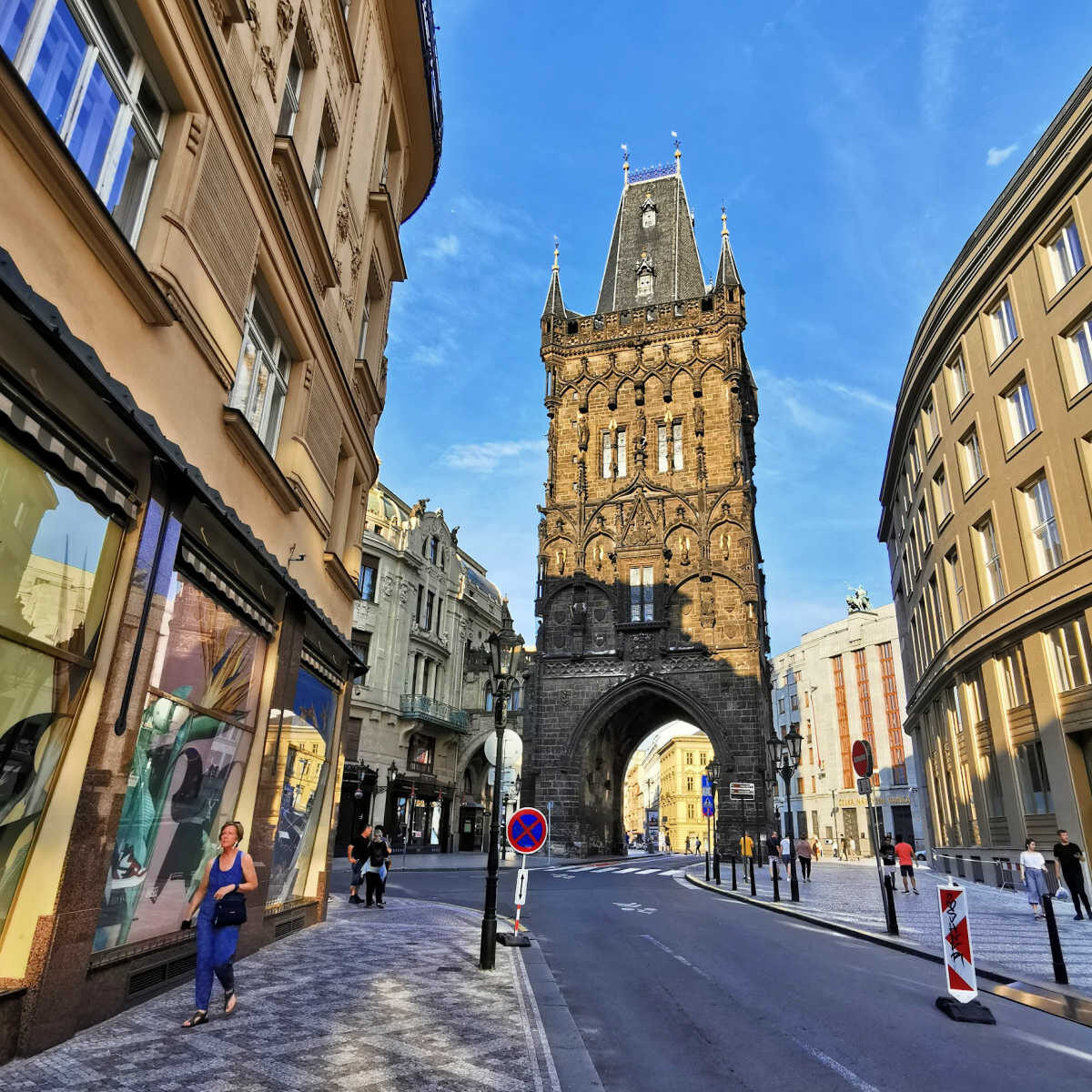
Walking the king’s coronation route to Prague Castle (3 km – 45 minutes)
If you want to have a good hike up Prague Castle and experience history first-hand, then the best way is to take the route that was taken by all kings on their coronation day. It starts next to the historic Powder Gate , which used to be next to the original Prague castle where the king would start the procession from.
The route will take you through the Old Town Square, Small Square and then through streets Jilska and Husova to Karlova Street taking you directly to the famous Charles Bridge . Once you are on the other side of the river, continue through Mostecka Street to Malostranske Namesti and up by the side of the St. Nicholas Church into Nerudova Street. Once you reach the top, turn right into the street ‘Ke Hradu’ which will take you to the main entrance to the castle grounds.
This is quite amazing route that will take you through the historic centre of Prague, where practically every house has its own history and it’s interesting to look at and you can also stop at many of the coffee shops and restaurants along the way.
This walk is about 3 km long, but most of it is up the hill, so it can easily take 45-50 minutes. If you want to walk slowly to admire the views or stop somewhere on the way, plan 1-2 hrs for your walk, so it doesn’t feel rushed.
If you like the idea of this walk, but don’t fancy the steep climb to the castle, you can also take this route down from the castle after you take the Prague Castle Tour (using the first option to get there using a tram 22 to get to the Prazsky Hrad stop).
- How to get to Prague Castle – by public transport, walking or getting taxi >>
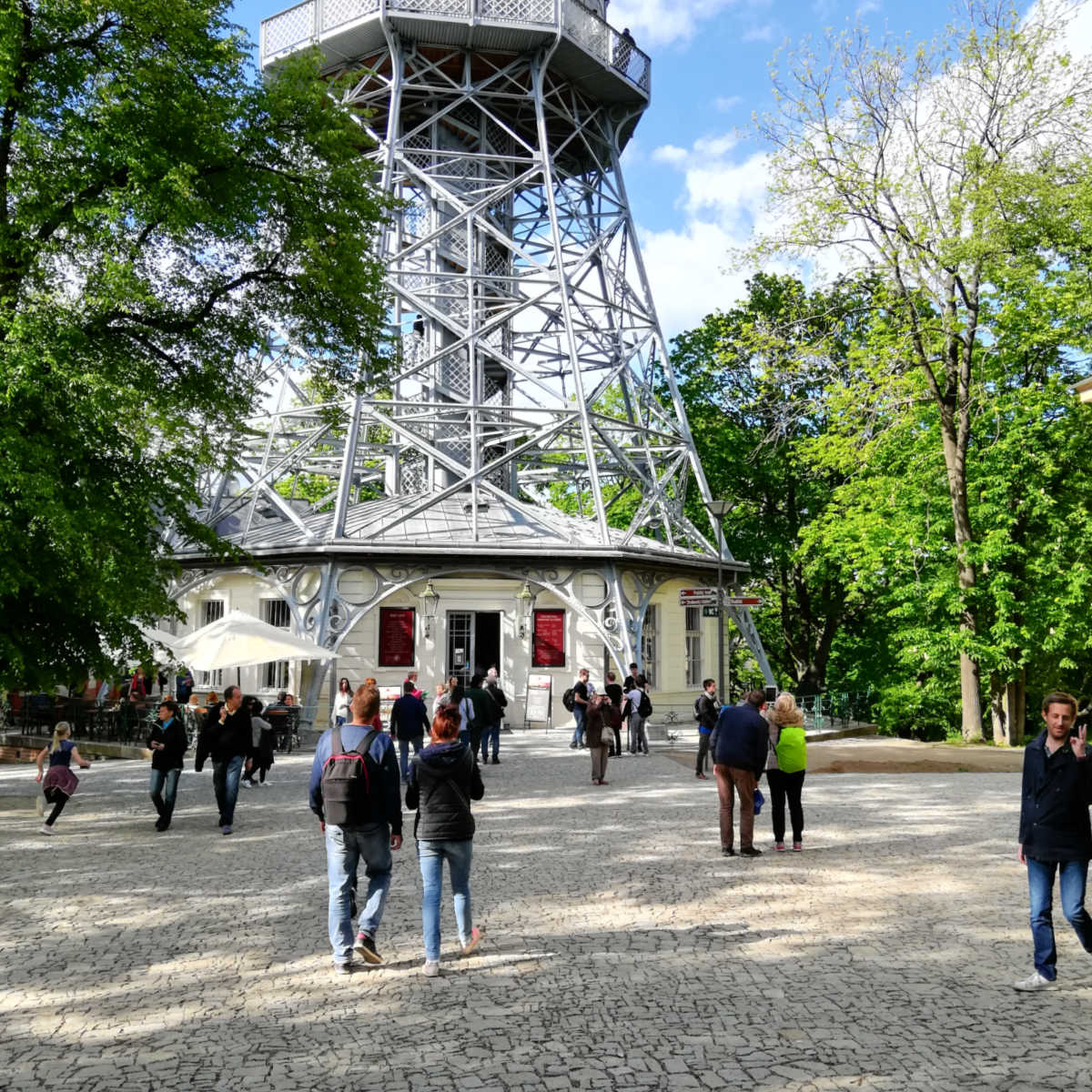
Petrin Hill Walk (2-3 km 30-45 minutes)
This is my favourite way to walk to Prague Castle from my flat in Prague without using any public transport.
You can start at Svandovo Divadlo tram stop (close to Ujezd on tram no. 9, 15, 12, 20) and walk first towards the Kinsky Chateau (now the National Folk Museum with a rather lovely cafe and ice-cream place).
Take any of the paths up the hill and walk through the Kinsky Garden and the historic Hunger Wall into the Petrin gardens until you reach the park around the tall Petrin Lookout Tower . If you didn’t want to walk up the steep hill, take the Petrin Funicular from Ujezd to the top of the hill. Carry on walking next to the Hunger Wall to Strahov Monastery and then either down through the park and streets to the Lesser Town Square or continue onto the Prague Castle.
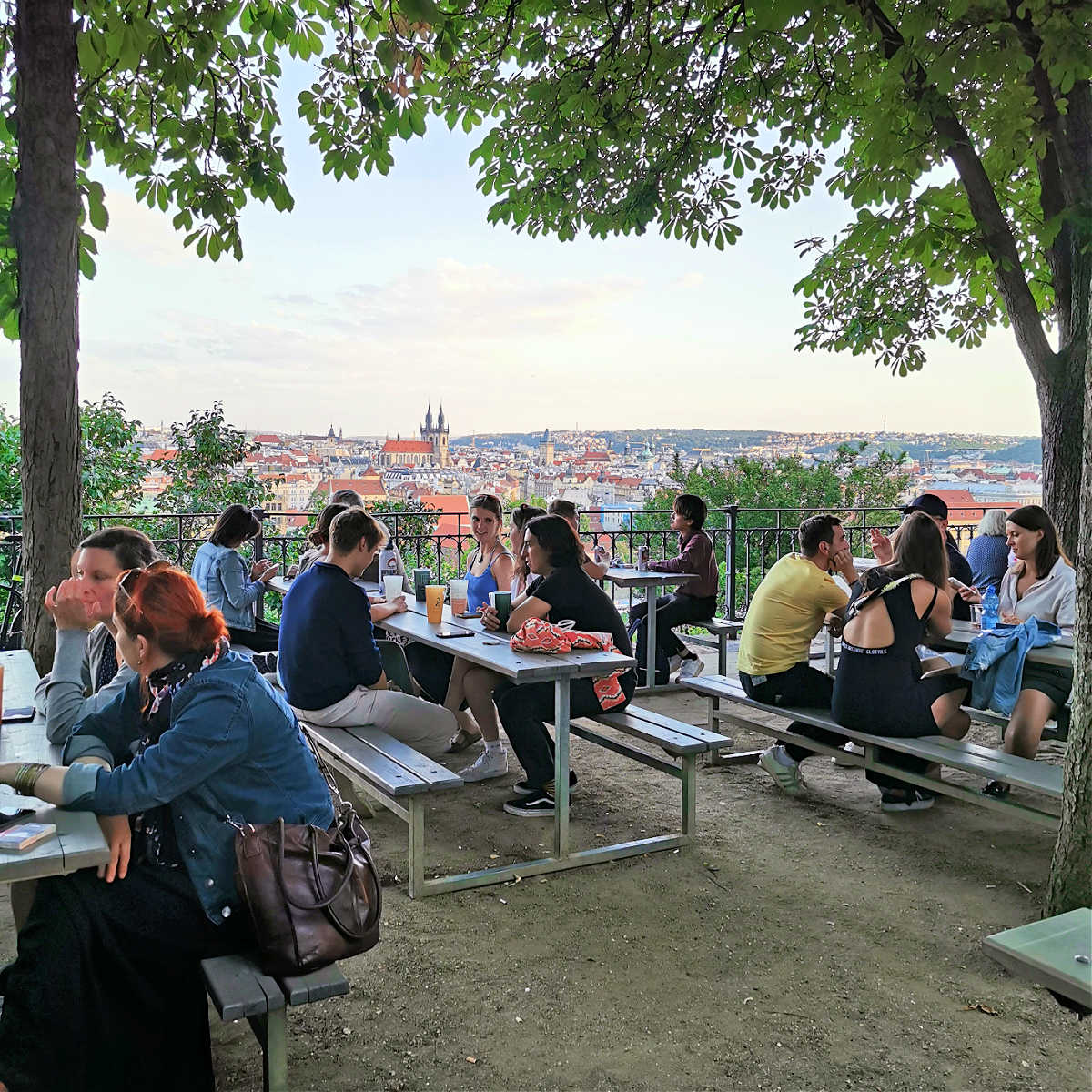
Letna Hill Walk (3-4 km – 45-60 min)
As you walk on the Petrin hill, you can see the next hill stretching behind the Prague Castle. You can either get to it from the Prague Castle or you can travel first to the Letenske Namesti (tram no. 12 from Malostranska or Malostranske Namesti – Lesser Town).
Follow the signs to the Technical Museum or Agricultural Musem and then carry on walking through the large Letna Park, stopping at the popular Letna Beer Garden for some refreshments. You can get some lovely views of most of the famous Prague Bridges over Vltava River from the Hannau Pavilion (also cafe & restaurant) and then continue to Chotkovy Sady (Chotek Park), Bilek Villa (house of a famous sculpturer) and through the Royal Garden to the Prague Castle.
- The complete guide to visiting Letna Park – What to see and do >>
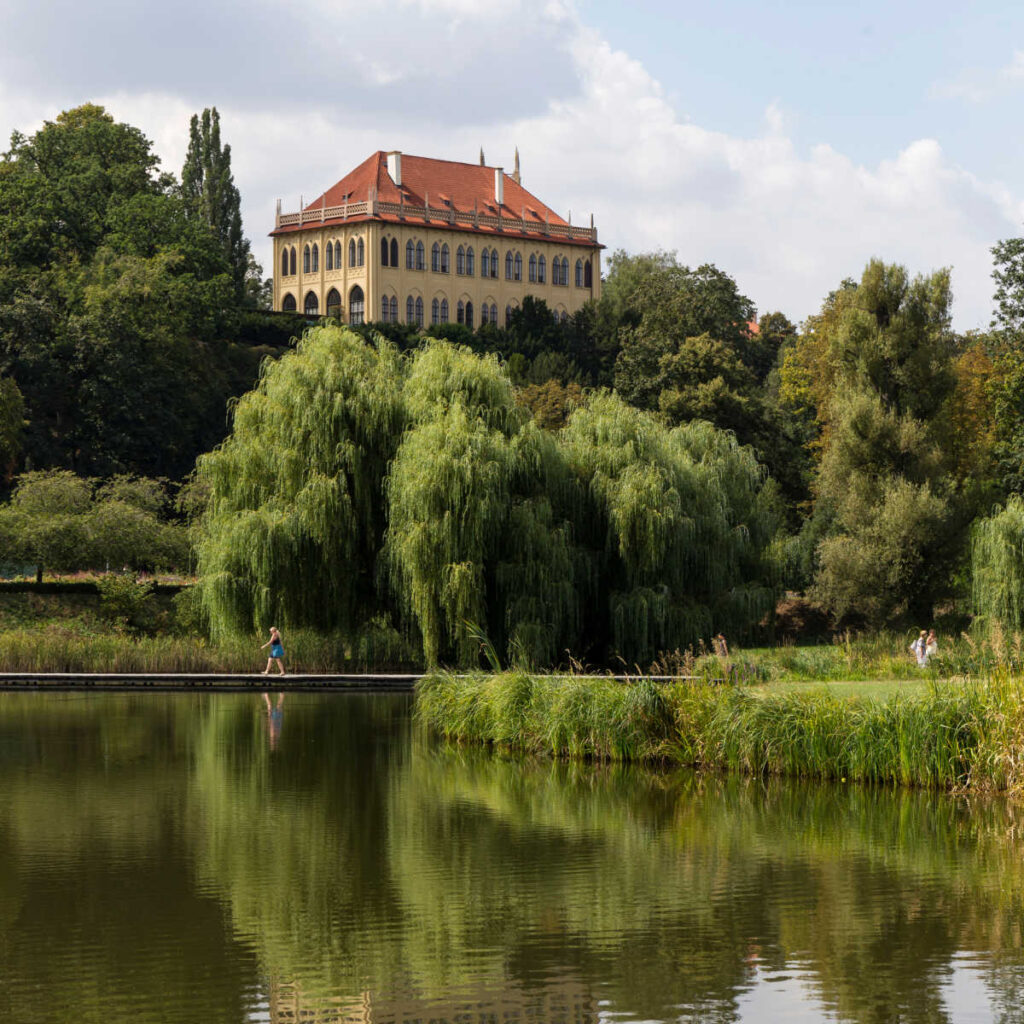
Stromovka to Troja Walk (3km – 45 minutes)
This is a really lovely walk through a large Stromovka Park and Vltava islands and river banks. It’s a flat level walk until you get to the popular Prague Zoo – if you want to continue to the Botanical Garden then you need to add extra 20-30 minutes and a steep hike at the end.
Take any tram to the stop Vystaviste (no. 12, 17 etc) Exhibition Palace & Grounds and walk through the Stromovka Park following the signs to Prague ZOO. You’ll cross a river canal and then Vltava River itself and you’ll arrive at Troja Castle (now Art Gallery).
Prague Zoo entrance is just another 5 minutes walk and the Botanical Garden and Fata Morgana Greenhouse are further up the steep hill. You can return back to the centre by frequent bus from the front of the ZOO.
- What to see in Stromovka Park – The visitor’s guide to attractions >>
- The Guide to Botanical Gardens in Prague >>
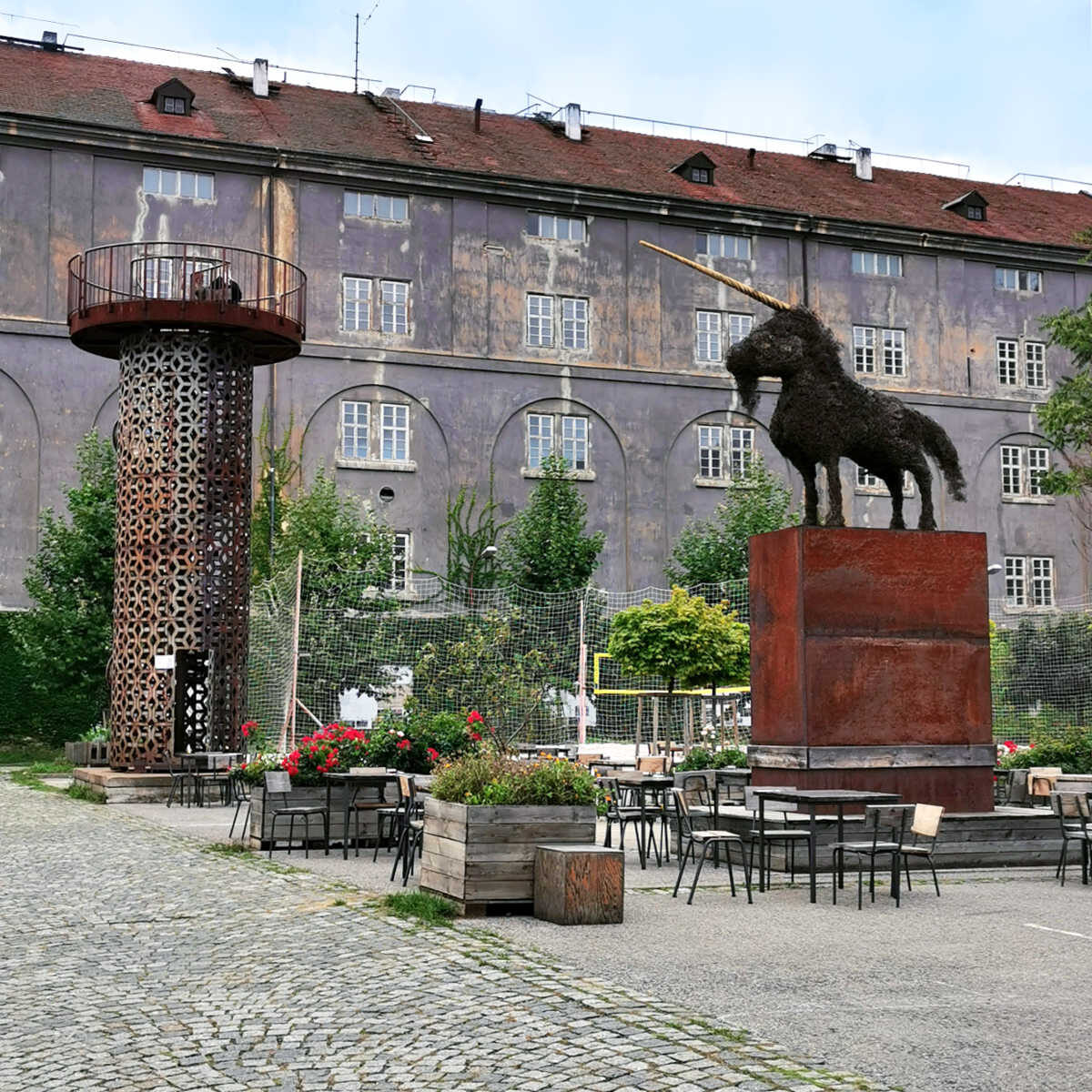
Karlin to Holesovice Walk
This walk will take you over the newly opened pedestrian bridge over the Vltava river. It connects Karlin with Holesovice district in the spot where the entrance to the Holesovice Market is.
You can start from Florenc – Underground Station (line B) or tram (or walk there from the Peace Square via Na Porici street and follow the main street towards Karlin. You can make a detour by exploring the Karlin Army Barracks, Karlin Main Square with the beautiful church and the pretty streets around.
The new pedestrian bridge over the river Vltava is tucked behind the new residential buildings opposite the main Karlin Square. Once you walk across you’ll see the entrance to the Holesovice Market with different shops, cafes, outdoor street food tracks and art galleries.
You can carry on exploring the Holesovice district by having a coffee (or a lunch) in Vnitroblok (amazing inner houses space with cafe, art gallery and artist workshops) and walk to the Marina to see the newer houses developed within the old boat yards. At any point you can take tram back to the Prague centre or continue walking towards the Exhibition Ground and Stromovka Park.
This blog post was originally written on 18 October 2023 and last updated on 18 October 2023
PIN FOR LATER
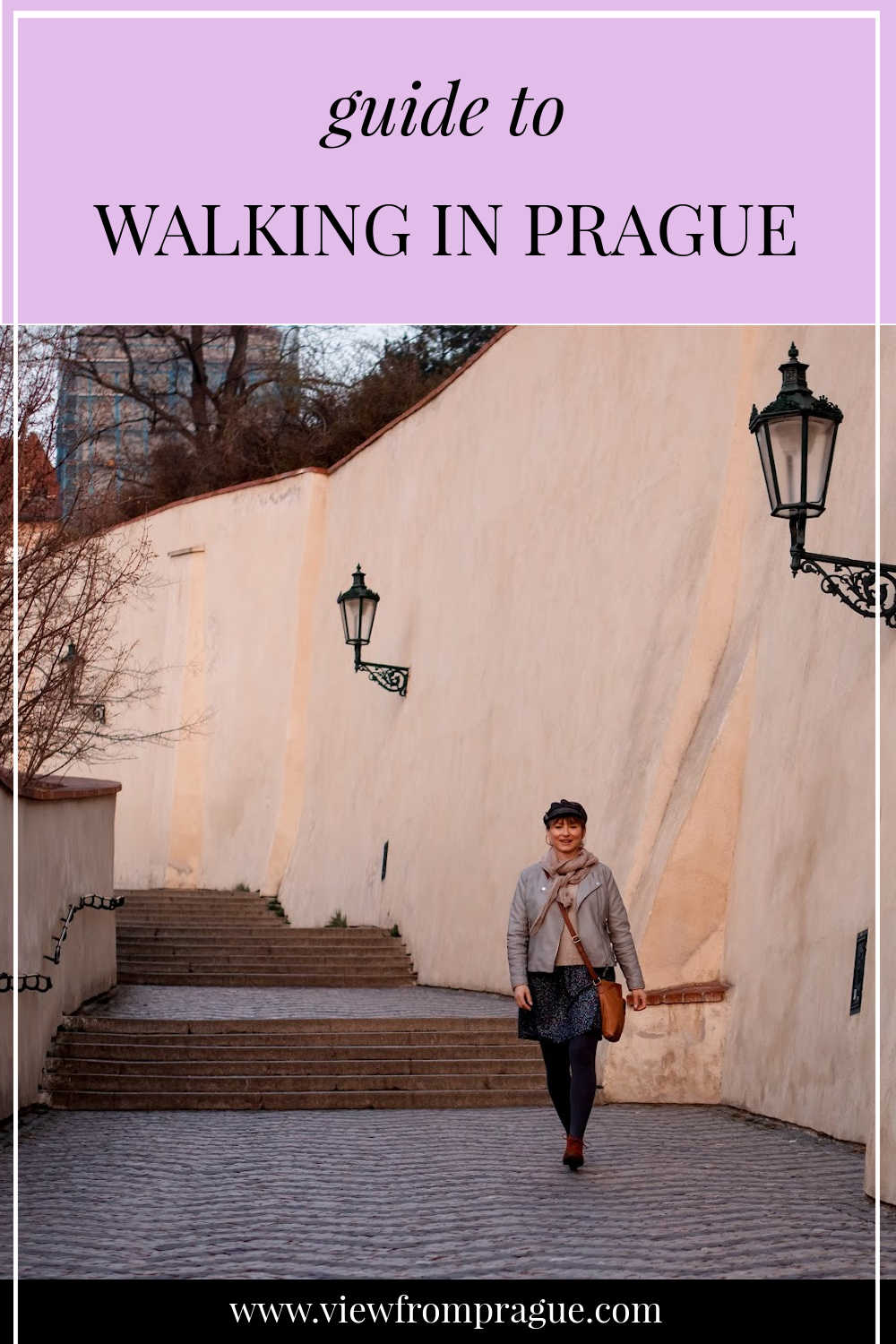
My name is Magdalena Marsden (nee Jandakova) and I'm a native Czech living in Prague. I started 'View from Prague' blog in January 2019 to share my love for this beautiful city and for traveling and hiking around Czech Republic. I want to show you that you can enjoy Prague in an easy-going, non-touristy kind of way. I've put together practical travel guides, places to visit and plenty of tips for making the most of your time in Prague. Whether you're planning your first trip or you're a seasoned traveller, I hope you'll find something here to inspire you.
Discover Prague

Prague Historic Tram 42 Route – Comprehensive Travel Guide for 2024
Prague historic tram no 42 route comprehensive tourist travel guide for 2024, including tickets, prices, practical info and off-the-beaten-track places to visit,…

Prague Metro – Underground Travel Guide 2024
Prague underground, which Czech people call the ‘Metro’ has only three lines – Line A, B, C and it’s a quick and…

Prague Metro Sightseeing & History Guide by a Local

Getting from Vaclav Havel airport to Prague centre (2024) – Guide by a local
A comprehensive guide on how to get from Vaclav Havel airport to Prague centre in 2024 by public transport, direct bus, taxi…
Buying a train ticket in the Czech Republic – Comprehensive guide & Discounts (2024)
My comprehensive guide to buying a train ticket in Czech Republic, including how to get train ticket discounts and best ways to…
Prague Main Train station – Practical guide, facilities & history (2024)
Practical guide to Prague Main Train station, inc. travel information, train connections, facilities, how to buy tickets and the train station history….

Walking Tours
If you wish to get to know Prague better, Prague Walking Tours are just the right thing to do. Join some of the free tour guides which work just on a tips basis, or purchase tickets for longer tours with licenced guides. Free tours have no fixed ticket price. You are “free” to decide yourself how much you liked the tour and how much it was worth for you. Paid tours mostly operate in small groups and are more tailored to the specific needs of each group, while free tours tend to be crowded and less personal.
The Malá Strana Walk
Prague castle walk, walk around petřín, along the vltava to vyšehrad, vyšehrad walk, the royal route walk, ghosts and legends in prague, charles bridge to old town square walk, old town square to municipal house walk, jewish quarter walk, introductory walk of prague, vyšehrad tour.

IMAGES
COMMENTS
Explore Prague on this ultimate self-guided walking tour! With a map and walking directions. Includes highlights, overlooked gems, and lesser-known Prague facts!
Unlike other European cities, Prague is easily explored by walking, and you can walk from one end of the city to the other easily in one day! Whether you're a first-time visitor or a seasoned traveller, our self-guided tour will take you on a journey through some of the city's most iconic landmarks, hidden gems, and local hotspots.
Self-guided walking tours in Prague, Czech Republic. Follow these 13 expert designed self-guided walking tours to explore the city on foot at your own pace.
This post lists the best things to do in Old Town, Prague, in the form of a self-guided tour. There are museums, monuments, and other attractions included.
Prague is a gorgeous city and with so much to see, it can become overwhelming. This guide focuses on the top touristic neighborhoods to see first for old world charm and architectural bliss: Malá Strana (Lesser Town), Old Town (Staré Město), Malá Strana (Lesser Town), and Hradčany (Prague Castle). All can be done on your own at a leisurely pace in two to three days.
The free tour takes you through the city's major landmarks, public buildings, cultural venues, and places of worship. This walking tour covers approximately 8-9 km of distance. You can easily make it your one-day Prague itinerary depending on when you start, your pace, and how long you stay in each location.
Our FREE Prague Walking Tour map centers on Old Town Square (Stare Mesto) and covers the heart of town. This do it yourself guided Prague Old Town walking tour map covers the best sights from Tyn Church and Astronomical Clock to the iconic houses and Medieval watchtowers.
One of my favourite parts of Prague was Malá Strana, or "Lesser Quarter". Mala Strana itself is divided between the lower and upper halves of the hill. The upper half consists of Prague Castle, which is where the majority of tourists flock, with good reason, but the rest of Lower Town has a more subdued vibe. With less big-ticket attractions, you'll find that there are slightly fewer tourists ...
Enjoy the Self-Guided Walking Tour of Old Town Prague with a package that includes personalized quest tours for 1-3 people, interactive challenges, and historical landmarks, all designed for a unique and engaging exploration of the city's rich history and culture.
And yet while Prague may look like a small town riddled with tales to span centuries, the city of Prague is sprawling with many different neighbourhoods offering their own unique flair. Here's how to discover the best of Prague in a self guided Prague walking guide.
Prague's Jewish Quarter, Your Self-Guided Walking Tour of the Best Things to See and Do in Josefov [UPDATED 2023] on September 3, 2019
A DIY Prague Sculpture Walk: Get beyond Prague's most popular tourist sites with this one-day, self-guided walking tour…with a twist. Experience a stranger side of Prague and visit 12 of Prague's most head-scratching, fascinating, and moving sculptures.
There are 4 types of tours available in Prague, including the Old Town + the Jewish Quarter, Prague Castle, New Town, and one for WW2 and Communism.
Like a tapestry woven with threads of history and art, Prague Castle beckons visitors to explore its grandeur on a self-guided walking tour.
Known as the "Golden City of 100 Spires," Prague boasts a fairytale medieval Old Town, historic churches and synagogues, and perhaps Europe's largest castle. A good way to introduce yourself to the city, its layered past, and its resilient people is with a walk across town, starting on lively, urban Wenceslas Square, weaving through the atmospheric Old Town, and ending at the picturesque ...
Explore the city center of Prague on a self-guided tour via WhatsApp on your smartphone. Discover the highlights and the hidden gems of the city at your own pace.
Explore Prague's rich history, embrace its vibrant present, and be delighted by its captivating legends and stories. Whether you're embarking on a solo adventure, enjoying a romantic city stroll with your partner or exploring the city with friends or family, our self-guided audio tour caters to all preferences.
Find the best Free Walking Tours in Prague with Local Guides and give what you want at the end of the visit! Ready for fun? 👉 Book online for free!
The following walking tour will take you to some of Prague's absolutely unmissable attractions - including a few that you can taste.
Experience the best of Prague on three different free walking tours in English and Spanish. Discover the Old Town, Charles Bridge & Prague Castle or the historical New Town with professional local guides!
Free guided tours in Prague, Czech cuisine crawls and more. Exploring the Czech capital doesn't get more captivating than these walking tours we've curated at Discover Walks. With over 100,000 walking tours a year, we know Prague better than most, and showing the city's hidden gems to travelers from around the world is what we do best.
Everything you need to know about walking in Prague, including practical walking tips and 5 easy walking routes from the centre as recommended by a local.
Vyšehrad offers visitors to Prague a pleasant, relaxed walk lasting about two to three hours. Even though it is situated close to the city centre,…. Prague Walking Tours are amongst of Best City Tours available in Prague. Most of listed walks are self-Guided Tours.
If you are very short on time or simply don't want to deal with the hassle of a self-guided Salzburg walking tour, you can also opt to take a guided tour instead. Salzburg 2.5-Hour Walking Tour: Embark on a guided walking tour of Salzburg and discover the city's rich history, stunning architecture, and musical heritage.